Guide to the ADA Standards
About this Guide
This guide explains requirements in the current editions of the ADA Standards issued by the Department of Justice (DOJ) and the Department of Transportation (DOT). It was developed by the U.S. Access Board in cooperation with DOJ and DOT. It is important to use this guide along with a complete copy of the ADA Standards as it explains, but does not contain or reprint, the text of the ADA Standards.
DOJ updated its ADA Standards in 2010, which are referred to as the 2010 ADA Standards for Accessible Design. These standards, which replace the original ADA Standards DOJ issued in 1991, became mandatory for newly constructed and altered facilities as of March 15, 2012. DOJ’s ADA Standards apply to all facilities covered by the ADA except public transit facilities.
DOT issued its current edition of the ADA Standards in 2006. These standards apply to facilities used by state and local governments to provide public transportation. They became effective on November 29, 2006 and replace earlier standards issued by DOT in 1991.
The current DOJ and DOT ADA Standards are very similar as both documents are closely based on the Access Board’s ADA Accessibility Guidelines (2004). This guide explains requirements of both standards, which are jointly referred to as the “ADA Standards” or “the standards.” Most provisions of each standard are identical and discussed in this guide without distinction. Both standards contain several unique provisions not found in the other. In these limited areas, the guide notes the differences and explains how they are to be applied. This guide does not cover requirements of the original 1991 ADA Standards issued by DOJ or DOT.
In addition to explaining the requirements of the standards, this guide also provides clearly labeled recommendations for best practices that exceed the minimum requirements and are thus optional to follow. In addition, the guide provides links to other federal accessibility requirements that may also apply to entities covered by the ADA.
This guide is in the public domain, and users are free to distribute and share its content or to disseminate copies. Questions or comments on the guide should be directed to the Access Board at ta@access-board.gov , (800) 872-2253 (voice), or (800) 993-2822 (TTY).
Using the ADA Standards

The design standards issued under the Americans with Disabilities Act (ADA) by the Department of Justice and the Department of Transportation are used to ensure access to the built environment for people with disabilities. The ADA Standards apply nationwide, in addition to any applicable state or local codes, where facilities are newly built or altered. Most facilities in the public and private sectors are covered by the ADA.
State and Local Government Facilities

Units of government at the state, county, and local levels are subject to the ADA and must comply with the ADA Standards in new construction and alterations. All types of public facilities are covered, including schools, hospitals, public housing, courthouses, and prisons. Federal facilities are not covered by the ADA, but by an earlier law, the Architectural Barriers Act (ABA) and must meet separate, though very similar, standards.
Places of Public Accommodation and Commercial Facilities

In the private sector, the ADA Standards apply to places of public accommodation and commercial facilities. Places of public accommodation are facilities that affect commerce and that fall within twelve categories listed in the statute, including stores and shops, restaurants and bars, sales or rental establishments, service establishments, theaters, places of lodging, recreation facilities, assembly areas, private museums, places of education, and others. Nearly all types of private businesses that serve the public are included in the twelve categories, regardless of size. Commercial facilities include office buildings, factories, warehouses, manufacturing plants, and other facilities whose operations affect commerce.
Transportation Facilities

Bus stops and stations, rail stations, and other transportation facilities are required to be accessible by the ADA. The ADA also establishes standards for transportation vehicles, including buses, vans, and rail cars (which are not discussed in this guide).
Exemptions (Religious Entities and Private Clubs)
The ADA does not apply to religious organizations and private clubs, entities which historically have been exempt from federal civil rights laws. Places of worship and other facilities controlled by a religious organization, such as a school or day care center, are not subject to the ADA Standards. Private clubs may be similarly exempt depending on their exclusiveness, operations, and other factors. Facilities not subject to the ADA Standards may still be subject to state or local access codes.
ADA Coverage of Housing
Although private residential housing is not covered by the ADA, government-owned or operated housing and certain privately owned facilities that provide housing are subject to the ADA and its accessibility requirements. Government owned or operated facilities may include public housing, student and faculty housing, employee housing, nursing homes, temporary housing provided in emergencies, and social service facilities, such as homeless shelters and halfway houses.
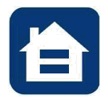
In the private sector, the ADA’s coverage of housing is limited to places of public accommodation, such as social service establishments and housing provided on or behalf a place of education. The ADA does not apply to individually owned or leased housing in the private sector not used as a public accommodation, including single family homes, condominiums, or apartments. (Many types of multi-family housing in the private and public sectors are subject to the design requirements of the Fair Housing Act.) Places of public accommodation located in residential buildings, such as rental and sales offices, commercial spaces, and hotel accommodations, are covered by the ADA Standards. Information on the Fair Housing Act is available from the Department of Housing and Urban Development at http://www.hud.gov/ or http://www.fairhousingfirst.org/,(888) 341-7781 (V/TTY).
ADA Regulations
Regulations issued by DOJ and DOT to implement the ADA provide important information and instructions on using the ADA Standards. The regulations define the types of facilities covered, set effective dates, and provide additional detail on certain provisions in the standards. They also address existing facilities and topics beyond building design, including access to programs, services, and communication and provision of auxiliary aids and services.
DOJ’s ADA Regulations

DOJ regulations issued under title II of the ADA apply to programs, activities, and services of state and local governments. DOJ’s title III regulations apply to public accommodations and commercial facilities. Both regulations contain general nondiscrimination provisions and address access to programs and services, effective communication, auxiliary aids and services, and reasonable modifications of policies, practices, and procedures. Under the title II regulation, state and local governments must provide program accessibility in existing facilities, and the under the title III regulation public accommodations must remove architectural barriers in existing facilities where it is “readily achievable.” In addition, both regulations specify the accessibility standards applicable to new construction and alterations, and to the provision of program access or barrier removal.

Title II Regulation for State and Local Governments
28 CFR Part 35
Available at http://www.ada.gov/

Title III Regulation for Places of Public Accommodation and Commercial Facilities
28 CFR Part 36
Available at http://www.ada.gov/
DOT’s ADA Regulations
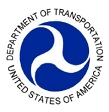
DOT’s ADA regulations implement the transportation and related provisions of titles II and III of the ADA. They apply to any public entity that provides public transportation or intercity or commuter rail transportation, as well as to any private entity that provides public transportation or that is not primarily engaged in the business of transporting people but operates a demand responsive or fixed route system. They cover both vehicles and facilities and include nondiscrimination requirements associated with the provision of transportation services.

DOT Regulation for Transportation Services
49 CFR Part 37
Available at http://www.fta.dot.gov/civilrights/12325.html
ADA Accessibility Standards
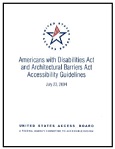
DOJ’s and DOT’s ADA Standards are based on the Board’s ADA Accessibility Guidelines (2004).
Both DOJ’s and DOT’s ADA Standards are based on minimum accessibility guidelines adopted by the Access Board in 2004, known as the ADA Accessibility Guidelines. As a result, these two sets of standards are very similar for the most part. However, each contains additional requirements that are specific to the facilities covered by the respective agencies.
DOJ’s 2010 ADA Standards for Accessible Design
DOJ’s 2010 ADA Standards for Accessible Design became effective March 15, 2012 and apply to all facilities covered by the ADA except public transit facilities. This includes state and local government facilities subject to title II and places of public accommodation and commercial facilities under title III.
As implemented under title II, the 2010 Standards consist of the regulatory provisions in 28 CFR §35.151 and appropriate sections of the Access Board’s 2004 ADA Accessibility Guidelines (36 CFR part 1191, appendices B and D).
For title III of the ADA, the 2010 Standards consist of both the regulatory provisions in 28 CFR part 36, subpart D, and appropriate sections of the Access Board’s 2004 ADA Accessibility Guidelines (36 CFR part 1191, appendices B and D).
DOJ’s 2010 ADA Standards are available on DOJ’s ADA website at http://www.ada.gov/.
DOJ’s 2010 Standards include provisions not included in DOT’s standards that supplement or modify requirements related to scoping for:
-
assembly areas (§221)
-
medical care facilities (§223)
-
transient lodging, including housing at places of education (§224)
-
detention and correctional facilities (§232)
-
social service establishments (§233)
-
housing provided by state or local governments for sale to individual owners (§233).
DOT’s ADA Standards (2006)
DOT’s ADA Standards apply to facilities used by state and local governments to provide designated public transportation and to commuter and intercity rail stations. The current edition of the standards applies to new construction and alterations undertaken after November 29, 2006. These standards are very similar to DOJ’s 2010 Standards but include unique provisions concerning:
-
accessible route location (§206.3)
-
detectable warnings on curb ramps (§406.8)
-
bus boarding and alighting areas (§810.2.2)
-
rail station platform (§810.5.3).
How the ADA Standards are Enforced
DOJ’s and DOT’s ADA Standards are not a building code, nor are they enforced like one. They constitute design and construction requirements issued under a civil rights law. The ADA’s mandates, including the accessibility standards, are enforced through investigations of complaints filed with federal agencies, or through litigation brought by private individuals or the federal government. There is no plan review or permitting process under the ADA. Nor are building departments required or authorized by the ADA to enforce the ADA Standards (some building departments even include a disclaimer on their plan checks indicating that ADA compliance is not part of their approval process). Entities covered by the law ultimately are responsible for ensuring compliance with the ADA Standards in new construction and alterations.
State and Local Access Codes
Building design and construction, including safety and accessibility, is largely regulated and enforced by states and local jurisdictions. The ADA does not intrude upon the authority these governmental entities have traditionally exercised over the built environment. Most states and many local jurisdictions have laws or ordinances that address access to the built environment. Several states have their own accessibility codes, while others have implemented requirements based on those of the ADA or adopted access provisions contained in model building codes. The ADA Standards apply nationally in addition to any applicable state or local access requirements or codes. An occupancy permit issued by a local jurisdiction (or a building inspection) does not ensure ADA compliance. Although local building departments sometimes can waive building code requirements, a local waiver does not affect the entity’s obligation to comply with the ADA Standards.
State or Local Code Certification
The ADA sets up a voluntary process through which a state code can be certified by DOJ as meeting or exceeding the ADA Standards that apply to public accommodations and commercial facilities. Certification facilitates compliance by ensuring that state and local code requirements are consistent with the ADA accessible design requirements. This process, in effect, integrates the requirements for accessible design under the ADA into state or local code enforcement processes. Under a certified code, design errors are more likely to be caught and remedied before construction. Also, having a DOJ-certified code offers rebuttable evidence of compliance with title III of the ADA in response to a legal challenge under the law concerning accessible facility construction. Information on ADA state code certification is available from DOJ and its website at www.ada.gov/certcode.htm. DOT does not certify codes as compliant with its ADA Standards for transportation facilities.
Model Building Codes and Industry Standards
The Access Board’s 2004 ADA Accessibility Guidelines, upon which the current ADA Standards are based, have been harmonized to a significant extent with industry standards and model building codes, including the International Building Code (IBC). The IBC contains application and scoping provisions for accessibility (in chapters 10, 11 and 34) that correspond to those in the ADA guidelines (chapters 1 and 2). For technical provisions, the IBC references a consensus standard developed through the American National Standards Institute (the ANSI A117.1 standard), which is highly consistent with the technical chapters (3-10) of the ADA guidelines. There are some substantive differences. For example, unlike the ADA guidelines, the ANSI standards require an additional vertical grab bar at water closets, transfer shower stalls, and tubs. Detailed comparisons between the 2004 ADA guidelines and the IBC/ANSI standard are available on the Access Board’s website and the International Code Council’s website at www.iccsafe.org.
The ADA Standards also reference several industry standards, including the American Society of Mechanical Engineers (ASME) elevator safety code and the National Fire Protection Association (NFPA) 72 Fire Alarm Code. In addition, the ADA Standards reference provisions in the IBC covering accessible means of egress.
Purpose [§101]
The ADA Standards apply to new construction, alterations, and additions. While the scoping and technical requirements for new construction also apply to alterations and additions, provisions and exceptions specific to alterations or additions are provided throughout the document.
Furnishings and Equipment
The DOJ and DOT ADA Standards, like most building requirements and codes, apply to those elements that are fixed or built-in. Moveable elements and furnishings are generally not addressed or covered by the ADA Standards. DOJ’s ADA regulations include requirements that may impact non-fixed elements, such as providing accessible medical equipment, including examination tables and chairs, to provide persons with disabilities effective access to health services. In addition, placement of non-fixed elements can affect the accessibility of an area by encroaching into accessible routes and clearances.
Recommendation: Design spaces so that planned furnishings and moveable elements are accommodated without encroaching into accessible routes and clearances. It is also helpful to consider relevant requirements in the standards when specifying or acquiring moveable furnishings, such as tables, systems furniture, and vending machines to ensure their usability.
Unless specifically permitted, access features required by the ADA Standards must be fixed or built-in even though portable alternatives may be available. This includes requirements for assistive listening systems, visual alarms, shower seats, ramps, and platform lifts. (In removing barriers to existing places of public accommodation, portable solutions may be permitted in some cases where permanent solutions are not readily achievable).
Maintenance of Accessible Features
The ADA Standards address the design, but not the maintenance, of building elements and features. However, it is important that accessible features be properly maintained in working order. DOJ’s and DOT’s regulations require that features of facilities and equipment required to be accessible be maintained in operable working condition, except for isolated or temporary interruptions in service due to maintenance or repairs.
Dimensions for Adults and Children [§102]
The ADA Standards provide technical specifications for building elements designed specifically for use by children 12 and younger. These provisions address access for children to:
-
drinking fountains (§602)
-
water closets and toilet compartments (§604)
-
lavatories and sinks (§606) and
-
dining and work surfaces (§902).
The ADA Standards also include requirements for play areas (§240 and §1008) and recommendations (advisory notes) with respect to children’s reach ranges (§301.1) and ramp handrails used primarily by children (§505.4).
The ADA Standards do not specify where or when elements are to be designed or constructed for use primarily by children. This determination is left to other building requirements or regulations, good practice, client preference, or other factors. The provisions covering elements designed for children’s use (other than those addressing play areas) are structured as exceptions to specifications based on adult dimensions. Once the decision is made to design certain elements based on children’s dimensions and to use the exceptions, the alternate specifications provided in the ADA Standards must be followed. The ADA Standards do not require provision of additional accessible elements in order to separately accommodate both children and adults, although doing so may be advisable in mixed use spaces. For example, in some restrooms at facilities such as schools and children’s museums, it may be a good idea to provide a wheelchair accessible toilet compartment for use by adults and another for use by children.
Equivalent Facilitation [§103]
The ADA Standards allow alternatives to specified requirements that provide substantially equivalent or greater accessibility and usability as an “equivalent facilitation.” The question of whether an alternative solution is “equivalent” involves considerations as to whether it is just as, if not more, effective in terms of accessibility, usability, convenience, and reliability for people with disabilities. For example, the ADA Standards specify permanent or built-in features for independent access. Unless otherwise specified, alternatives involving temporary or portable solutions or requiring assistance from others are not generally deemed equivalent to the required minimum level of access.
The provision of equivalent facilitation is intended to accommodate good faith innovations and technological advances not anticipated by the ADA Standards. It is not to be used as a means to resolve oversights in design or construction. Understanding the rationale for certain specifications is often helpful in determining whether an alternative is equivalent. For example, transfer shower stalls are required to be 36 inches by 36 inches absolute so that grab bars remain within reach from the seat. A wider transfer shower stall would not qualify as “equivalent facilitation” because it would make the grab bars less usable from the seat and less accessible to individuals with disabilities.
DOT’s ADA regulations (§37.9) detail the process, procedures and requirements for seeking a determination of equivalent facilitation for a public transportation facility subject to DOT’s ADA Standards. No departures from specific provisions of the DOT standards can be made without a determination issued by the Administrator of the relevant operating administration (e.g., the Federal Transit Administration, the Federal Railroad Administration, or the Federal Highway Administration) with the concurrence of the Assistant Secretary for Transportation Policy. Requests for official determinations of equivalent facilitation should be directed to the Federal Transit Administration.
DOJ’s ADA regulations do not establish a process for approving or certifying equivalent facilitation alternatives to requirements of DOJ’s ADA Standards. In the case of DOJ’s ADA Standards, the responsibility for demonstrating equivalent facilitation in the event of a legal challenge or complaint rests with the covered entity. In pursuing equivalent facilitation alternatives under DOJ’s ADA regulations, it is good practice to:
-
base decisions on sound independent research and reliable data
-
involve disability groups and individuals with a variety of disabilities in the process
-
document the effort thoroughly, including information and feedback from consulted sources
Conventions [§104]
Most dimensions in the ADA Standards are specified as a minimum, maximum, or as a range. In a few areas, absolute dimensions are specified.
Construction and Manufacturing Tolerances
A tolerance is an unintended, but permitted (i.e., “tolerated”), variation from a specified dimension resulting from the process of construction or manufacture. The ADA Standards recognize conventional industry tolerances for dimensions not expressed as a range. This applies to field work, not design work. Tolerances necessary for a particular manufacturing process are also permitted. Information on specific tolerances may be available from industry and trade organizations, code groups and building officials, and published references.
Many dimensions in the ADA Standards are expressed as a range instead of an absolute so that designers can allow some room for minor deviations in construction or manufacturing. Tolerances do not apply to dimensions specified as a range.
Grab Bar Diameter and Clearance
Construction or manufacturing tolerances are permitted for the required clearance at grab bars since this is an absolute dimension (1½ inch), but they are not permitted for the grab bar diameter because a range is specified (1¼” to 2”).
Calculation of Percentages
Some provisions in the ADA Standards specify a minimum number of elements or spaces as a minimum percentage or proportion. Rounding up to the next greater whole number is required where fractions or remainders occur. For example, if the standards require access to at least 5% of an element and a total of 25 are provided, at least 2 must be accessible (rounding up from 1.25).
In the case of specifications for dimensions or sizes that involve percentages or ratios, rounding down for values less than one half is allowed.
Recommendation: Dimensions expressed as a range are intended to accommodate deviations in the field. It is good practice to specify accordingly. For example, for the location of wheelchair accessible water closets (16” – 18” centerline from side walls or partitions), specifying to the midpoint of the range (17”) will accommodate any construction variations up to 1” plus or minus. For dimensions not expressed as an absolute (“X maximum” or “Y minimum”), specify in a manner that accommodates the expected tolerance within the required dimensions by subtracting the tolerance from the required maximum or adding it to the required minimum.
Figures in the Standards
Figures in the ADA Standards are provided only for informational purposes to illustrate dimensions and requirements contained in the text. They do not establish enforceable requirements unless specifically stated otherwise.
Referenced Standards [§105]
The ADA Standards reference industry standards for certain elements, including automated doors (ANSI/BHMA standards), means of egress (IBC), fire alarms (NFPA National Fire Alarm Code), elevators and platform lifts (ASME Safety Code), and play surfaces (ASTM standards).
The specific editions of these documents referenced by the ADA Standards must be followed. Use of a more recent edition of a referenced standard is not recognized until DOJ and DOT update their standards to reference that edition. Compliance with a later edition may be possible under the provision for “equivalent facilitation” if it is comparable to, or provides greater accessibility than, the editions currently referenced by the ADA Standards.
Definitions [§106]
Many important terms used in the ADA Standards are defined in section 106. DOJ’s and DOT’s regulations also include definitions that are relevant to use of the ADA Standards. For example, DOJ’s regulations define entities covered by the ADA, such as “places of public accommodation,” or that are exempt from the ADA, such as “religious entities.”
Defined terms in referenced standards govern when those terms are not defined in either the ADA Standards or regulations. Section 106.3 of the ADA Standards provides that terms not specifically defined in section 106.5, in regulations issued by either DOJ or DOT, or in referenced standards, shall be defined by collegiate dictionaries in the sense that the context implies.
Common Questions
How are the ADA standards developed?
The ADA charges the Access Board with the responsibility of developing guidelines for accessible design that are intended to serve as the basis for mandatory and enforceable ADA Standards adopted by DOJ and DOT. The ADA Standards and the Board’s guidelines are developed and adopted using the procedures that apply to the federal rulemaking process. Under this process, agencies publish proposed language in the Federal Register, and then provide the public with the opportunity to provide input during a specified comment period. Often, agencies also hold public hearings during the comment period. Prior to publication of the final rule, agencies must review the public comments they have received. They also must assess the costs and benefits of the new guidelines or standards on the public, including their impact on small businesses. The same process must be followed for changes and updates to the guidelines and standards.
Do the ADA Standards override state or local requirements?
No, both the ADA Standards and all applicable state and local requirements must be satisfied. Where there is a difference, the standard that provides greater accessibility must be followed.
If a state or local authority interprets an accessibility requirement differently than how a comparable requirement in the ADA Standards is interpreted under the ADA (or waives that requirement completely), does this have any bearing on ADA compliance?
No. While state or local authorities may interpret or waive their own state or local accessibility codes as they see fit, those decisions have no effect on the obligation to comply with requirements of the applicable ADA Standards. Covered entities are still required to design, construct or alter their facilities in compliance with the ADA Standards even where comparable requirements in a state or local code are interpreted or applied differently or are waived altogether by the appropriate state or local official.
Is there an official review and approval process under the ADA for alternatives pursued as an “equivalent facilitation”?
There is an official review and approval process under the ADA only for transportation facilities (and vehicles) subject to DOT’s ADA regulations, which establish a process for determining whether a specific departure from the specific technical and scoping requirements provides equal or greater accessibility.
DOJ does not have a mechanism to certify any specific variation from its 2010 Standards as being “equivalent.” Proposed alternative designs, when supported by available data, are not prohibited; but in any ADA title II or title III investigation, compliance review, or lawsuit, the covered entity would bear the burden of proving that any alternative design provides equal or greater access.
Can later editions of the industry standards or building codes referenced by the ADA Standards be used?
The specific editions of the industry standards referenced by the ADA Standards are to be followed until DOJ or DOT revises its ADA Standards to reference later editions. Compliance with a later edition of a referenced standard or building code not currently referenced by the ADA Standards may be possible under the provision for “equivalent facilitation” if it is comparable to, or provides greater access than, the referenced editions.
Further Guidance
Technical assistance and additional guidance on using the ADA Standards is available from the:
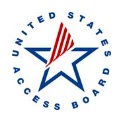
U.S. Access Board
(800) 872‒2253 (voice)
(800) 993‒2822 (TTY)
ta@access-board.gov

Department of Justice
(800) 514‒0301 (voice)
(800) 514‒0383 (TTY)

Federal Transit Administration
(888) 446‒4511
FTA.ADAAssistance@dot.gov
New Construction
This guide provides an introduction to the scoping requirements that form the basis for the Department of Justice’s 2010 ADA Standards and the Department of Transportation's ADA Standards and is not intended to be comprehensive or used as a stand-alone technical guide to those requirements. Users of this guide must familiarize themselves with the specific scoping requirements that apply to each element, building, facility, or site that is subject to the Standards adopted to implement titles II and III of the ADA.
Although this guide focuses on the provisions of Chapter 2 of the ADA Accessibility Guidelines, which form the basis of the DOJ and DOT ADA Standards, the 2010 Standards adopted by DOJ incorporate regulatory language that modifies or augments a number of those provisions, or address certain occupancies that are not specifically addressed in Chapter 2, and these regulatory provisions must be read in conjunction with Chapter 2 to ensure an accurate understanding of the legal requirements. Readers should become familiar with how the 2010 Standards modify the requirements in Chapter 2 and should not assume that by reading the provisions of Chapter 2 alone they will have all the information and perspective they need to achieve compliance with the 2010 Standards.
Scoping Requirements
Requirements in Chapter 2 indicate which elements and spaces must be accessible on a site or in a facility (the scope of coverage). These “scoping” requirements apply technical provisions in Chapters 3 – 10 to those covered elements and spaces provided on a site.
Applicable building codes, design practices, and other factors determine the elements and spaces required for a site, including parking, means of egress, and plumbing fixtures. The ADA Standards, on the other hand, specify the elements and spaces provided that must be accessible.
Application [§201]
The ADA Standards apply to the various types of facilities subject to the ADA, from simple structures to complex, multi-building sites such as university campuses and airports. Requirements in the standards apply to both exterior and interior spaces and elements provided on a site, usually without distinction. Provisions for parking, for example, apply equally to exterior lots and to parking garages. The standards cover permanent facilities and temporary facilities (other than those used in construction), such as reviewing stands, stages, portable toilets, and temporary classrooms.
In new construction, all areas must be fully accessible, including multiple spaces of the same type, unless otherwise specified. Areas not required to be fully accessible include:
Example: Retail Facility
This example of a retail facility shows how scoping requirements for certain elements and spaces (sales counters and fitting rooms) apply and indicates employee work areas.
Exception Based on Structural Impracticability in DOJ’s 2010 ADA Standards and DOT's ADA Regulations
DOJ’s 2010 ADA Standards and DOT's ADA regulations specify that full compliance is not required in new construction in rare circumstances where unique characteristics of terrain make the incorporation of accessibility features “structurally impracticable.” In such a case, the new construction requirements apply except where the responsible entity can demonstrate that it is structurally impracticable to meet those requirements. This exception is very narrow and should not be used in cases of merely hilly terrain.
Even in those circumstances where the exception applies, portions of a facility that can be made accessible must still be made accessible. In addition, access must be provided for individuals with other types of disabilities, even if it may be structurally impracticable to provide access to individuals who use wheelchairs.
This exception is found in DOJ’s 2010 Standards at §35.151(a) for title II and §36.401(c) for title III and in DOT’s ADA regulations at §37.41(b).
General Exceptions [§203]
These structures and spaces are fully exempt from the standards and are not required to be accessible or on an accessible route:
Construction Sites (§203.2)
Structures directly associated with the actual processes of construction and portable toilets used only by construction workers
Examples: scaffolding, bridging, materials hoists, construction trailers
Areas Raised for Security/ Safety (§203.3)
Areas raised primarily for purposes of security or life/ fire safety
Examples: life guard stands, fire towers, and prison guard towers
Raised Work Areas (§203.9)
Employee work areas under 300 s.f. that are elevated at least 7” as an essential functional condition of the space (excluding raised courtroom stations)
Example: Work areas with equipment/ machinery that must be operated from a platform
Limited Access Spaces (§203.4)
Spaces accessed only by ladders, catwalks, crawl spaces, or very narrow passageways
Examples: lighting/ equipment catwalks at stages and performing areas, platforms served only by ladder
Machinery Spaces (§203.5)
Spaces used only by service personnel for maintenance, repair, or occasional monitoring of equipment
Examples: elevator pits/ penthouses, mechanical/ electrical/ communications equipment rooms, water or sewage treatment pump rooms, electric substations, and transformer vault
Single Occupant Structures (§203.6)
Single occupant structures accessed only by below-grade passageways or elevated above standard curb height
Examples: toll booths that are accessed by underground tunnels or elevated above curb height, such as those serving dedicated truck lanes
Detention/Correctional and Residential Facilities (§203.7 and §203.8)
Common use spaces in detention/ correctional facilities or residential facilities that do not serve accessible cells or dwelling units are exempt.
Certain Sports/ Recreation and Other Structures (§203.10 - §203.14)
These structures and spaces are also exempt:
-
raised structures used solely for refereeing, judging, or scoring a sport
-
raised boxing/ wrestling rings
-
water slides and raised diving boards/ platforms
-
animal containment areas not open to the public
Employee Work Areas [§203.9]
Title I of the ADA prohibits discrimination based on disability in the workplace. Information on the ADA and equal opportunities in hiring and employment, including reasonable accommodations for employees, is available from the Equal Employment Opportunity Commission at (800) 669‒4000 (v), (800) 669‒6820 (TTY), or www.eeoc.gov.
The ADA Standards require a more limited level of accessibility in employee work areas. At a minimum, areas used only by employees as work areas must meet requirements for:
-
access to approach, entry, and exit the work area (§203.9)
-
accessible means of egress (§207.1)
-
wiring for visible alarms in areas served by audible alarms (§215.3)
-
accessible common use circulation paths in most work areas of at least 1,000 sq.ft. (§206.2.8)
Other requirements, including those for turning space, do not apply to areas used only by employees for work.
These provisions apply to those areas where only work is performed by employees. Spaces not used for work, including employee restrooms, locker rooms, break rooms, cafeterias, and parking, must be fully accessible. Some public use spaces also function as work spaces, such as medical exam rooms and classrooms. These spaces must be fully accessible for public use, but elements within used only by employees for work are not required to comply.
Recommendation: Although areas used only by employees for work are not required to be fully accessible, consider designing such areas to include non-required turning spaces, and provide accessible elements whenever possible. Under the ADA, employees with disabilities are entitled to reasonable accommodations in the workplace. Accommodations can include alterations to spaces within the facility. Designing employee work areas to be more accessible at the outset will eliminate or reduce the need for more costly retrofits in providing reasonable accommodations for employees with disabilities.
Access to Approach, Enter, and Exit Work Areas
Access for “approach, entry, and exit” requires a connecting accessible route to the work area and a compliant entrance, including entry doors or gates, plus wheelchair space in the work area. Work areas must also be served by an accessible means of egress, as required by the International Building Code.
Access for Approach, Entry, and Exit
Common Use Circulation Paths in Employee Work Areas [§206.2.8]
Common use circulation paths must be accessible in work areas 1,000 square feet or more in size (as defined by permanently installed partitions, counters, casework, or furnishings). This requirement facilitates access to individual work stations within a space.
Common Use Circulation Paths
Work Area Circulation Paths: Exceptions
Common use circulation paths are required to be accessible except:
-
in work areas below 1,000 sq. ft. in size
-
in work areas fully exposed to the weather (regardless of size)
-
where they are integral to work equipment
Circulation Paths Serving Exempted Spaces [§203]
Portions of common use circulation paths serving exempt spaces within a work area are not required to comply, including routes to or within:
-
machinery spaces used only by service personnel;
-
spaces accessed only by ladders, catwalks, crawl spaces, or very narrow passageways;
-
employee work areas under 300 sq. ft. that are elevated at least 7” as an essential functional condition of the space (excluding raised courtroom stations);
-
and other exempted spaces.
Wiring for Visible Alarms [§215.3]
All employee work areas served by audible fire alarms, regardless of size, must be designed to support later installation of visible alarms after construction if needed. In new construction, alarm systems are typically provided with sufficient power resources to support the addition of strobes where they are needed to accommodate an employee who cannot hear the audible alarm.
Recommendation: In facilities where an above-average number of employees with hearing impairments is likely, such as in the offices of a school for people who are deaf or hard of hearing, it is advisable to equip alarm systems with power capacity above the level that is typically provided in order to accommodate a greater number of visual appliances.
Scoping Requirements for Elements and Spaces [§204 – §243]
Scoping provisions for elements and spaces, which are summarized here, are further discussed with relevant technical provisions in the following chapters of this guide.
General Elements
Most scoping provisions apply to both interior and exterior elements where provided throughout facilities and sites (and are not limited to those in corridors as shown here).
Specific Spaces and Occupancies
The ADA Standards include scoping requirements specific to certain types of spaces and facilities that apply based on the intended use and design. Spaces with multiple uses must meet all applicable requirements for each use. Scoping provisions for specific spaces and occupancies address:
Transportation Facilities (§218) and Bus Stops (§209)
Assembly Areas (§221) *
Dressing, Fitting, and Locker Rooms (§222)
Medical Care and Long-Term Care Facilities (§223) *
Transient Lodging Guest Rooms (§224) *
Storage (§225)
Judicial Facilities (§231)
Detention and Correctional Facilities (§232) *
Residential Facilities (§233) *
Recreation Facilities (§234 – §243)
DOJ’s 2010 ADA Standards incorporate regulatory language that modifies or augments a number of these provisions (noted with an asterisk) and also set forth additional requirements for spaces and facilities provided in housing at a place of education, social service center establishments, and curb ramps.
Common Questions
Are all public use and common use areas required to be accessible?
All areas of facilities, including public and common use areas, are required to be accessible in new construction except those that are specifically exempt (e.g., certain types of limited use or raised spaces) or that are covered by provisions that require only a specified portion to comply (e.g., transient lodging guest rooms and patient bedrooms). All other rooms and spaces, including multiple ones of the same type, such as patient exam rooms, classrooms, and courtrooms, are required to be accessible. Employee work areas, however, are not required to be fully accessible.
Can access be provided after construction based on need?
Access required by the ADA Standards must be put in place and ready for use as part of construction. This is required in all but a few specified instances, such as:
-
Toilet and bathrooms in residential dwelling units or accessed through an individual’s private office for his or her exclusive use are not required to be built with certain specifically enumerated access features, such as grab bars and lavatory clearances, if they are built according to criteria that will facilitate later installation or adaptation, such as reinforcement for grab bars and removable vanity cabinets.
-
Vertical access to work stations in courtrooms, such as judges’ benches, can be provided after construction if space and other requirements are met to ease later installation of necessary ramps or lifts.
Are employee restrooms and break rooms required to be accessible?
Yes, spaces used by employees for purposes other than work, including restrooms, break rooms, locker rooms, lounges, and parking must be fully accessible. Areas used only by employees for work are not required to be fully accessible but must be connected by accessible routes and means of egress for approach, entry, and exit and have wiring to support visual alarms if served by audible alarms. Also, circulation paths must be accessible in work areas at least 1,000 square feet in size.
What does access for “approach, entry, and exit” to employee work areas require?
Access for individuals with disabilities to “approach, entry, and exit” employee work areas requires that the following be provided at a minimum: an accessible route to the work area, a compliant entrance, including any entry door or gate, to the work area, and wheelchair space (30 inches by 48 inches minimum) within the work area. Work areas also must also meet referenced requirements in the International Building Code for accessible means of egress and also have wiring to support later installation of visual alarm appliances.
Alterations and Additions
This guide provides an introduction to the scoping requirements that form the basis for the Department of Justice’s 2010 ADA Standards and the Department of Transportation's ADA Standards and is not intended to be comprehensive or used as a stand-alone technical guide to those requirements. Users of this guide must familiarize themselves with the specific scoping requirements that apply to each element, building, facility, or site that is subject to the Standards adopted to implement titles II and III of the ADA. See the introduction to the guide on “ADA Scoping: New Construction” for further discussion.
General [§202.1]
Additions and alterations undertaken at existing facilities are covered by the ADA Standards. The extent of application is largely determined by a project’s scope of work as the standards apply to those elements or spaces that are altered or added. Additional requirements apply to projects that affect or could affect the usability of, or access to, an area containing a primary function.
Additions [§202.2]
Projects that increase, expand, or extend a facility’s gross floor area or height of a facility are considered additions (as defined in §106.5) and must comply with the requirements of the standards applicable to new construction. Existing elements and spaces affected by an addition are treated as alterations and qualify for certain allowances or exceptions that are not permitted in new construction.
Application of the Standards in Additions
Alterations [§202.3]
Alterations are defined in the standards (§106.5) as “a change in a building or facility that affects or could affect the usability of a building or facility or portion thereof.” Many types of projects are covered as “alterations,” including remodeling, renovation, rehabilitation, reconstruction, restoration, resurfacing of circulation paths or vehicular ways, and changes or rearrangement of structural parts, elements, or walls. Normal maintenance, reroofing, painting or wallpapering, or changes to mechanical and electrical systems are not considered alterations unless they affect a facility’s usability. For example, a project limited to an HVAC system that includes the addition of thermostats would affect a facility’s usability because it involves elements (operable parts) covered by the standards.
The standards ensure that the opportunities for accessibility presented by an alteration are taken. How and to what extent the standards apply is determined by the scope of a project and the elements and spaces altered. Only those elements or spaces altered are required to comply, but alterations made to areas containing a primary function (a major activity for which a facility is intended) also require an accessible path of travel.
Application of the Standards in Alterations
If alterations are limited only to elements in a room or space, then the standards apply only to the elements altered. Similarly, where spaces are altered, the standards apply to those spaces that are altered. If a room or space is completely altered (or built new as part of an alteration), the entire room or space is fully subject to the standards. Compliance is required to the extent that it is technically feasible.
Example: Toilet Room Alterations
In a restroom project involving alterations to the toilet, grab bars, faucet controls, and mirror, the standards apply to these elements but not to those that remain unaltered. In more extensive projects where additional elements are altered, application of the standards is greater, commensurate with the scope of work.

Recommendation: While only those elements altered are required to comply, it is advisable to maximize opportunities for accessibility in alterations. Alteration of multiple elements in a room or space may provide a cost-effective opportunity to make the entire room or space fully accessible.
The standards do not require alterations to exceed the level of access required in new construction. For example, spaces that are exempt in new construction are also exempt in alterations.
Prohibited Reduction in Access
New construction requirements also set the baseline for any alteration that would effectively reduce existing accessibility. Alterations that reduce accessibility below the level that would be required in new construction are prohibited. Reductions in access are allowed only where, and to the extent that, the minimum level required in new construction is exceeded. For example, if an alteration will reduce the number of parking spaces on a site, accessible parking spaces can be proportionately reduced as long as the minimum required in new construction (based on the parking facility’s new total) is met. Elements that are not required by the standards to be provided for accessibility, such as phones, can be completely removed from a site.
Special Provisions for Alterations
The standards apply the same requirements used in new construction to alterations but also include provisions unique to alterations. Some provisions clarify application, while others are structured as exceptions that limit coverage or relax technical criteria under certain conditions. Located throughout the standards at the relevant scoping or technical requirement, these provisions and exceptions are distinguished by references to “alterations” or “existing facilities.”
An accessible route to stories and mezzanines is required in alterations (or additions) where stairs or escalators are added where none existed previously and major structural modifications are necessary (§206.2.3.1) (or as needed to provide an accessible path of travel to an altered primary function area if not disproportionate to the cost (§202.4)), unless the building is exempt from the requirement for access between stories.
If elevators are altered, all cars programmed to respond to the same call control must be similarly modified (§206.6.1).
Compliant fire alarm systems are required only in alterations where fire alarm systems are installed new, replaced, or upgraded (§215.1, Ex. 1).
Slightly steeper running slopes are permitted for short ramps (maximum 6” rise) where space is limited (§405.2, Ex.).
Full handrail extensions at stairs are not required where they would project hazardously into circulation paths (§505.10, Ex. 3).
Technical Infeasibility
Compliance in an alteration is not required where it is “technically infeasible.” The term is defined as “something that has little likelihood of being accomplished because existing structural conditions would require removing or altering a load-bearing member that is an essential part of the structural frame; or because other existing physical or site constraints prohibit modification or addition of elements, spaces, or features that are in full and strict compliance with the minimum requirements.”
Where technical infeasibility is encountered, compliance is still required to the maximum extent technically feasible.
Example of Technical Infeasibility
It may be technically infeasible in an alteration to enlarge a toilet room confined in size by structural supports, elevator shafts, mechanical rooms and chases, stairways, or required egress routes not affected by the project. In this case, the toilet room must be sized and other requirements, including those for plumbed fixtures, must be met to the maximum extent technically feasible. However, the concept of technical infeasibility remains relative to the planned scope of work. If the entire building is significantly renovated or gutted, constraints of this type would likely not exist.
Other examples where compliance could potentially be technically infeasible include:
-
conflicts with applicable building, plumbing, life safety or other codes (such as when combining two toilet stalls to create an accessible stall would violate the plumbing code’s required fixture count);
-
meeting slope requirements on existing developed sites located on steep terrain where necessary re-grading and other design solutions are not feasible; or
-
work that would impact load-bearing walls and other essential components of the structural frame, including structural reinforcement of the floor slab.
Alterations Affecting Primary Function Areas [§202.4]
Additional requirements apply when alterations are made to areas containing a “primary function,” which is a major activity intended for a facility. Examples of primary function areas include dining areas of a restaurant, retail space in a store, exam rooms in a doctor’s office, classrooms in a school, and offices and other work areas where the activities of a covered entity are carried out. Spaces not considered primary function areas include entrances, corridors, restrooms, break rooms, employee locker rooms, and mechanical or electrical closets. Restrooms are not primary function areas unless their provision is the primary purpose of a facility, such as a highway rest stop. DOJ’s 2010 ADA Standards and DOT’s ADA regulations contain detailed provisions on alterations to primary function areas that must be applied in addition to section 202.4.
Accessible Path of Travel
When alterations are made to a primary function area, an accessible path of travel to the area must be provided. The accessible path of travel must extend from the altered primary function area to site arrival points, including public sidewalks and parking and passenger loading zones provided on the site. The path of travel also includes access to restrooms, telephones, and drinking fountains, where provided to serve the primary function area. In leased facilities, alterations made by a tenant to primary function areas that only the tenant occupies do not trigger a path of travel obligation upon the landlord with respect to areas of the facility under the landlord’s authority if those areas are not otherwise being altered.
Disproportionality (20%)
The accessible path of travel is required to the extent that it is not “disproportionate” to the total cost. Regulations implementing the standards define “disproportionate” as exceeding 20% of the total cost of alterations to the primary function area. The 20% cap applies only to costs associated with the accessible path of travel, including an accessible route to the primary function area from site arrival points, entrances, and retrofits to restrooms, telephones, and drinking fountains.
Prioritization
Compliance is required up to the point the 20% cost cap is reached, even where it does not result in a fully accessible path of travel. Where costs exceed this cap, compliance should be prioritized in this order:
1. an accessible entrance
2. an accessible route to the primary function area
3. restroom access
4. an accessible telephone
5. an accessible drinking fountain
6. access to other elements such as parking and storage
The requirements for alterations to primary function areas are found in DOJ’s ADA Standards at 28 CFR §35.151(b) (title II) and 28 CFR §36.403 (title III) and in DOT’s ADA Regulation at 49 CFR §37.43.
Accessible Path of Travel
Alterations to Qualified Historic Facilities [§202.5]
The standards contain specific provisions for qualified historic facilities which are defined as buildings or facilities that are “listed in or eligible for listing in the National Register of Historic Places or designated as historic under an appropriate State or local law.” Alterations to qualified historic facilities must comply with section 202.5 to the maximum extent feasible. If it is not feasible to provide physical access to an historic property in a manner that will not threaten or destroy the historic significance of the building or facility, alternative methods of access are permitted by DOJ’s ADA Standards (28 CFR 35.151(b)(3)(ii) and 28 CFR 36.405(b)).
Like other existing facilities, the requirements for alterations apply in relation to the scope of work. Alterations provisions and exceptions, including those based on technical infeasibility, and requirements for path of travel to primary function areas, apply to historic facilities with exceptions for circumstances where compliance with the standards would threaten or destroy the historic integrity or significance of a facility as determined by the appropriate State Historic Preservation Official or Advisory Council on Historic Preservation. These exceptions apply to requirements for accessible routes (§206.2) entrances (§206.4), and toilet rooms (§213.2).
Exceptions for Qualified Historic Facilities
(where compliance would threaten or destroy a facility’s historic significance)
Common Questions
What requirements of the standards apply in an alteration?
Application of the standards in an alteration is determined by the scope of work and whether it involves areas containing a primary function. Altered elements or spaces must comply with relevant provisions of the standards except where compliance is technically infeasible. Where compliance is technically infeasible, compliance is required to the maximum extent feasible. If alterations are made to an area containing a primary function (a major activity for which a facility is intended), an accessible path of travel from the area to site arrival points, as well as the restrooms, telephones, and drinking fountains serving the area, must be made accessible as part of the work to the extent it is not “disproportionate” (more than 20% of the total cost).
How is “technical infeasibility” determined in an alteration?
Determining “technical infeasibility” requires a site-specific assessment of constraints or complications in relation to the planned scope of work. The term, as defined in the standards (§106), is intended to encompass design, site, engineering or other constraints that prohibit compliance. Examples include work that would impact a facility’s structural frame or that would conflict with applicable codes or building requirements.
Do the ADA Standards apply to existing facilities that are not subject to the alterations requirements?
DOJ’s ADA regulations address access to existing facilities that are not being altered. The regulations require removal of barriers by public accommodations (title III) and program access by state and local governments (title II). The 2010 Standards apply when architectural changes are made to facilities in order to comply with the program access requirements of title II of the ADA. In addition, the 2010 Standards are the benchmark for compliance with the title III barrier removal requirements. For more information about barrier removal and program access, visit DOJ’s website at www.ada.gov or contact the DOJ ADA Information Line at (800) 514-0301 (voice) or (800) 514-0383 (TTY).
Floor and Ground Surfaces
This guide explains requirements in the ADA Standards for floor and ground surfaces. Specifications for floor and ground surfaces address surface characteristics, carpeting, openings, and changes in level. They apply to:
-
interior and exterior accessible routes, including walking surfaces, ramps, elevators, and lifts
-
stairways that are part of a means of egress
-
required clearances, including clear floor space, wheelchair seating spaces, turning space, and door maneuvering clearances
-
accessible parking spaces, access aisles, and accessible passenger loading zones.
Firmness, Stability, and Slip Resistance [§302.1]
Accessible floor and ground surfaces must be stable, firm, and slip resistant. Stable surfaces resist movement, while firm surfaces resist deformation by applied forces. Accessible surfaces remain unchanged by external forces, objects, or materials.
Hardened materials such as concrete, asphalt, tile, and wood are sufficiently firm and stable for accessibility.
Most loose materials, including gravel will not meet these requirements unless properly treated to provide sufficient surface integrity and resilience. Binders, consolidants, compaction, and grid forms may enable some of these materials to perform satisfactorily but require repeated maintenance.
Slip Resistance
Accessible surfaces must be slip resistant to minimize hazards to people with disabilities, especially those who are ambulatory or semi-ambulatory or who use canes, crutches, and other walking aids. However, the standards do not specify a minimum level of slip resistance (coefficient of friction) because a consensus method for rating slip resistance remains elusive. While different measurement devices and protocols have been developed over the years for use in the laboratory or the field, a widely accepted method has not emerged. Since rating systems are unique to the test method, specific levels of slip resistance can only be meaningfully specified according to a particular measurement protocol. Some flooring products are labeled with a slip resistance rating based on a laboratory test procedure.
Compliance with the standards requires specifying surface materials, textures, or finishes that prevent or minimize slipperiness under the conditions likely to be found on the surface. Standard practices for minimizing floor or ground slipperiness will likely satisfy compliance with the standards as slip resistance is important not just for accessibility but for general safety as well. Applications and finishes used to increase a surface material’s slip resistance may require continued maintenance or re-application.
Surface Smoothness
The standards limit changes in level and openings in floor and ground surfaces, but they do not further address overall surface smoothness. Rough surfaces composed of cobblestones, Belgian blocks, and similar materials can be difficult and sometimes painful to negotiate with wheeled mobility aids due to the vibrations they cause.
Cobblestones and other rough surfaces make wheelchair travel difficult and uncomfortable.
Recommendation: Avoid materials or construction methods that create bumpy and uneven surfaces in areas and along routes required to be accessible.
Carpet [§302.2]
Carpet that is thick, cushiony, or loose impairs accessibility, particularly wheelchair maneuvering. The standards specify the maximum pile height (1/2” measured to the backing, cushion, or pad) and texture (level or textured loop, level cut pile, or level cut/uncut pile) and require firm backing. Cushions or pads also must be firm or can be avoided to ensure greater firmness.
Carpeting must be securely attached so that it does not shift or buckle against wheeled traffic. Cushions or pads, if used, also must be properly secured to resist movement. Rolling or buckling occurs when carpet is not properly secured and makes wheelchair maneuvering very difficult.
Exposed edges must have trim on the entire length of the exposed edge and be fastened to the floor to prevent curling. Trim must meet specifications for changes in level, including requirements for beveled edges when the height exceeds ¼ inch. The maximum height is ½ inch.
Carpet Edge Treatment 1/2” max height, 1:2 max beveled edge
Carpet to Tile Transition Changes in level 1/4” max high permitted vertical edge
Openings [§302.3]
Openings in ground and floor surfaces, such as grates, are limited in width to prevent passage of a ½” diameter sphere. Wheelchair casters can get wedged into wider openings.
Surface Opening (Cross Section)
Elongated openings, like those of most grates, must be oriented so that the long dimension is perpendicular to the dominant travel direction. In locations where there is no dominant flow pattern, openings must be limited to ½” in both dimensions. Where an accessible route is available to bypass openings completely, they can be oriented in any direction.
Changes in Level [§303]
Changes in level can be up to ¼” without treatment or ½” if beveled with a slope no steeper than 1:2. Changes in level above a ½” must be treated as a ramp or curb ramp (or a walkway if a slope no steeper than 1:20 can be achieved). These specifications apply to all portions of accessible routes, including thresholds and carpet trim.
1/4” Max Change in Level
1/2” Max Change in Level
Common Questions
Must accessible surfaces be paved?
Concrete, asphalt, and other paved surfaces are more reliably compliant, but other materials, such as wood, and construction methods can be used to provide firm and stable surfaces. Loose material like gravel will not perform adequately unless it is sufficiently stabilized by binders, compaction, or other treatments and will likely require repeated maintenance.
What is the minimum level of slip resistance required by the standards?
The standards require ground and floor surfaces to be slip resistant, but they do not specify a minimum level of slip resistance or coefficient of friction. This value varies according to the measurement method and protocols used. Some products are labeled with a rated level, but in the absence of a consensus test procedure, the standards do not set a minimum value. Standard methods to prevent or minimize slipperiness in the specification of floor materials, textures, applications, and finishes may be sufficient for compliance with the standards.
Is there a minimum distance between changes in level?
The standards do not require a minimum horizontal separation between changes in level of a ½” or less. Such level changes may need to be in close proximity, such as at raised thresholds (otherwise a minimum 48” separation will provide enough wheelchair space so that only one vertical change is negotiated at a time). Ramps and curb ramps, which must be used to span vertical changes greater than ½”, must have level landings and clearances at the tops and bottoms of each run to provide adequate separation and resting intervals between sloping surfaces.
Elongated surface openings must be perpendicular to the dominant direction of travel, but what if there is no dominant direction of travel?
When there is no dominant direction of cross traffic, openings must be limited to ½” in both dimensions. Where space allows accessible routes to completely bypass the area with openings, elongated openings can be oriented in either direction.
Clear Floor or Ground Space and Turning Space
This guide explains requirements in the ADA Standards for clear floor or ground space and turning space. Clearances are required at accessible elements, fixtures, and controls so that people with disabilities, including those who use wheelchairs, can approach and use them. The standards also address maneuvering space for wheelchair turning. Provisions throughout the standards reference these basic “building block” requirements.
Clear Floor or Ground Space [§305]
Sufficient clear floor or ground space is required at accessible controls, operable parts, drinking fountains, lavatories and sinks, ATMs and fare machines, appliances, beds, and other elements. Provisions for these elements apply the clear floor or ground specifications in 305.
Clear Floor Space at Elements
Clear floor space is required at each accessible element, including storage cabinets, drinking fountains and other fixtures, and electrical outlets. Clear floor spaces can overlap where elements are in close proximity.
Position [§305.5]
At most elements, clear floor or ground space can be positioned for either a forward or a side approach. For better usability, a forward approach is required at certain elements, including dining and work surfaces, drinking fountains, lavatories, and most sinks. At other elements, a side approach is allowed. A side approach is typically provided or required at sales and service counters, beds, and most appliances.
Forward Approach
Side Approach
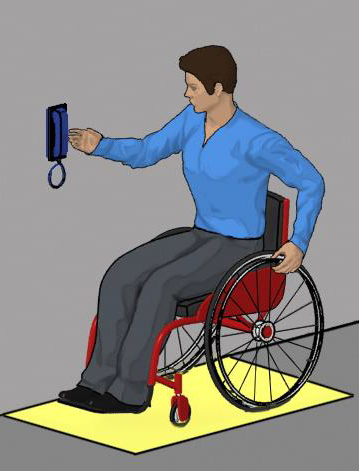
Centering
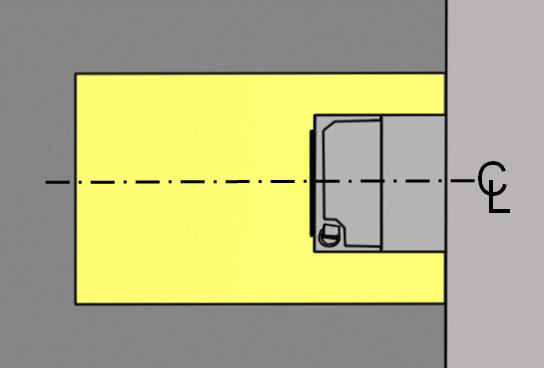
Centering the clear floor or ground space on elements is often advisable but is only required at drinking fountains, kitchen work surfaces, and washers and dryers.
Surface and Size [§305.2 and §305.3]
Clear floor spaces must meet requirements for ground and floor surfaces, including criteria for firmness, stability, and slip resistance. They must be free of level changes and not slope more than 1:48.
The minimum size (30” by 48”) applies whether the space is positioned for forward or side approaches. Additional space is required when the space is confined on three sides and is obstructed for more than half the depth, such as when elements are recessed in alcoves.
Approach and Maneuvering Clearance [§305.6 and §305.7]
Where the space is obstructed on both sides for more than half the depth, additional clearance is required for maneuvering. Accessible routes must connect to the unobstructed side of the space.
Knee and Toe Space [§305.4 and §306]
Objects that provide space for toes or knees can overlap a portion of the clear floor space. Knee and toe space allows a closer approach to elements and reduces the reach to operable parts. It is required at some elements, such as drinking fountains and lavatories, so that people using wheelchairs can pull up to them.
Toe Space
Objects that provide clearance for toes can overlap a portion of the clear floor space.
Knee Space
Objects that provide clearance for knees and toes can overlap a greater portion of the clear floor space (up to a depth of 25”).
Knee and toe space must be at least 30” wide and up to 25” deep measured to the leading edge of the clear floor space. The specifications allow space for plumbing, enclosures, and supports outside the minimum clearances. No object can protrude into the required clearances (other than the dip of the overflow at lavatories and sinks).
Knee and Toe Space Depth
Where knee and toe space is required, it must be at least 17” deep. In all cases, the minimum depth may be further determined by the required reach to operable parts served by the clear floor space.
Knee and toe space is required below drinking fountains, lavatories and sinks, dining and work surfaces, and those sales and service counters that provide a forward approach.
Obstructed Reach Depth
At any element, the knee and toe space must be as deep as the required reach to operable parts. This facilitates access since a forward reach does not extend far beyond the toes. Both the reach depth and the knee and toe space depth are limited to 25” measured from the leading edge of obstructions. Space beyond this depth is not usable.
Knee and Toe Clearances
Where knee and toe space is required at an element, it must be at least 17” deep. Beyond a depth of 8” measured from the leading edge, the 27” minimum high knee clearance can reduce 18” (to the 9” toe space) over a 3” span.
When the knee and toe depth exceeds the 17” minimum, the additional space must provide full knee clearance at least 27” high.
Turning Space [§304]
Turning space is required in these accessible rooms and spaces:
-
toilet and bathing facilities
-
dressing, fitting, and locker rooms
-
transient lodging guest rooms
-
dwelling units (all rooms on an accessible route)
-
patient bedrooms
-
holding and housing cells
-
saunas and steam rooms
-
raised courtroom stations served by ramps or lifts with entry ramps
-
certain recreation spaces (amusement ride load/ unload areas, fishing piers and platforms, play components, and shooting facilities)
Space for turning is also required along accessible routes where a 180 degree turn around an obstruction less than 48” wide is required (§403.5.2).
Clear Width at 180 Degree Turn Around a Narrow Obstruction
Recommendation: Turning space is recommended in small spaces with entrapment risks as well as at dead-end aisles and corridors so that people using wheeled mobility aids do not have to back up considerable distances.
Maneuvering for Turns
Maneuvering for 180 degree turns varies by person and the mobility aid used. An efficient way of turning using a manual wheelchair is to turn the wheels in opposite directions for a pivoting turn. Some power chairs also may permit tight circular turns.
A three-point turn is common when using scooters and other motorized devices that have a larger turning radius.
Size [§304.3]
Turning space can be provided in the shape of a circle or a T. Elements with knee and toe space can overlap a portion of the turning space.
Circular Turning Space
Recommendation: To provide easier access, locate elements with knee and toe space outside the turning space or, with circular space, limit overlap to approximately 12” so that wheelchair space 48” long minimum remains clear.
T-Shaped Turning Space
T-shaped space can be configured for approach on any segment (stem or either arm).
Door Swing [§304.4] and Other Space Requirements
Doors can swing into the turning space. The turning space can overlap other space requirements, including clear floor space required at elements and fixtures.
Common Questions
Is clear floor space required to be centered on elements?
The standards require the clear floor space to be centered on wheelchair accessible drinking fountains (forward approach), kitchen work surfaces, (forward approach), and washers and dryers (side approach). Centering the clear floor space on other elements is often advisable, but not required.
Can doors swing into required clear floor or ground space?
Doors cannot swing into required clear floor or ground spaces in these specific instances:
-
clear floor space at controls for automatic and power assisted doors and gates (404.3.5)
-
fixture clearances in toilet and bathing facilities (except those that are single user where wheelchair space beyond the door swing is provided) (603.2.3)
-
clear floor space required at benches in saunas and steam rooms (612.2)
-
clear floor space required at tactile signs, which must be beyond the arc of any door swing between the closed position and 45 degree open position (703.4.2)
-
dressing, fitting, or locker rooms unless wheelchair space is provided beyond the arc of the door swing (803.3)
In other locations, doors can swing into clear floor or ground space, although locating door swing outside required clearances is advisable.
Can doors swing into turning space?
Yes, doors can swing into turning space.
Can clear floor/ground space or turning space overlap other space requirements?
Yes, clear floor or ground spaces and turning space can overlap other required clearances, including other clear floor spaces, door maneuvering clearances, and fixture clearances.
Is turning space required in all rooms and spaces?
No. Turning space is required in certain spaces, such as toilet and bathing facilities, dressing and fitting rooms, and transient lodging guest rooms. Unless addressed by a specific requirement for turning space in the standards, other spaces are not required to provide them, including lobbies, offices, and meeting rooms.
Operable Parts Covered [§205]
Compliance is required for operable parts located in accessible spaces and along accessible routes. Operable parts include light switches, electrical and communication receptacles, thermostats, alarm pulls, automatic door controls, and other elements used by facility occupants.
Examples of Operable Parts
Examples of Operable Parts in Kitchens
Operable Parts [§309]
Requirements apply generally to all types of operable parts covered. They are also referenced by technical sections of the standards covering drinking fountains, faucet and flush controls, ATM and fare machines, appliances, storage, windows, and door and gate hardware, and other elements.
Accessible Features of Operable Parts
Forward and Side Approaches
At most elements, clear floor space can be positioned for either a forward approach or a side approach. A forward approach is required at some elements, such as drinking fountains and lavatories, for easier access.
Clear Floor Space [§309.2]
Clear floor space for forward approaches must extend up to or, if knee or toe space is provided, below operable parts. This facilitates access since the forward reach does not extend beyond a wheelchair user’s toes.
If clear floor space is obstructed on both sides more than half the minimum required depth, a wider clearance (36” min.) is required for maneuvering and sway.
If the forward reach to operable parts extends over an obstruction, such as a counter, clearances for toes and knees is required below. The knee and toe space must be at least as deep as the reach depth measured from the leading edge of the obstruction.
Forward Reach [§308.2]
The range for unobstructed reaches (15” – 48”) applies only to those portions of elements that are operable. Non-operable portions can be located outside the range.
The maximum reach of 48” is reduced to 44” when the depth of reach over an obstruction exceeds 20.” Knee and toe space must extend the full depth of reach.
Clear Floor Space [§309.2]
Clear floor space can be oriented for a side approach instead of a forward approach at most operable parts. Nominal centering of the space on operable portions of elements is advisable, but not required (except at washers and dryers).
Clear Floor Space
Additional clearance is required if the space is obstructed on three sides for more than half the depth to allow easier maneuvering into the space.
Side Reach [§308.3]
The range for side reach, like forward reach is 15” to 48” if unobstructed. The maximum reach depth for this range is 10” measured from the available clear floor space.
Fuel Dispensers
The operable parts of fuel dispensers located on existing curbs can be up to 54” high.
The maximum high reach is reduced to 46” when the reach over an obstruction is deeper than 10” (to a maximum of 24”). Obstructions at side reaches are limited to a height of 34”.
Elements located in corners can be difficult to reach from a side approach.
Recommendation: Where a side reach is provided, locate elements away from corners in consideration of the typical reach radius.
Advisory Reach Range for Children
The standards include advisory (non-mandatory) reach ranges based on children’s dimensions that can be followed when operable parts are designed for use by children. This guidance provides reach ranges recommended according to three age groups.
Operation [§309.4]
Operable parts must be usable with one hand and not require:
-
tight grasping, pinching, or twisting of the wrist, or
-
more than 5 pounds of force (lbf) to operate.
Parts that can be operated without hand or finger dexterity, fine motor movement, or simultaneous actions provide easier access and accommodate a broader range of users.
Operability with a closed fist is a reliable test of usability, but is not required by the standards.
Push Plates, Buttons, and Bars
Push-activated controls not requiring more than 5 lbf are acceptable. Buttons that are raised or flush are easier to use than those that are recessed. (Elevator control buttons cannot be recessed, and input keys at ATM and fare machines must be raised.)
Standard U-shaped pulls and lever-shaped handles are acceptable. Stationary knobs with a shape that can be loosely gripped also are acceptable. Knobs that require a full hand grip and turning, including round door knobs and shower controls, do not comply because they require twisting of the wrist.
Latches and locks with small parts that must be manipulated can be difficult to use and will not comply if pinching is necessary. However, non-fixed portions of locks and other operable parts, such as keys and access cards, are not required to comply (but those that do not require pinching or turning provide better access). Hardware that does not require simultaneous actions are better, but some types, such as handles with thumb latches are acceptable.
Dials and other controls that can be turned with the fingers but not the full hand can be used if they do not require twisting of the wrist or pinching. Flip switches and similar controls are acceptable, though push plate types can provide easier access.
Common Questions
Are redundant controls for an element required to comply?
If redundant controls, other than light switches, serve a single element, one control in each space is not required to comply. If a redundant control is located in a different space, however, it must comply. All light switches are required to comply.
What types of electrical or communication receptacles are exempt because they serve a “dedicated use”?
Electrical receptacles serving a dedicated use include those installed for appliances, including refrigerators, ranges, and dishwashers, and wall clocks. Floor electrical receptacles are also exempt. Communication receptacles serving a dedicated use include phone jacks, data ports, network and audio-visual connections. Electrical receptacles provided for portable communication devices such as TTYs are not covered by this exception and must comply.
Do reach range requirements apply to elements or only to operable parts of elements?
Reach range requirements apply to the operable portions of elements, including handles, controls, switches, buttons, control pads and other mechanisms that must be activated or manipulated for use. Non-operable portions of elements do not have to be within accessible reach ranges.
Must operable parts be usable with a closed fist?
Closed-fist operation is a good performance test but is not required by the standards. Many types of operable parts, such as pull handles, satisfy the requirements even though they may not be operable with a closed fist.
Are turn-key locks prohibited by the standards?
Key locks or key cards are not prohibited by the standards which apply only to the fixed portions of operable parts. Similarly, items dispensed by ATMs and fare machines, such as receipts, cash, fare cards, and vending machine products are not covered by the standards.
Protruding Objects [§204]
To prevent hazards to people with vision impairments, the standards limit the projection of objects into circulation paths. These requirements apply to all circulation paths and are not limited to accessible routes. Circulation paths include interior and exterior walks, paths, hallways, courtyards, elevators, platform lifts, ramps, stairways, and landings.
Examples of Protruding Objects
Protrusion Limits [§307.2]
People with vision impairments often travel closely along walls which can provide wayfinding cues sometime called a “shoreline.” Objects mounted on walls, partitions, columns, and other elements along circulation paths can pose hazards unless their projection is limited. Those with leading edges that are within cane sweep (27” high maximum) or that provide minimum headroom clearance (80” minimum) do not pose hazards and can protrude any amount.
Limits of Protruding Objects
Protruding object limits apply to the full width of circulation paths.
Location Above Detectable Elements
Objects located above elements that are within can sweep can protrude 4” maximum from the leading edge of such elements provided that any required reach or clear floor space is not obstructed.
Side Partitions and Wing Walls
Side partitions or panels and wing walls can also be used to make protruding objects compliant. The bottom edge of panels or partitions must be 27” high maximum.
Recessed Objects
Objects can be recessed in alcoves so that they do not project more than 4” into circulation paths. Alcoves must be sized to accommodate required clear floor space at accessible elements.
Elements, such as wheelchair accessible drinking fountains, must provide a knee clearance of at least 27”. If located to provide, but not exceed this clearance (27” above the floor or ground absolute), they are not protruding objects because the leading edge will be within cane detection.
A wheelchair accessible unit located 27” absolute above the ground or floor is cane detectable and can be used to enclose one side of high units for standing access. In this instance, the 27” height is effectively an absolute dimension because it is the minimum required for knee clearance and the maximum specified for cane detection.
Post-Mounted Objects [§307.3]
Free-standing objects with leading edges 27” to 80” high that are mounted on posts or pylons cannot protrude more than 12” into circulation paths. The 12” limit also applies to the clearance between multiple posts (excluding the sloping portions of handrails).
Objects with leading edges 27” maximum or above 80” can protrude any amount from posts or pylons.
Vertical Clearance [§307.4]
Headroom clearance of at least 80” high is required along all circulation paths (except at doors and doorways where a 78” minimum clearance is permitted to accommodate door stops and closers).
Fixed barriers, such as guardrails, are required where the vertical clearance is less than 80” such as at open stairways and along sloped or curved walls. Barriers must have leading edges no higher than 27” so that they are within cane sweep. Fixed planters, benches, and other elements can be used instead of guardrails.
Barriers at Circulation Areas with Reduced Vertical Clearance
Reduced Clearance Below Stairway
Clearance Reduced at Curved (or Sloped Walls)
Recommendation: A minimum height is not specified for barriers demarcating areas with less than 80” of vertical clearance. It is recommended that barriers be high enough so that they are not mistaken for a step or other change in level and do not pose a tripping hazard.
Common Questions
Are requirements for protruding objects limited to hallways and corridors?
No, requirements for protruding objects apply to all circulation paths, including those in rooms and spaces off corridors. They apply to both interior and exterior circulation paths.
Do drinking fountains pose hazards as protruding objects?
Cantilevered units at standard heights for people who stand must be recessed or protected as protruding objects. This is not required for wheelchair accessible units with no more than a 27” clearance below (the minimum required for knee clearance and the maximum recognized for cane detection).
Can curbs be used to indicate areas with less than 80” of vertical clearance?
The standards specify a maximum height (27”) for the leading edge of barriers so they are within cane sweep, but a minimum height is not specified. Curbs may be mistaken for a step or change in level, instead of a barrier. For this reason, barriers significantly higher than a curb or riser, such as a guardrail, planter box, bench, parapet wall, or similar elements are recommended.
Where Required: Site Arrival Points [§206.2.1]
This guide explains scoping and technical requirements for accessible routes in the ADA Standards.
At least one accessible route must be provided within the site to accessible facility entrances from these site arrival points, where provided:
-
accessible parking and accessible passenger loading zones
-
public streets and sidewalks
-
each public transportation stop.
Accessible Routes within a Site [§206.2.2]
At least one accessible route within the boundary of the site originating from site arrival points must connect all accessible buildings, facilities, elements, and spaces on a site.
Accessible Routes (Exterior) within a Site
Accessible Routes within a Building or Facility
At least one accessible route must connect all accessible spaces and elements. If a circulation path is interior, the accessible route also must be interior. Accessible vertical interior circulation must be in the same area as stairs and escalators, not isolated in the back of the facility.
In alterations and additions, an accessible route is required where circulation paths are altered or built (§202.3). Also, alterations or additions to areas containing a primary function (a major activity for which a facility is intended) require an accessible path of travel that extends to site arrival points to the extent that the additional cost does not exceed 20% (§202.4). Otherwise, if a space or element is altered, but the circulation path to it is not, an accessible route is not required.
Where Required: Multi-Story Buildings and Facilities [§206.2.3]
An accessible route must connect each story and mezzanine in a facility unless an exception applies. However, if a building does qualify for an exception in the Standards:
-
all other provisions in the Standards still apply to stories and mezzanines not served by an accessible route
-
elevators provided anyway must fully comply (as standard or LULA elevators)
-
vertical access still may be required by an applicable state or local code.
Private Sector Facilities (Places of Public Accommodation & Commercial Facilities)
An accessible route is not required to connect stories in a private sector facility (place of public accommodation or commercial facility subject to title III of the ADA) that is either less than 3 stories or that has under 3,000 square feet per story and is not a:
-
shopping center or mall with 5 or more sales or rental establishments
-
professional office of a health care provider
-
public transit facility or airport terminal
In mixed use facilities that otherwise qualify for this exception, vertical access is required to any story containing occupancies not permitted the exception.
Public Sector (Government) Facilities
An accessible route between stories is required in multi-story government facilities subject to title II of the ADA except those with no more than two stories where the inaccessible story above (or below) the entry level has no public use space and an occupant load of five maximum.
Exceptions for Specific Occupancies [§206.2.3]
The Standards also include limited exceptions for accessible routes between stories in air traffic control towers and, under certain conditions, detention and correctional facilities, residential facilities, multi-story transient lodging guest rooms, and qualified historic facilities.
Mezzanines (Private and Public Sector Facilities) [§206.2.4, Ex. 3]
An accessible route must serve mezzanines in multi-story facilities where vertical access between stories is required or provided. An accessible route to mezzanines is not required in:
-
single story facilities (mezzanines do not count as a story) or
-
facilities that are exempt from the requirement for an accessible route between stories (additional conditions apply to restaurants and cafeterias).
Alterations and Additions [§206.2.3.1, §202.4]
In alterations and additions to multi-story facilities, an accessible route to stories and mezzanines is required where a stair or escalator is provided where none existed previously and major structural modifications are necessary (§206.2.3.1). The accessible route must connect each level served by the new stair or escalator (except where a compliant connecting accessible route already exists).
An accessible route to stories or mezzanines may be required as part of an accessible path of travel to primary function areas that are altered or added (§202.4). Alterations or additions involving primary function areas must include an accessible path of travel that extends to site arrival points to the extent that the cost is not “disproportionate” (i.e., more than 20% of the total cost of alterations to the primary function area).
Exceptions for accessible routes between stories and to mezzanines permitted in new construction, including those based on the number of stories or square footage per story, apply fully to alterations and additions, including those that trigger an accessible path of travel to a primary function area.
Accessible Routes to Accessible Spaces and Elements [§206.2.4]
An accessible route must connect accessible facility entrances with all accessible spaces and elements in a facility that are connected by a circulation path (§206.2.4). Exceptions for accessible routes to stories and mezzanines (§206.2.3 and §206.2.4, Ex. 3) do not extend to level changes within a story or mezzanine that are part of a required accessible route to spaces or elements. These exceptions apply only to the portions of an accessible route that connect stories or that connect a story and mezzanine.
Dining Areas in Restaurants and Cafeterias
In newly built restaurants and cafeterias, an accessible route must serve all dining areas, including those that are raised or sunken or located outdoors (§206.2.5). If a story or mezzanine is exempt from the requirement for vertical access, an accessible route within each story or mezzanine is still required to connect dining areas and other spaces and elements even though an elevator (or ramp) does not serve the story or mezzanine.
In alterations, an accessible route is not required to existing raised/ sunken dining areas or to all parts of outdoor dining areas if the same services and decor are available in other dining areas that are accessible (§206.2.5, Ex. 2). A platform lift (or limited use-limited application elevator) can be used to provide access to such areas in alterations, but not in new construction (§206.7).
Performance Areas An accessible route must connect stages and other performance areas directly to seating areas where they are directly connected by a circulation path as well as to dressing rooms and other ancillary spaces used by performers (§206.2.6).
Press Boxes [§206.2.7]
An accessible route is required to press boxes except where the aggregate area of all press boxes serving a playing field or assembly area is no more than 500 sq. ft. if press boxes are either:
-
free-standing and elevated above grade at least 12’ or
-
located in bleachers with points of entry on one level.
Free-Standing Press Box
Bleacher-Mounted Press Box
The 500 sq. ft. maximum applies to the gross floor area, including exterior floor space, of all press boxes serving a playing field, stadium, or other assembly area. If a site has multiple assembly areas with press boxes, the aggregate area of press boxes is to be calculated separately for each assembly area.
Employee Work Areas [§206.2.8]
Common use circulation paths must be accessible in employee work areas that are 1,000 sq. ft. or more in size. This applies to the size of work areas as defined by permanently installed walls, partitions, counters, casework, or furnishings, but not modular partitions or furnishings, including systems furniture. Other portions of areas used only by employees for work are not required to comply.
This requirement does not apply to employee work areas that are either less than 1,000 sq. ft. in size or that are exterior and fully exposed to the weather. However, these types of employee work areas still must be accessible for “approach, entry, and exit” (§203.9). This requires a connecting accessible route to the work area, a compliant entrance, including entry doors or gates, and a wheelchair space within the work area. Work areas must also be served by an accessible means of egress, as required by the International Building Code. (See the ADA Scoping: New Construction Guide.)
Recreation Facilities [§206.2.9 – §206.2.17]
The ADA Standards also address accessible routes to amusement rides, boating facilities, bowling lanes, court sports, exercise machines and equipment, fishing piers and platforms, golf and miniature golf facilities, and play areas.
Accessible Routes [§402]
Components of accessible routes include walking surfaces, doorways, ramps, curb ramps, elevators, and, where permitted, platform lifts.
Clearances [§403.5]
The minimum 36” continuous clear width of accessible routes can reduce to 32” at points, such as doorways, for a maximum distance of 24”. Greater clearance is required for 180 degree turns around narrow obstructions and for wheelchair turning space. The minimum clearance cannot be reduced by any elements, including handrails or protruding objects.
Additional clearance is required at 180 degree turns around an element that is less than 48” wide. The clear width must be at least 48” at the turn and 42” minimum approaching the turn (unless the clear width at the turn is 60” minimum).
Passing Space [§403.5.3]
Passing space is required every 200 feet and must be provided as a 60” by 60” minimum space or as T-shaped space where each stem is at least 48” long.
60” Min. by 60” Min. Passing Space
T-Shaped Passing Space
Handrails Along Walking Surfaces [§403.6, §505]
Handrails are required at ramps with a rise greater than 6” and at stairs that are part of a means of egress, but not at other locations. Where handrails are provided along other portions walking surfaces, they must comply. (Handrails provided in elevator cabs or on platform lifts are not required to comply).
Handrails along Walking Surfaces
-
34” – 38” high measured to the top of the gripping surface.
-
Gripping surface must be continuous the full length and top and sides cannot be obstructed.
-
The bottom gripping surface can be obstructed up to 20% of the length (or along the full entire length when part of crash rails or bumper guards).
-
No sharp or abrasive elements on gripping surfaces or adjacent surfaces, and no rotation within fittings.
Surface requirements and clearances facilitate a power grip along the length of handrails. Handrails can have circular or non-circular cross-sections, but must have rounded edges. The gripping surface and adjacent surfaces must be free of abrasive or sharp elements.
Common Questions
If no pedestrian route onto a site is provided, is an accessible route still required?
An accessible route from the boundary of the site is not required where the only means of site arrival is a vehicular way without pedestrian access. Where vehicular ways are also intended to accommodate pedestrian travel, such as a shopping center parking lot, an accessible route is required.
Do accessible routes that cross vehicular ways need to be marked as a crossing?
No, accessible routes that cross vehicular ways are not required by the Standards to be marked as a crossing. The Standards only require access aisles at accessible parking spaces and accessible passenger loading zones to be marked. (Local codes and traffic laws may require crossings to be marked).
Do stories not required to be on an accessible route have to comply with the Standards?
Yes, stories (and mezzanines) not connected by an accessible route must still meet all other applicable requirements in the Standards. This ensures access for people with disabilities who can use stairs and facilitates compliance should vertical access be achieved through later renovations or additions.
Do basements count in determining a facility’s story count?
As defined in the Standards, a “story” pertains to those portions of buildings “designed for human occupancy included between the upper surface of a floor and upper surface of the floor or roof next above” (§106.5). A basement or other level below grade designed for human occupancy (i.e., equipped with lighting, ventilation, and means of egress) counts as a story. Basements or other levels not containing any space designed for human occupancy are not considered stories under the Standards.
Is an accessible route required to rooftop levels?
In facilities where an accessible route is required to each story (§206.2.3), an accessible route must serve rooftop levels that contain public or common use spaces or elements that are required to be accessible, such as sun decks, lounges, dining areas, bars, or swimming pools. An accessible route is not required to rooftop levels in those facilities that are exempt from the requirement for an accessible route to each story based on the number of stories or the square footage per story. In determining whether a facility qualifies for this exception, rooftop levels are not counted as a story unless they meet the definition of “story.” The Standards define a story as “that portion of a building or facility designed for human occupancy,” (i.e., equipped with lighting, ventilation, and means of egress) that is “included between the upper surface of a floor and upper surface of the floor or roof next above” (§106.5).
Do the exceptions for accessible routes between stories apply to facilities that are only partially occupied by entities not permitted the exception, such as health care facility or shopping center?
Accessible routes between stories are not required in private sector facilities that are either less than 3 stories or that have less than 3,000 square feet per story excluding the professional offices of health care providers, shopping centers and malls with at least 5 sales or rental establishments, and public transit facilities, including airport terminals. In mixed use facilities that otherwise qualify for this exception, an accessible route is required to serve each story containing occupancies not permitted the exception. For example, if all sales or rental establishments of a shopping center are on the same story, an accessible route is required only to that story. If located on multiple stories, an accessible route must connect to each story that contains a sales or rental establishment.
When alterations are made on an upper story of a facility, is vertical access required?
If an alteration includes installation of a stair or escalator where none existed previously and involves major structural modifications, an accessible route between levels served by the stair or escalator is required (unless an accessible route already exists). If alterations are made to a primary function area on an upper floor, an accessible path of travel to the area is required to the extent that the cost is not disproportionate (i.e., more than 20% of the cost of the overall alteration). In any alteration, an accessible route between stories is not required in a facility that qualifies for those exceptions permitted in new construction based on the number of stories or square footage per floor.
When an addition increases the number of stories or square footage beyond the maximum permitted by the exception, is an accessible route between stories required?
If a facility no longer qualifies for the exception for multi-story facilities due to an increase in square footage or stories, an accessible route between stories is required where the work also includes installation of a stair or escalator where none existed previously and major structural modifications are needed (unless a compliant accessible route between stories already exists). The accessible route must connect the levels served by the new stair or escalator. Also, if the addition includes a primary function area, an accessible path of travel to the primary function area is required, including where it involves travel between stories or levels, to the extent the cost does not exceed 20% of the cost of the overall alteration. Compliance in an alteration, including with the requirement for an accessible route between stories, is not required where it is “technically infeasible.” In this case, compliance is required to the maximum extent feasible.
Accessible Entrances: Minimum Number [§206.4]
At least 60% of public entrances must be accessible in new construction, in addition to entrances directly serving tenancies, parking facilities, pedestrian tunnels and elevated walkways. “Public entrances” include all entrances except those that are restricted or that are used exclusively as service entrances.
Public Entrances Required to be Accessible
Recommendation: Access should be provided to a primary entrance for greater usability and convenience (as is required for residential dwelling units).
Entrance landings must accommodate door maneuvering clearances as well as landings for provided ramps.
Entrance Landing
Security Barriers [§206.8]
Accessible route adjacent to security screening device
Security bollards and screening devices at accessible entrances cannot obstruct accessible routes or accessible means of egress. Accessible routes can be adjacent to metal detectors and other screening devices that do not accommodate all people with disabilities, but the route must be located so users can maintain an equivalent level of visual contact with personal items.
Restricted Entrances [§206.4.7]
If entrances are restricted to certain occupants on a controlled basis, at least one must comply in addition to public entrances required to be accessible. This applies to those entrances where entry access is verified by security personnel and is strictly limited to certain occupants, but no one else, including guests or companions of authorized individuals. All other types of entrances, excluding service entrances, are considered “public entrances” under the Standards, including employee-only entrances requiring keys or access cards or codes but that lack the level of security of restricted entrances.
Two-Way Communication Systems [§230 and §708]
Where two-way communication systems are provided to gain entry to a facility or to restricted spaces, they must include visual and audible signals to accommodate people with hearing, speech, or visual impairments. This applies to all entrances equipped with such systems, including those that are inaccessible. Lighted signals should have labels to indicate their meaning. If handsets are provided, cords must be at least 29” long. Control buttons and other operable parts must comply at those systems located at accessible entrances.
Alterations [§206.4 and §202.4]
In alterations to existing facilities, accessible entrances are required:
-
if an existing entrance is altered (and no fully compliant entrance already exists);
-
when entrances are newly added to a facility or as part of a facility addition; or
-
as necessary to achieve an accessible path of travel to primary function areas that are altered (unless disproportionate to the cost).
When alterations are made to primary function areas, a connecting accessible path of travel from site arrival points is required to the extent that it does not exceed more than 20% of the project cost. Achieving an accessible entrance should be the top priority in providing the accessible path of travel according to regulations implementing these Standards.
Qualified Historic Facilities
These requirements also apply when alterations are made to qualified historic facilities. However, if making a public entrance accessible would threaten or destroy a facility’s historic significance (as determined by the appropriate State Historic Preservation Official or Advisory Council on Historic Preservation), access can be provided to a non-public entrance instead. A notification or remote monitoring system is required where such an entrance is locked. (§206.4, Ex. 2)
Doors, Doorways and Gates [§206.5 and §404]
Compliance is required for doors, doorways, and gates providing user passage on accessible routes. At least one accessible door, doorway, or gate serving each accessible room, space, and entrance must comply.
Manual Doors and Gates [§404.2]
Clear With [sic] [§404.2.3]
The clear width is measured from the stop to the face of doors or gates open 90⁰ (or to the leading edge of sliding or folding doors. No projection into the clear width is permitted below 34.”
Clear Width and Vertical Clearance of Doors and Gates [§404.2.3]
Maneuvering Clearances [§404.2.4]
Required maneuvering clearances provide space for opening and proceeding through doors, doorways, and gates using wheelchairs and other mobility aids.
Required door clearances provide unobstructed space for maneuvering through doorways.
Maneuvering clearances must be free of protrusions the full height (80” min.) and changes in level (other than thresholds).
Maneuvering clearances are specified according to direction of approach, swing of doors, and in some cases the presence of a closer or latch. They are required on both sides of doors or gates except at those that can be used in one direction only.
Clearance beyond the latch side is not required at entry doors to hospital patient rooms. Such doors are usually wider to accommodate beds and gurneys, and they are often located close to adjacent interior walls to facilitate circulation and to enhance privacy.
Recessed Doors and Gates [§404.2.4.3]
Thick walls, casework, shelving, columns and other elements can cause doors or gates to be recessed. If any obstruction within 18” of the latch side projects more than 8” from the face of a door or gate, maneuvering clearances for a forward approach must be provided. This space must be inset at obstructions so that it is no more than 8” from the face of the door or gate.
Walls and other obstructions can offset the maneuvering clearance up to 8” from the face of the door.
At deeper recesses, the maneuvering clearance must be sized for a forward approach and located 8” maximum from the face of the door.
Thresholds [§404.2.5]
The height of thresholds is limited to 1/2” in new construction. The edge must be beveled 1:2 maximum above a height of 1/4”. A maximum height of 3/4” is permitted for existing or altered thresholds if they have a beveled edge on each side with a slope not steeper than 1:2. These requirements apply to all types of doors required to comply, including sliding doors.
Threshold Profile
Doors and Gates in Series [§404.2.6]
At hinged or pivoted doors or gates in series, a separation is required that is at least 48” plus the width of doors or gates swinging into the space. This allows users to clear one door or gate before opening the next and applies to those doors or gates that are opposite each other where travel through both doors is required.
Recommendation: Wheelchair space 30” min. by 48” min. beyond the swing of a door in other configurations, such as vestibules with doors on adjacent walls, will provide room to clear one door before opening the next.
Door and Gate Hardware [§404.2.7]
Door and gate hardware must:
-
allow one-hand operation
-
not require tight grasping, pinching, or twisting of the wrist
-
operate with 5 lbf maximum
-
be located 34” to 48” above the floor or ground.
Hardware that can be operated with a loose grip or closed fist, such as lever-shaped handles and U-shaped pulls, accommodates the greatest range of users. (Closed-fist operation, while advisable, is not mandated by the Standards). Round door knobs do not comply because they require twisting of the wrist.
Latches and locks with small parts that must be manipulated can be difficult to use and will not comply if pinching is necessary. However, keys and access cards that are not part of the lockset are not required to comply (but those that do not require pinching or turning provide better access). Hardware that does not require simultaneous actions are better, but some types, such as handles with thumb latches are acceptable.
Recommendations:
-
Specify hardware that is usable with a closed fist of loose grip
-
Bars, pulls, and similar hardware should provide sufficient knuckle clearance (1½” minimum) to facilitate gripping
-
Avoid hardware that requires hand or finger dexterity, fine motor movement, or simultaneous actions.
Opening Force [§404.2.9]
The maximum 5 lbf opening force applies to all accessible doors and gates except:
-
fire doors (minimum opening force allowed by code)
-
exterior hinged doors (no maximum specified)
-
latch bolts and other devices that keep doors or gates closed
The 5 lbf maximum applies to the continuous application of force necessary to fully open a door, not the initial force needed to overcome the door’s seal resulting from unequal pressure. Latch bolts must be retracted and other devices that keep doors or gates closed must be disengaged prior to measuring the opening force. (Such devices, like other door and gate hardware, must operate with a maximum 5 lbf force (§404.2.7), but their operating force is not included in the measure of door or gate opening force). Door pressure gauges and other products are available to measure the opening force.
Measuring Door or Gate Opening Force with Pressure Gauge
When using door gauges and other measuring devices, it is advisable to follow these steps (except where product instructions specify otherwise):
-
Open the door so that the face edge aligns with the door frame outside edge
-
Place gauge immediately above door operating hardware about 2½” from the latch edge of the door (approximately the centerline of the door hardware)
-
Push slowly keeping the pressure gauge perpendicular to the face of the door
-
Remove the pressure gauge when the door is open 70 degrees.
Opening Force of Exterior Doors
The opening force of exterior swing doors is impacted by wind loading and other exterior conditions, gasketing, HVAC systems, energy efficiency, and the weight of doors. The minimum force needed to ensure proper closure and positive latch usually exceeds the accessible limit of 5 pounds of force (lbf) required at other doors. For this reason, a maximum opening force is not specified for exterior hinged doors.
Recommendation: Automation of exterior doors is recommended, especially where the opening force is likely to be significant. Otherwise, closers should be calibrated with the least force necessary for closure to minimize the opening force. Difficulty opening manual entrance doors is a common access complaint.
Door and Gate Surfaces [§404.2.10]
The bottom surface of doors and gates on the push side must be smooth to a height of at least 10”. This facilitates access since mobility aids, including wheelchair footrests, are sometimes used to push or prop open doors. Kick plates can be used to help protect door surfaces, but any gaps or cavities between the kick plate and the door surface must be closed or capped. Horizontal or vertical joints in this surface cannot exceed a 1/16” variation in plane.
These requirements do not apply to:
-
Sliding doors
-
Doors and gates that do not extend to within 10” of the finish floor or ground
-
Existing doors or gates with kick plates (so long as cavities created by kick plates are capped)
-
Tempered glass doors without stiles if the top edge of the bottom rail or shoe is tapered at least 60⁰ from the horizontal.
Communication Access at Doors [§806.3.2, §806.3.2]
ETA Editor's Note
This section title contains a typo, as it duplicates section number "806.3.2." On the Access Board's website, however, the second "806.3.2" is actually hyperlinked to the correct section, 809.5.5, regarding primary entrances in residential dwelling units.
In addition to requirements for two-way communication systems provided at restricted entrances, the Standards include requirements for communication access in transient lodging and residential facilities:
-
visible signals for door bells or knocks are required in transient lodging guest rooms providing communication access (§806.3.2);
-
a hard-wired doorbell with visible signals is required at the primary entrance in dwelling units providing communication access, along with a means to visually identify visitors without opening the door, such as a vision panel or peephole (§809.5.5).
Recommendation: Peepholes and other means of identifying visitors in mobility accessible guest rooms and dwelling units are not addressed by the Standards. Products are available with prisms and optical lenses that do not require a close approach and can be easily used from standing and seated postures. They are more effective than locating a regular peephole at a lower height which can impact visual identification of visitors.
Doors and Gates Operated Only By Security Personnel [§404.1, Ex]
Manual doors, doorways, and gates that are designed to be operated only by security personnel, such as guards in a jail or prison, are exempt from requirements for hardware, closing speed, and opening force, but must meet all other requirements, including those for maneuvering clearance. This exception applies only where security personnel have sole control of doors or gates. If automated, such doors or gates are required to comply only with provisions for clear width and thresholds, as well as applicable provisions of the referenced ANSI/BHMA Standards.
Automatic and Power-Assisted Doors and Gates [§404.3]
Doors are not required to be automated, but must comply when provided. The Standards apply industry Standards developed under protocols of the American National Standards Institute (ANSI) and published by the Builders Hardware Manufacturers Association (BHMA). The ANSI/BHMA Standards address operating characteristics, including opening speed, safety features, sensors and activation devices, and labeling, among others. Doors are classified by their type or level of automation.
Power-Assisted Doors and Gates [§404.3]
Power-assisted devices reduce the opening force of doors with closing mechanisms.
They are activated by initial manual force, switches, or sensors. Most reduce, but do not fully eliminate, the manual force needed to open a door. For this reason, they must meet maneuvering clearance requirements.
Power-Assisted Door
Low Energy Doors and Gates [§404.3]
Low energy doors and gates usually require activation by the user through a push plate or control and are often used in moderate traffic locations as an alternative to manual operation. Most function like a manual type but with a powered opener and closer option.
Automated Door (Low Energy)
Controls [§404.3.5]
Door and gate controls must be compliant as operable parts (operable with one hand and without tight grasping, pinching, twisting of the wrist, or more than 5 lbf). Clear floor space at controls must be located outside the door swing to prevent users from getting hit by the door.
Clear floor space at door control must be located outside door swing.
Recommendation: Placing controls in locations that preclude backing-up will facilitate usability. The clear floor space is not required to be centered at controls, but should be located to facilitate reach and operation.
Full-Powered Automatic Doors and Gates [§404.3]
Full-powered automatic doors and gates are often found in grocery and retail stores, hotels, and airports to ease passage with shopping carts or luggage. Most are automatically activated by mats or overhead sensors and do not require manual activation by users.
Automated Door (Full-Powered)
Common Questions
Must a primary entrance be accessible?
The Standards require that primary entrances to dwelling units be accessible. It is advisable, though not required, that access be provided to the primary entrances of other types of facilities.
Is there a maximum travel distance to entrances from parking and other site arrival points?
No, the Standards do not limit the travel distance to accessible entrances. Accessible parking spaces must be located on the shortest accessible route to an accessible entrance (relative to other spaces in the parking facility). A quantitative travel distance between entrances and site arrival points is not specified. In addition, accessible routes must coincide with, or be located in the same area as, general circulation paths.
Is automation of doors required?
Automation of doors is not required by the Standards, but it is highly recommended for entrance doors where the opening force is significant. A maximum opening force is not specified for exterior hinged doors because of the closing force typically necessary for ensuring positive latch against wind loading, air pressure, and other conditions. This often results in opening forces well above the 5 lbf maximum. Difficulty opening exterior swing doors is a common complaint. Automation offers the best solution. Otherwise, closers should be set with the minimum force practicable.
Do requirements for “public entrances” apply only to those entrances used by the public?
No, scoping provisions for accessible public entrances are not limited to those used by the public. The term “public entrance” applies to all entrances other than service or restricted entrances. “Restricted entrances” are those available for common use (but not public use) on a controlled basis. This is intended to apply specifically to entrances where user identity is verified and entry is strictly limited to certain occupants, but no one else, including guests or companions of authorized individuals. Other types of entrances with lower levels of security, including employee-only entrances requiring keys, keypads, or access cards, are considered “public entrances.”
Are employee entrances required to be accessible?
Where employee entrances meeting the definition of a “restricted entrance” are provided, at least one must be accessible. Other types of employee entrances must be accessible as “public entrances.” In facilities with separate visitor and employee entrances, access should be dispersed so that accessible entrances serve both types of traffic.
Are doors or gates to employee work areas required to comply?
Areas used only by employees as work areas must provide access for approach, entry, and exit, including means of egress. Entry doors or gates to employee work areas are required to meet applicable requirements, including those for maneuvering clearance, on the exterior, but not the interior. Full compliance of doors or gates on the interior side is recommended, but not required.
Are closet doors and pantry doors required to comply?
Requirements for doors, doorways, and gates in §404 apply to those that provide “user passage” (§206.5). Doors serving walk-in closets or pantries must comply. Doors to shallow closets or pantries, cabinets and other storage elements not providing user passage do not have to comply with provisions for doors, but must meet requirements for storage (§811), including those for clear floor space and operable parts.
Is compliance on both sides of a door or gate required when it is usable only from one side?
No, compliance is not required on both sides of those doors or gates that can be used in one direction only. Compliance is required only on the usable side. Examples include exit-only doors with no operating hardware on the exterior side or separate enter and exit fare gates in transit stations. However, if a door or gate is usable in both directions, even occasionally, such as exit-only doors that may automatically unlock in emergencies to be usable from both directions, then compliance on both sides is required.
Can handrails or other elements overlap door maneuvering clearances?
No, door maneuvering clearances must be free of any overlapping objects, even those providing knee and toe clearance, which can interfere with maneuvering at doors and doorways. However, door maneuvering clearances can be offset up to 8” from the face of the door or gate to accommodate wall thickness, casework, shelves, or other elements adjacent to doorways, including handrails. The door maneuvering clearance must be measured from the leading edge of such elements so that the full clearance is free of any obstruction.
Is latch-side maneuvering clearance as specified in the Standards applicable to doors with panic bars?
When latch-side clearance is required as part of the maneuvering clearances specified for a door, including on the push side of doors with a forward approach that have both a closer and latch, it must be provided at manual doors with panic bars as well. Latch-side clearance not only provides proper positioning at door hardware but also facilitates proceeding through doors against the force of closers.
Are locks operated by keys prohibited due to the pinching or twisting of the wrist their operation typically requires?
No, non-fixed portions of door or gate hardware, including keys and access cards, are not covered by the Standards, but those that can be used without pinching or turning will provide easier access. Non-fixed portions can be modified or adapted as needed for accessibility.
Are spring hinges and gravity hinges considered “closers” in determining the size of maneuvering clearances?
No. Some approaches require additional maneuvering clearances when a door or gate is equipped with a closer because of the additional force that must be counteracted in proceeding through doors. Since spring and gravity hinges do not significantly impact the opening force of doors, they are not considered “closers” for purposes of specifying door maneuvering clearance.
Can maneuvering for a forward approach be provided when there is space at least 60” deep in front of a door?
Space at least 60” deep in front of a door that is unobstructed on approach sides will provide sufficient depth for a forward approach if appropriate strike-side clearance is provided; but in the case of pull-side/ hinge-side approaches, greater latch-side clearance (36” minimum) is still required because the minimum depth for this clearance is 60” (54” if the latch-side clearance is at least 42”).
Space at least 60” deep in front of a door will accommodate a forward approach, except in case of hinge approaches on the pull side.
On the pull side of hinge approaches, 36” min. latch-side clearance is required if the depth is 60” min. (The depth can be 54” min. if the latch-side clearance is at least 42”.)
Is additional latch side clearance required on the push side of doors with a forward approach when either a latch or closer (but not both) is provided?
No, latch clearance 12” minimum is required for forward approaches on the push-side of doors equipped with both a closer and a latch. If a door has a closer but no latch, or a latch and no closer, no additional latch side clearance is required (although providing the clearance is helpful in maneuvering through doors with closers without latches). This is also true for the additional depth required for hinge approaches on the push side when both a closer and latch is provided. For latch approaches, additional clearance is required on the push side and the pull side when just a closer is provided.
Are screen doors or storm doors considered “doors in series”?
No, screen or storm doors are not considered “doors in series” since they are part of the same doorway opening as the entry door. They are not prohibited by the Standards but must meet all applicable requirements for doors except those pertaining to doors in series.
If a more recent edition of ANSI/BHMA Standards for automated doors is issued should that be followed instead of those referenced?
The specific editions of the ANSI/BHMA Standards referenced by the Standards are to be followed (although the Access Board intends to update references to keep them current). Compliance with a later edition may be possible under the provision for “equivalent facilitation” (§103) if it is comparable to, or stricter than, the referenced editions.
Where Ramps and Curb Ramps are Required [§303.4]
Ramps and curb ramps are required along accessible routes to span changes in level greater than ½”. Elevators and, under certain specified conditions, platform lifts, can be used as an alternative. Portions of accessible routes with running slopes steeper than 5% also must be treated as ramps.
Ramp Requirements [§405]
Slope [§405.2] and Cross Slope [§405.3]
Slope represents the proportion of vertical rise to horizontal length and is specified in the Standards as a ratio (e.g., 1:12). It also can be expressed as a percentage, pitch, or in degrees. The running slope is to be uniform along a run, although slight variations may occur with certain materials such as concrete. No other changes in level other than the running slope (1:12 max.) and cross slope (1:48 max.) are permitted. Variations in slope, such as grade breaks within runs, can disrupt wheelchair travel.
Recommendations: Providing the least possible slope below the 1:12 (8.33%) maximum offers better usability for a wider range of users. Specifying a running slope of 7.5% maximum and a cross slope of 1.5% maximum for exterior ramps will accommodate most irregularities or variances due to construction methods or materials according to a study sponsored by the Board (“Dimensional Tolerances in Construction and for Surface Accessibility” by David Kent Ballast.)
Clear Width [§405.5]
Ramp runs must have a clear width of 36” minimum (measured between handrails where provided). The width of ramps that are part of a means of egress may further be determined by applicable life safety codes and requirements for minimum exit widths greater than 36”.
Employee Work Areas
Common use circulation paths must be accessible in work areas 1,000 sq. ft. or more in size. Ramps on these circulation paths must comply except that:
Rise [§405.6]
The height of runs is limited (30” max.), but there is no limit on the number of runs a ramp may have. Long ramps with many runs can be strenuous for people using manual wheelchairs. While intermediate landings offer resting points, they do not reduce the amount of effort that must be exerted to negotiate multiple runs.
Landings [§405.7]
Level landings are required at the top and bottom of each run. Changes in level greater than 1:48 are not permitted at landings. Landings must be designed to prevent the accumulation of water.
Intermediate landings between runs must be at least 60” wide clear and 60” long clear where ramps change direction (any change from linear). Handrails, edge protection, vertical posts and other elements cannot obstruct or overlap the minimum 60” by 60” clearance. The 12” minimum handrail extensions required at the top and bottom of ramp runs must be in the same direction of the run, but they can turn or wrap where handrails are continuous at the inside turn of dogleg or switchback ramps.
Intermediate Landings Where Ramps Change Direction
Doorways at Landings [§405.7.5]
Required door maneuvering clearances can overlap ramp landings (it is advisable to locate the swing of doors outside ramp landings for greater safety).
Doorways at Ramp Landings
Handrails are required on both sides of ramps with a rise greater than 6”. The Standards do not require lower handrails serving children except at ramps serving play areas, but include a recommended height (28” max.) and separation (9” min.) from the required handrail to minimize entrapment hazards.
Handrail Height and Clearance
Handrail Continuity and Extensions
Surface requirements and clearances facilitate a power grip along the length of handrails. Handrails can have circular or non-circular cross-sections, but must have rounded edges. The gripping surface and adjacent surfaces must be free of abrasive or sharp elements.
Aisle Ramps in Assembly Areas
In assembly areas, aisle ramps required to be accessible are exempt from some handrail requirements. Aisle ramps (or portions of them) adjacent to seating that are not part of a required accessible route to accessible seating or to other accessible elements do not have to comply with any ramp or handrail requirements.
Aisle Ramps in Assembly Areas
Aisle ramps that are part of a required accessible route can have handrails on at least one side or within the aisle width instead of on both sides as required for other types of ramps. (§505.2)
Edge Protection [§405.9]
Edge protection along ramp runs and landings keep wheelchair casters and crutch tips on the surface and can be provided by curbs, barriers, or extended surfaces.
Curbs if used must be at least 4” high.
Rails or other barriers must prevent passage of a 4” diameter sphere.
Vertical pickets used for edge protection must prevent passage of a 4” diameter sphere.
Run and landing surfaces that extend at least 12” beyond the inside face of handrails will provide adequate edge protection by preventing wheelchair casters and crutch tips from slipping off the edge.
Edge protection is not required at:
-
ramps no higher than 6” that have side flares
-
ramp landings serving an adjoining run or stairway
-
sides of ramp landings with vertical drop-offs not exceeding ½” within 10” of the minimum landing area
Wet Conditions [§405.10]
Landings subject to wet conditions must be designed to prevent the accumulation of water. Landings are permitted slopes not steeper than 1:48 to allow for drainage.
Curb Ramps [§406]
Requirements for curb ramps apply to ramps that cut through curbs or are built up to them. New guidelines the Board is developing for public rights-of-way will further address curb ramps located along public streets and sidewalks, but they are not discussed in this guide. DOJ’s 2010 ADA Standards require curb ramps at newly constructed or altered streets, highways, and street-level pedestrian walkways to provide an accessible route for pedestrians at intersections (28 CFR 35.151(i)).
Curb Ramp Requirements [§406]
Transition to Street [§406.2]
Top Landing [§406.4]
The required landing at the top of curb ramps allows an accessible route to connect to the ramp opening. Side flares, where provided, are intended primarily to prevent tripping hazards, not to accommodate wheelchair maneuvering at ramps (except in alterations where sufficient landing space is unavailable). Side flare slopes cannot exceed 1:10 max. (or 1:12 max. in alterations where a top landing is unavailable).
Alterations: Ramp without Top Landing
In alterations where sufficient landing space is not available, side flares must be provided and cannot slope more than 1:12 to facilitate wheelchair maneuvering. Parallel curb ramps (page 12) provide an alternative in such conditions.
Top Landing Slope
The maximum slope of the top landing is determined by the configuration of connecting accessible routes.
Perpendicular Accessible Route Parallel Accessible Route
The cross slope of perpendicular connecting routes limit the slope of the ramp top landing to 1:48 (measured parallel to the running slope).
If the only connecting accessible route runs parallel to the ramp run, the top landing can slope 1:20 max.
Sides of Curb Ramps [§406.3]
Curb ramps can have returned sides, but a top landing is required under all conditions to allow maneuvering to and from the run.
Recommendations: To prevent tripping hazards, curb ramps with returned sides should be used only where foot traffic across ramps is prevented or discouraged.
Built-up curb ramps are permitted, but they cannot project in parking spaces, access aisles, or vehicle traffic lanes. A top landing at least 36” deep is required at all built-up curb ramps.
Built-Up Curb Ramp with Side Flares
Side flares can be provided to prevent tripping hazards. Edge protection is not
specified for curb ramps.
Recommendations: Provide edge protection along the sides of built-up curb ramps to prevent tipping hazards. Otherwise, consider a wider ramp width (48” min.) so that maneuvering does not occur near drop-offs.
Curb ramps can be oriented parallel to sidewalks. This design provides an option where limited space precludes a top landing. A level landing 48” long minimum (60” preferred) accommodates maneuvering between runs and right-angle turns to connecting routes, such as parking access aisles and crossings.
Curb ramps at marked crossings must be wholly contained within the crosswalk, excluding side flares. The Standards do not require crossings to be marked or address how they are to be marked, but public street crossings are addressed by the Manual on Uniform Traffic Control Devices (MUTCD) for Streets and Highways.
Curb ramps must be oriented so that the grade break is perpendicular to the curb ramp run to ensure a smooth transition to streets, including at corners with a wide radius. The curb ramp opening can be aligned with the curb line (left) or more directionally oriented to the crosswalk (right).
Diagonal Curb Ramps [§406.6]
If curb ramps are placed diagonally at an intersection, it is important that clear space 48” long min. is available at the bottom that is outside active vehicle traffic lanes and is located within marked crossings, where provided. A segment of curb at least 24” long beyond flares must be provided on both sides of curb ramps with side flares within marked crossings. This curb segment provides an orienting cue at crossings for people with vision impairments.
Recommendations: Perpendicular curb ramps are preferred over diagonal curb ramps. Unless the radius is large enough, it can be difficult to locate the clear space at the bottom of diagonal curb ramps that is outside active traffic lanes. The orientation also can mislead people with vision impairments who use curb slopes as a cue to crossings.
Raised crossings, where provided, eliminate the need for curb ramps while serving to reduce traffic speeds. Consult local Standards for application requirements, including slope for vehicle traffic, height, and markings.
Islands [§406.7]
A 48” min. long separation is necessary between curb ramps so that people using wheelchairs can clear one ramp before negotiating the next. Level cut-throughs provide an effective alternative, especially at narrow islands that will not accommodate opposing curb ramps with a 48” separation.
Island with Curb Ramps
Island with Cut-through
Detectable Warnings [§406.8 (DOT’s Standards), §705]
Detectable warnings are required on curb ramps at transit facilities covered by DOT’s Standards (facilities used by state and local governments to provide designated public transportation services, such as rail stations and bus stations). They are not required at non-transit facilities subject to DOJ’s Standards. DOT also requires detectable warnings on curb ramps in projects funded by the Federal Highway Administration. New guidelines the Board is developing for public rights-of-way will address requirements for detectable warnings at curb ramps and other transitions along public streets and sidewalks where hazards to people with vision impairments are greater.
Where detectable warnings are required (or provided anyway) they must meet specifications for size, spacing, and contrast. These detailed criteria provide a distinctive texture intended to have a uniform meaning in alerting persons to the approach to vehicular areas (as well as drop-offs along rail station platforms).
Common Questions
Is there a limit on the total length (number of runs) a ramp may have?
No, the Standards limit the rise of each run (30” max.), but not the overall length of ramps comprised of multiple runs. Since the usability of ramps decreases with length, considerably long ramp systems should be avoided where possible. (Ramps in play areas are limited to a 12” max. rise).
Are curved or circular ramps allowed?
Ramps without level landings at changes in direction typically will not meet the Standards due to resulting compound slopes. This includes most circular or curved ramps, unless the radius is large enough so that the cross slope is compliant and compound slopes are avoided. Otherwise, the curvature and slope result in uneven surfaces that makes wheelchair maneuvering difficult because not all wheels rest evenly on the surface.
Can ramps be portable or provided after construction as an adaptation?
All required ramps and curb ramps must be permanent and installed at the time of construction or alteration with few exceptions. Ramps can be provided after construction only to provide access to raised work stations in courtrooms (sufficient space must be provided in design to facilitate installation). Only ramps serving temporary structures can be temporary or portable.
Is there a maximum distance between ramp handrails?
No, only a minimum (36”) is required between handrails. The Standards do not require center or intermediate handrails on wide ramps.
Can handrails overlap ramp landings?
Along runs and landings, the minimum clear width must be measured between the leading edge of handrails. This also applies to landings required to be at least 60” by 60” where ramps change directions so that the minimum landing area remains clear.
Can handrail extensions wrap or turn?
Extensions are not required for continuous handrails along switchback or dogleg ramps or at aisle ramps serving seating in assembly areas. In alterations where the required extension would project hazardously into circulation paths, they can turn, be shorter, or avoided. Otherwise, handrail extensions must be in same direction as the ramp run.
Can handrails be mounted to guard rails?
Yes, handrails can be installed on guard rails if all applicable requirements are met.
Why is a top landing required at curb ramps if side flares are provided?
A landing at least 36” long at the top of curb ramps provides room to approach or exit ramps and turn without encountering compound slopes of flared sides. Side flares are intended mainly to prevent tripping hazards. They are not designed to accommodate wheelchair maneuvering except in alterations where space constraints preclude a compliant top landing.
Are side flares required at curb ramps?
The ADA Standards do not require that curb ramps have side flares, but limit the slope (1:10 max.) where they are provided. Side flares are advisable where pedestrian traffic may cross runs to prevent tripping hazards. Side flares are essential in alterations when space for a top landing (36” deep min.) is not available; in this instance, side flares (1:12 max. slope) are necessary to accommodate wheelchair maneuvering that will partially occur at flares in the absence of full landing space at the top unless a parallel-type curb ramp is provided.
Are detectable warnings required on curb ramps or at hazardous vehicular areas?
Under the ADA Standards, which apply primarily to facilities located on sites, detectable warnings are required at transit facilities (at curb ramps and along open drop-offs of rail station boarding platforms). Specifically, the curb ramp requirements apply only to public transportation facilities covered by DOT’s ADA Standards. Curb ramps at all other facilities are not required to have detectable warnings. New guidelines for public rights-of-ways issued by the Board will address detectable warnings on curb ramps and other transitions along public streets and sidewalks. In addition, DOT requires detectable warnings on curb ramps in projects funded by the Federal Highway Administration.
DOT’s ADA Standards apply to facilities used to provide “designated public transportation.” This includes transportation services state or local governments provide the general public on a regular and continuing basis by bus, rail, or other conveyance (excluding aircraft and public school transportation). DOT’s ADA Standards also apply to intercity and commuter rail stations. Curb ramp detectable warnings are required only at these facilities. Detectable warnings are required at rail station boarding platforms with open drop-offs at any transit facility, including private sector transit facilities subject to DOJ’s ADA Standards.
Why are detectable warnings no longer required for all curb ramps or at hazardous vehicular areas?
In the last update, the ADA Standards were revised to focus more clearly on facilities located on sites in recognition of separate criteria the Access Board is developing for public rights-of-ways. The public rights-of-way guidelines will address requirements for detectable warnings due to hazards to people with vision impairments along public streets and sidewalks. At facilities located on sites, various measures can help reduce hazards, including reduced traffic speeds, marked crossings with pedestrian right-of-way, and speed-bumps, and other optional traffic calming measures.
Required Compliance [§206.6]
Elevators are the typical means of providing an accessible route between stories and to mezzanines. In facilities not required to have an accessible route between stories or to mezzanines (see the Accessible Routes guide), a limited-use/ limited-application (LULA) elevator is permitted. LULAs also are allowed as an alternative to platform lifts and private residence elevators.
| Facility or Space | Elevator Type Permitted (if provided instead of ramp) |
| Facilities required to provide an accessible route to stories/ mezzanines | Elevator (§407) |
| Facilities not required to provide an accessible route to stories/ mezzanines | Elevator (§407) or LULA (§408) |
| Residential Dwelling Units | Elevator (§407), LULA (§408), or Private Residence Elevator (§409) |
| Spaces permitted to be served by a platform lift | Elevator (§407), LULA (§408), or Platform Lift (§410) |
Only passenger elevators as classified by the referenced elevator safety code (ASME A17.1) can be used to meet the ADA Standards. Each passenger elevator provided, whether required or not, must comply with the ADA Standards. This includes those elevators that move both passengers and freight, sometimes loosely referred to as “service elevators.” Examples include elevators in residential or retail facilities that are regularly used by tenants or customers but that are also used to move furniture, merchandise, or other freight.
Freight elevators cannot be used to satisfy the requirement for an accessible route between floors. Freight elevators are defined by the ASME A17.1 code as those elevators “used primarily for carrying freight and on which only the operator and the persons necessary for unloading and loading the freight are permitted to ride.” Where provided, they are not required to meet the ADA Standards. Construction elevators, like other structures directly associated with the actual processes of construction, are exempt (§203.2).
ASME A17.1 Code [§407.1]
Elevators, including LULA and private residence elevators, must meet the ASME A17.1 Safety Code for Elevators and Escalators. The ADA Standards currently require compliance with the A17.1-2000, including the 2002 and 2003 addenda. This edition must be followed until the Standards are updated to reference a later edition of the ASME A17.1 code. In the interim, compliance with a later edition of the ASME A17.1 (now ASME A17.1/CSA B44) may be possible under the provision for “equivalent facilitation” (§103) only if it is comparable to, or stricter than, the referenced edition. Questions about the ASME A17.1 code should be directed to the American Society of Mechanical Engineers (www.asme.org).
Elevators [§407]
Elevator Landing Requirements [§407.2]
Elevator Car Requirements [§407.4]
The ADA Standards specify the minimum car dimensions. Alternative configurations that provide unobstructed wheelchair turning space (60” diameter circle or T-turn) with the doors closed are permitted.
Elevator Car Dimensions (§407.4.1)
Elevator Car Requirements [§407.4.2 – §407.4.5]
Other requirements for elevator cars include:
-
compliant floor surfaces
-
a maximum 1¼” horizontal clearance between car platform sill and hoistway landing
-
a self-leveling feature
-
5 ft. candles min. illumination at platform, controls, threshold, and landing sill
Car Leveling and Platform to Hoistway Clearance
Car Controls [§407.4.6 and §407.4.7]
If more than one car control panel is provided in a car, both must comply (except in existing cars where only 1 panel must comply).
Car Controls (§407.4.6 and §407.4.7)
Car Position Indicators [§407.4.8]
Position indicators are required for all cars, including those of 2-stop elevators. Specifications include:
-
½” min. character height
-
Illumination of each floor level passed or stopped at
-
Automatic verbal announcement of stop or non-verbal audible signal of passed floors and stops (if elevator not destination-oriented and has a rated speed of 200 ft./ minute max.)
-
Frequency: 300 – 3,000 Hz for verbal annunciator, 1500 Hz max. for non-verbal signal
-
Signal level: 10 dB min. above ambient to 80 dB max.
Emergency Communication [§407.4.9]
The ASME A17.1 code addresses features of required two-way emergency communication devices, including controls and visual indicators. The ADA Standards apply requirements for operable parts and tactile characters and symbols.
The ASME A17.1 code requires a two-way means of emergency communication in elevator cars. This system establishes direct communication with authorized personnel and must be activated by a push button. Handsets, which are vulnerable to vandalism, and closed compartments are prohibited. The activating button must be permanently identified by a tactile phone symbol and the term “HELP” located either on or adjacent to the button. Operating instructions are also required.
The ASME A17.1 also requires a visual signal, such as a labeled LED light or lighted jewel, to acknowledge that the emergency call has been received. The visual signal is considered a component of the two-way communication, though voice communication may also be established. The visual indication must be on the same panel as the “HELP” push button and extinguish when a communications link is terminated.
In addition to the ASME requirements, the ADA Standards require that the push button and other device controls comply as operable parts (§309). They also require the push button to be labeled with a specified tactile phone symbol and braille. Operating instructions and other information, including the label for the visible signal, must meet criteria for visual characters but are not required to be tactile.
Destination-Oriented Elevators
With destination-oriented elevators, passengers indicate the floor destination when calling an elevator, usually through a keypad. Lobby indicators designate which car to use, which is programmed by the time of arrival. This type of elevator reduces the number of stops per trip. The requirements of §407 apply to destination-oriented elevators, but some provisions or exceptions, which are summarized here, are unique to this type of elevator.
Destination-Oriented Elevators: Call Signals
Destination-Oriented Elevators: Car Arrival
Other provisions unique to destination-oriented elevators:
Elevator Door Requirements (§407.3)
-
Specifications for door and signal timing do not apply (§407.3.4, Ex. 2)
Car Position Indicators (§407.4.8)
-
Visual display of each floor a car has been programmed to stop at and automatic verbal announcement of each car stop are required
-
Visual indicators: ½” min. character height, location above control panel/keypad or door, must extinguish when call answered
-
Automatic verbal announcement (300 – 3,000 Hz, 10dB min. above ambient to 80 dB max.)
Existing Elevators (Alterations)
Alterations to Existing Elevators
When an alteration is made to an existing car, it also must be made to all other cars that respond to the same hall call.
The Standards apply to existing elevators that are altered. Compliance is determined by the scope of the project. For example, if a car operating panel is upgraded, at a minimum the new panel must comply. Other elements of a car that are not altered are not required to comply. Alterations made to an existing car also must be made to each elevator programmed to respond to the same hall call so that a consistent level of accessibility within banks is maintained.
Requirements for new elevators are also applied to those that are altered, but specific exceptions or alternative specifications are permitted for existing elevators that are altered. These provisions unique to existing elevators are summarized here. In addition, altered elevators must meet applicable sections of the referenced A17.1 code that apply to alterations.
Provisions or exceptions specifically for existing elevators do not apply to elevators that are newly added to an existing facility which must comply with the requirements for new elevators. Certain alterations or additions to a facility may trigger the requirement for an accessible route between floors, including:
-
where stairs or escalators are added in an alteration or addition where none existed previously and major structural modifications are necessary, an accessible route must connect each level served by the new stair or escalator (§206.2.3.1);
-
as needed to provide an accessible path of travel to a primary function area that is altered or that is part of an addition, unless the cost is more than 20% of the overall cost (§202.4).
Provisions or Exceptions Specific to Existing (Altered) Elevators
Recommendation: For greater usability, make those altered elements covered by an exception fully comply wherever practicable.
Limited-Use/ Limited-Application Elevators [§408]
LULA elevators are passenger elevators that are permitted in facilities where an accessible route between stories or mezzanines is not required and as an alternative to private residence elevators and platform lifts. They cannot substitute for elevators complying with §407 that are required to meet requirements for accessible routes. For the most part, LULAs are held to the same requirements for elevators in §407 and applicable sections of the ASME safety code. However, LULAs have smaller car sizes, slower speeds, shorter travel distances, and alternative types of doors. Besides car size, provisions for LULAs differ from those of §407 in that:
-
Hoistway doors can be swinging type (they must open and close automatically, be power-operated, meet requirements for doors and referenced ANSI/BHMA Standards for low-energy doors, and remain open for at least 20 seconds)
-
Requirements are not included for door timing and delay or for car position indicators
LULA Car Dimensions (§408.4)
Private Residence Elevators [§409]
Private residence elevators are permitted only within a residential dwelling unit or in a multiple dwelling unit facility as a means of access to a single private residence. Elevators in residential facilities not located within or serving individual dwelling units must meet requirements in §407.
Where Platform Lifts are Permitted [§206.7]
Platform lifts can be part of an accessible route in existing facilities that are altered. In new construction, platform lifts can be used to provide an accessible route to these areas only:
-
wheelchair spaces, performance areas, and speakers’ platforms
-
incidental spaces with a maximum occupancy of 5 that are not for public use
-
raised courtroom stations, such as jury boxes, witness stands, judges’ benches, clerks stations and depressed areas such as the well of the court
-
levels within transient lodging guest rooms and residential dwelling units
-
certain recreation facilities: amusement rides, play areas, team/player seating areas in sports facilities, recreational boating facilities, and fishing piers and platforms
They also are permitted in new construction where topography or other existing exterior site constraints make a ramp or elevator infeasible. While the site constraint must reflect exterior conditions, the lift can be installed in the interior of a building. For example, an exterior or interior platform lift could be used to provide an accessible entrance or to coordinate interior floor levels at a new building constructed between and connected to two existing buildings if there is not sufficient space to coordinate floor levels and also to provide ramped entry from the public way.
Recommendation: In alterations, it is advisable that platforms lifts be used only in instances where a ramp or elevator is technically infeasible or in the locations permitted in new construction.
ASME A18.1 Safety Standard [§410.1]
Platform lifts must meet the ASME A18.1 Safety Standard for Platform Lifts and Stairway Chairlifts. The ASME A18.1 covers the design, construction, installation, operation, inspection, testing, maintenance and repair of lifts that are intended for transportation of persons with disabilities. The ADA Standards currently require compliance with the 1999 edition or the 2003 editions of the A18.1 Standard. Either of these editions must be followed until the ADA Standards are updated to reference a later edition of the ASME A18.1 Standard. In the interim, compliance with a later edition of the ASME A18.1 Standard may be possible under the provision for “equivalent facilitation” (§103) only if it is comparable to, or stricter than, the referenced edition. Questions about the ASME A18.1 code should be directed to the American Society of Mechanical Engineers (www.asme.org).
Under the ADA Standards, platform lifts must be independently operable and must allow unassisted entry and exit from the lift. Attendant operation, while allowed by the ASME A18.1 Standard, is prohibited by the ADA Standards. Portable lifts do not satisfy the ADA Standards even when they comply with ASME A18.1.
The ASME A18.1 Standard addresses requirements for runway enclosures, electrical equipment and wiring, structural support, headroom clearance (80” minimum), access ramps, pits, and other features. The ASME A18.1 Standard recognizes two types of platform lifts: vertical platform lifts and inclined platform lifts. Lifts without platforms, including stairway chairlifts, are not permitted by the ADA Standards except at swimming pools and spas because they require transfer from wheeled mobility aids. (Specifications for pool lifts include a fixed seat and footrests, but not a platform (§1009.2)).
Vertical Platform Lift
The ASME A18.1 Standard specifies platform and runway enclosures for vertical platform lifts, among other features, and limits the travel distance. The size of platforms cannot exceed 18 sq. ft.
Inclined Platform Lift
Inclined platform lifts can have a folding platform and are typically located at stairways. They must be installed so they do not encroach on required means of egress. Passenger retaining arms are permitted as an alternative to a platform enclosure under the ASME A18.1 Standard.
Common Questions
Are freight or service elevators required to comply?
When an elevator is used to provide a required accessible route between stories, it must meet requirements for passenger elevators. Elevators that serve passengers but can also be used to move freight, sometimes referred to as “service elevators,” must meet the ASME requirements for passenger elevators. Examples include elevators in residential or retail facilities that are regularly used by tenants or customers but that are also used to move furniture, merchandise, or other freight. Where provided, they must comply with the Standards.
Freight elevators, on the other hand, are defined by the ASME A17.1 code as those elevators “used primarily for carrying freight and on which only the operator and the persons necessary for unloading and loading the freight are permitted to ride.” Freight elevators cannot be used in lieu of a passenger elevator to provide an accessible route between stories or mezzanines. Where provided, freight elevators are not required to comply with the Standards.
User activation of door close (or automatic operation) cannot reduce the initial opening time of doors (3 seconds minimum) or the minimum door signal timing (based on 1.5/ ft/s travel speed for the distance from the hall call button to car door centerline). When doors automatically reopen due to a detected obstruction, they can begin to reclose when no longer obstructed. The 20 second minimum pertains to the length of time the sensory reopening device remains effective, not necessarily the length of time doors remain open.
Must elevator doors remain open for 20 seconds?
LULA swing doors, private residence elevator doors, and platform lift gates and doors must remain open for 20 seconds minimum. This does not apply to the doors of passenger elevators complying with §407 which must remain fully open for at least 3 seconds in response to a call (§407.3.5). The opening time is further determined by the travel distance from hall call buttons and signal timing based on a 1.5 ft/s travel speed beginning from audible and visible signalization of car arrival (§407.3.4). Reopening devices must remain effective for 20 seconds minimum, but in reopening, doors do not have to remain open for this length of time if unobstructed.
Are access key, card, or code entry systems permitted in elevators?
Yes, but fixed features of such systems must comply as operable parts. For example, card readers must be located within accessible reach ranges. Non-fixed portions, including keys and access cards issued to users, are not required to comply. (Where use of stairs between levels served by an elevator is unrestricted, use of the elevator should not be restricted to key holders.)
No, audible (and visible) signals required for elevators must function automatically at all times an elevator is operational. Requiring passengers to manually activate such signals when needed is not permitted by the ADA Standards.
Yes, hall signs can be displayed horizontally instead of vertically. However, with call buttons, the button designating the up direction must be located above the one indicating the down direction (§407.2.1.4).
Are handrails required in elevator cars?
The ADA Standards do not require handrails in elevators cars. If they are provided, they are not required to comply with requirements in the ADA Standards for handrails (§403.6, Advisory).
The specific editions of the ASME A17.1 and ASME A18.1 codes referenced by the ADA Standards are to be followed (although the Access Board intends to update references to keep them current). Compliance with a later edition may be possible under the provision for “equivalent facilitation” (§103) if it is comparable to, or stricter than, the referenced editions.
The Standards require “unassisted” entry and exit from lifts (§410.1). Situations in which platform lifts are locked and require users to request or retrieve a key for operation will not satisfy this requirement for independent operation. Platform lifts can be locked during those times when the space or facility they serve is closed.
Are stairway chairlifts permitted?
No, stairway chairlifts cannot be used where platform lifts are permitted by the ADA Standards (§206.7) although they are addressed by the ASME A18.1 Standard. Chairlifts require transfer to a fixed seat from wheeled mobility aids and thus are not independently usable. Platform lifts can be equipped with seats, including those that fold, but they must be located outside the minimum clear area specified for platforms which are sized to accommodate wheeled mobility aids.
Can lifts be attendant-operated?
Attendant operation, although recognized by the ASME A18.1 Standard, is expressly prohibited by the ADA Standards. Platform lifts must provide “unassisted entry and exit from the lift” (§410.1).
Can platform lifts be portable or provided after construction as an adaptation?
Platform lifts must be permanent and installed at the time of construction or alteration with few exceptions. Platform lifts can be provided after construction only to provide access to raised work stations in courtrooms (sufficient space and electrical service must be provided in design to facilitate installation). Only platform lifts serving temporary structures can be temporary or portable.
Accessible Means of Egress
This guide explains requirements in the ADA Standards and referenced sections of the International Building Code (IBC) and was developed in cooperation with the International Code Council.
Required Compliance with the IBC [§207]
Further information on the IBC is available from the, International Code Council (ICC) at (888) 422-7233) or www.iccsafe.org.
Accessible means of egress must be provided according to the International Building Code (IBC). Issued by the International Code Council (ICC), the IBC addresses the number of means of egress required and technical criteria for them, including fire–resistance rating, smoke protection, travel distance, width, and other features. The Standards currently apply the IBC 2003 edition or the 2000 edition and 2001 supplement. The Access Board plans to update these references. Compliance with a later edition may be possible under the provision for “equivalent facilitation” (§103) if it is comparable to, or stricter than, the referenced editions.
Means of Egress
A means of egress is an unobstructed path to leave buildings, structures, and spaces. A means of egress is comprised of exit access, exit, and exit discharge.
Required Means of Egress [IBC §1007.1 (2003), §1003.2.13 (2000)]
The IBC requires at least two means of egress from all spaces and buildings with few exceptions. Some spaces and buildings are allowed to have one means of egress if the travel distance to an exit is short and the occupant load is low. For example, a business occupancy with no more than 30 occupants and a maximum exit access travel distance of 75 feet is permitted to have a single means of egress. More than two means of egress are required where the occupant load is 500 or more (at least 3) and 1,000 or more (at least 4). The IBC requirements for accessible means of egress apply to new construction; accessible means of egress are not required to be added in alterations to existing facilities.
An accessible means of egress, as defined by the IBC, is a “continuous and unobstructed way of egress travel from any point in a building or facility that provides an accessible route to an area of refuge, a horizontal exit, or a public way.” Where more than one means of egress is required from any accessible space, each accessible portion of the space must be served by at least two accessible means of egress. Accessible spaces can be served by one accessible means of egress only where the IBC permits one means of egress.
Accessible Means of Egress
Accessible spaces must be served by at least two accessible means of egress with few exceptions. Accessible means of egress must extend from all accessible portions of a room or space. The IBC specifies maximum travel distances to reach an exit.
Accessible means of egress can share a common path of egress travel as allowed for means of egress by the applicable building or life safety code (§207.1).
The IBC (2003) permits one accessible means of egress from:
-
wheelchair seating in assembly areas with sloped floors where the common path of travel meets aisle requirements for assembly areas and
-
mezzanines served by an enclosed exit stairway or elevator equipped with standby power.
Exit Access on Floors Above (or Below) the Level of Exit Discharge
On floors above or below the level of exit discharge, accessible means of egress must lead to exit stairways, horizontal exits, or to elevators equipped with standby power. These are locations where those unable to use stairs can await assisted rescue by emergency responders. It is standard operating procedure for emergency responders to check these locations first for anyone needing assistance.
Accessible Means of Egress Leading to Exit Stairs
Areas of Refuge
Exit Stairway Enclosures [IBC §1007.3 and 1019 (2003), §1003.2.13.2 and 1005.3.2 (2000)]
The IBC contains requirements for exit stairway enclosures that address fire-resistance and smoke protection, stairways and handrails, signs, and other features. The ADA Standards apply requirements for stairways to each stair that is part of a required means of egress (§210).
Exit Stairway Enclosures
Stairways [ADA Standards §210, §504]
Stairways and handrails that are part of a means of egress are addressed by the IBC (§1009 (2003), §1003.3.3 (2000)). In addition, interior and exterior stairs that are part of a means of egress must comply with requirements in the ADA Standards (§504).
In alterations, stairs between levels that are connected by an accessible route (e.g., ramp or elevator) are not required to meet the ADA Standards, but handrails must comply when the stairs are altered (§210.1, Ex. 2).
Stairway Handrails Requirements in the ADA Standards (§504)
Protruding Objects
The ADA Standards address hazards posed by protruding objects, such as standpipe valves, along circulation paths, including stairways and inaccessible routes (§204). The standards limit the protrusion of objects with leading edges that are above 27” high and no more than 80” high. Such objects are limited to a 4” protrusion into circulation paths, but a 4 ½” protrusion is allowed for handrails. Protrusions up to 12” are specified for objects mounted on posts or pylons (§307).
Handrails [ADA Standards §504.6, §505]
Specifications in the ADA Standards for handrail surfaces and clearances facilitate a power grip along the handrail length. Handrails can have circular or non-circular cross-sections. The gripping surface and adjacent surfaces must be free of abrasive or sharp elements. Handrails cannot rotate within fittings. The IBC also includes requirements for stairway handrails (§1009 (2003), §1003.3.3 (2000)).
Areas of Refuge [IBC §1007.6 (2003), §1003.2.13.5 (2000)]
Areas of refuge are fire-resistance rated and smoke protected areas where those unable to use stairs can register a call for evacuation assistance and await instructions or assistance. They must provide direct access to an exit stairway (or to an elevator equipped with standby power). Horizontal exits can substitute for areas of refuge.
Features of Areas of Refuge
Area of Refuge Identification [IBC §1007.6.5 (2003), §1003.2.13.5.5 (2000)]
The IBC requires that doors providing access to areas of refuge be identified by a sign that includes the term “AREA OF REFUGE” and the International Symbol of Accessibility (ISA). Both the IBC and the ADA Standards apply requirements for tactile and visual characters to the area of refuge signs.
Sample Area of Refuge and Exit Sign
Horizontal Exits [IBC §1021 (2003), §1005.3.5 (2000)]
A horizontal exit compartmentalizes a building allowing occupants to exit the area containing the origin of a fire into another portion of the building that is protected by fire-resistance-rated assemblies (doors, walls, ceilings, and floors). A horizontal exit separates a space into two exit access areas. IBC requirements for horizontal exits address fire-rated separation, opening protectives, capacity, and other features.
Horizontal Exit
Horizontal Exit and Enclosed Exit Stairways
Elevators with Standby Power [IBC §1007.4 (2003), §1003.2.13.3 (2000)]
In buildings with four or more stories above or below the level of exit discharge, at least one accessible means of egress must be an elevator with standby power and emergency signaling devices. Designed to remain operational even when regular electrical service is lost, they are used by emergency responders to move personnel and fire-fighting equipment and to provide assisted rescue. Like all elevators, they are not to be used independently by building occupants in emergencies.
Exit Discharge [IBC §1023 (2003), §1006 (2000)]
Accessible means of egress must connect exits to a public way, such as a street or alley (i.e., space permanently deeded and dedicated to public use).
Exit Discharge
Exit discharge is the path from an exit to a public way
Steep terrain and other constraints can make it difficult to provide an accessible means of egress from building exits to a public way. The IBC permits an exterior area for assisted rescue, a protected area immediately outside a building exit, where a connecting accessible route to a public way from the level of exit discharge is not practicable. Alternatively, an interior area of refuge can be provided at exits. When used as an alternative to an accessible route from exit discharge to a public way, they must be provided, including in buildings that are sprinklered.
Exterior Area for Assisted Rescue Interior Area of Refuge at Exit
Signs [ADA Standards §216, §703]
The ADA Standards cover tactile and visual features of signs, including those that serve means of egress. Only certain signs are subject to requirements for tactile and visual access, while a broader range is subject to the visual criteria only. Tactile signs must include compliant raised characters and braille characters and be located at doors 48” to 60” above the floor or ground (§703.2). Visual criteria address the height, style, proportion, and spacing of characters, as well as finish and contrast, line spacing, and other features (§703.5). Tactile and visual requirements can be met on the same sign or on separate signs.
Tactile and Visual Signs [ADA Standards §216.2, §216.4.1]
The IBC requires exits and exit access doors to be marked by illuminated exit signs (§1011, §1003.2.10). In addition, the IBC requires a tactile “EXIT” sign adjacent to the door to an egress stairway, an exit passageway, and the exit discharge (§1011.3, §1003.2.10.3 – 2000 addresses doors to egress stairways only). The ADA Standards include a similar requirement for visual and tactile exit signs at doors at exit stairways, exit passageways, and exit discharge (§216.4.1). (An exit passageway is a horizontal component of an exit that is separated from interior building spaces by fire-resistance-rated construction that leads to the exit discharge or public way.)
The ADA Standards also require that signs identifying “permanent rooms and spaces” meet tactile and visual criteria (§216.2). This requirement applies to signs identifying stairways, floor levels, and areas of refuge.
Examples of Signs Required to Meet Tactile and Visual Criteria
Exit signs (located at exits) and signs identifying permanent spaces, such as stairways, floor levels, and areas of refuge, are required to meet tactile and visual criteria. Signs providing direction to such spaces and to exits must comply as visual signs, but not as tactile signs. Instructional content included on signs, such evacuation instructions, also must meet visual criteria but not those for tactile characters.
Visual Signs [ADA Standards §216.3, §216.4.2, §216.4.3]
Signs providing direction to, or information about, interior rooms and spaces must meet visual criteria in the ADA Standards, but are not required to be tactile (§216.3). This requirement applies to information about spaces, such as rules of conduct and evacuation instructions, exit route maps, and directional signs to exits and other elements and spaces.
The ADA Standards specifically apply these requirements to signs providing directions to accessible means of egress required by the IBC (§1007.7 (2003), §1003.2.13.6 (2000). The IBC requires that such signs be provided at elevators serving accessible spaces and those exits that do not provide an accessible means of egress. Other directional egress signs provided, including egress route maps, also must meet requirements for visual signs in the ADA Standards. In addition, the ADA Standards apply the visual criteria to posted instructions in areas of refuge required by the IBC (§216.4.2).
Examples of Signs Required to Meet Visual Criteria Only
Visual criteria, but not tactile criteria, apply to directional signs, informational
signs, rules of conduct signs, and posted instructions.
Pictograms and Symbols of Accessibility [ADA Standards §216.2 , §703.6, §703.7]
Where pictograms are provided to identify a permanent room or space, such as a stairway, they must include text descriptors that comply with requirements for raised characters and braille (§216.2). In addition, the pictogram must meet finish and contrast criteria and be located on a field at least 6” high.
Pictograms that provide information about a room or space, including the International Symbol of Accessibility (ISA), or that are included on directional signs must comply with requirements for finish and contrast but are not required to include the verbal equivalent in raised and braille characters or to be located on a 6” minimum high field. The ISA and other required accessibility symbols must comply with the specified symbol referenced in the ADA Standards.
Pictograms that provide information about a space or that are included on directional signs must meet finish and contrast requirements but are not required to have text descriptors or to be located on a 6” min. high field. The ISA must conform to the illustration in the ADA Standards (§703.7.2.1).
Other Requirements in the ADA Standards
Platform Lifts
Platform lifts, where permitted on an accessible means of egress, must have standby power (§207.2).
Fire Alarm Systems
Where fire alarms systems are provided, they must meet requirements for audible and visual features in the ADA Standards and the referenced NFPA 72 Fire Alarm Code (§215).
Operable Parts
Operable parts used by building occupants, including alarms pulls and hardware for fire extinguisher cabinets, must comply (§205, §309). They must be usable with one hand and without tight grasping, pinching, or twisting of the wrist, or more than 5 pounds of force. Non-fixed elements, such as fire extinguishers, are not subject to the ADA Standards.
Automated Doors
Maneuvering clearance is required on the egress side of automated doors unless they are equipped with standby power or they stay open in power-off mode (§404.3.2). The standards also require a minimum 32” break out opening for doors unless equipped with standby power or a compliant manual swinging door also serves the same means of egress (§404.3.6).
Fire Safety Evacuation Planning
Fire safety evacuation planning is a critical component of life safety. Evacuation plans and procedures should address the needs of all facility occupants, including those with disabilities. Various products are available that can facilitate assisted evacuation of people with disabilities in emergencies. Mobility aids, such as emergency stair travel devices, also known as evacuation chairs, are available to transport people unable to use stairs. These devices are designed with rollers, treads, and braking mechanisms that enable a person to be transported down stairs with the assistance of another person. The Rehabilitation Engineering and Assistive Technology Society of North America (RESNA), www.resna.org, has developed consensus Standards for emergency stair travel devices through the American National Standards Institute (RESNA ED-1:2013 – American National Standard for Evacuation Devices – Volume 1: Emergency Stair Travel Devices Used by Individuals with Disabilities). It is important that evacuation chairs be located so that they do not obstruct required means of egress.
Common Questions
Are exit doors usable only in one direction required to comply on both sides?
Under the ADA Standards, compliance is not required on both sides of those doors or gates that can be used in one direction only, such as exit-only doors. Compliance is required only on the usable side. However, if a door or gate is usable in both directions, even occasionally, such as exit-only doors that may automatically unlock in emergencies to be usable from both directions, then compliance on both sides is required.
Can stair handrail extensions overlap door maneuvering clearances?
No, handrails and other elements cannot overlap door maneuvering clearances. However, the door maneuvering clearance can be offset up to 8” from the face of the door to accommodate wall thickness, casework, handrails, moldings, and other elements at doorways.
Are fire extinguishers required to comply with the ADA Standards?
In general, elements that are not fixed or built in, including fire extinguishers, are not required to comply with the ADA Standards. (However, non-discrimination provisions in regulations issued under the ADA may be pertinent to the usability of equipment and furnishings by people with disabilities.) The ADA Standards apply to fixed elements, such as a fire extinguisher cabinet, and require compliance with applicable requirements, including those for operable parts and storage. Fire hose cabinets and other elements used only by fire fighters are not required to comply.
Do limits on protruding objects apply to stairways?
Yes, requirements for protruding objects are not limited to accessible routes and apply to all circulation paths, including stairways and their landings.
When door vision lights are limited to 100 square inches by the fire code, is compliance with the specified maximum height of 43” to the bottom edge still required?
Yes. The Standards do not exempt such doors from the requirement for vision lights (§404.2.11). However, compliance is not required when the lowest part of the vision light is more than 66” from the finish floor or ground.
Do requirements of accessible means of egress apply to employee work areas?
Yes, requirements for accessible means of egress apply to employee work areas. The ADA Standards (§203.9) require that employee work areas “be designed and constructed so that individuals with disabilities can approach, enter, and exit the employee work area” and apply requirements for accessible means of egress (§207.1) to employee work areas. Employee work areas also must include wiring for visible alarms if they are served by audible alarms, and those that are 1,000 square feet or more must have compliant common use circulation paths.
Where can one get further information or technical assistance on the IBC, including its requirements for means of egress?
Technical assistance on the IBC is available from the International Code Council (ICC) at (888) ICC-SAFE (422-7233) or by email at CareCenter@iccsafe.org . For further information, visit the ICC’s website at www.iccsafe.org.
Required Number [§208]
This guide explains requirements in the ADA Standards for parking.
Accessible parking spaces are required for each parking facility on a site, such as lots and garages. Requirements apply equally to public and employee or restricted parking. On sites with multiple parking facilities, the minimum number of accessible spaces must be calculated separately for each parking facility instead of on the combined total of parking spaces provided on the site. At least one of every 6 accessible spaces, or fraction of 6, in each parking facility must be sized to accommodate vans.
Accessible Parking on a Site
Minimum Number of Accessible Parking Spaces [§208.2]
| Parking Facility Total | Minimum Number of Accessible Spaces | ||
| Standard | Van* |
Total (Standard + Van) |
|
| 1 - 25 | 0 | 1 | 1 |
| 26 – 50 | 1 | 1 | 2 |
| 51 – 75 | 2 | 1 | 3 |
| 76 – 100 | 3 | 1 | 4 |
| 101 – 150 | 4 | 1 | 5 |
| 151 - 200 | 5 | 1 | 6 |
| 201 – 300 | 5 | 2 | 7 |
| 301 – 400 | 6 | 2 | 8 |
| 401 – 500 | 7 | 2 | 9 |
| 501 – 550 | 9 | 2 | 11** |
| 551 – 600 | 10 | 2 | 12** |
| 601 – 650 | 10 | 3 | 13** |
| 651 – 700 | 11 | 3 | 14** |
| 701 – 750 | 12 | 3 | 15** |
| 751 – 800 | 13 | 3 | 16** |
| 801 – 850 | 14 | 3 | 17** |
| 851 – 900 | 15 | 3 | 18** |
| 901 – 950 | 15 | 4 | 19** |
| 951 – 1000 | 16 | 4 | 20** |
| 1001 –1100 | 17 | 4 | 21*** |
| 1101 – 1200 | 18 | 4 | 22*** |
| 1201 – 1300 | 19 | 4 | 23*** |
| 1301 – 1400 | 20 | 4 | 24*** |
| 1401 – 1500 | 20 | 5 | 25*** |
| 1501 – 1600 | 21 | 5 | 26*** |
| 1601 – 1700 | 22 | 5 | 27*** |
| 1701 – 1800 | 23 | 5 | 28*** |
| 1801 – 1900 | 24 | 5 | 29*** |
| 1901 – 2000 | 25 | 5 | 30*** |
| 2001 and over | (*** - *) | * | *** |
* at least 1 of every 6 accessible spaces or fraction of 6
** 501 - 1000: 2% of total
*** 1001 and over: 20 + 1 for each 100 or fraction thereof over 1000
Valet Parking
Accessible spaces are required in parking facilities with valet parking because vehicles specially equipped for persons with disabilities may not be easily used by others. Further, valet parking may not be available at all hours a parking facility is open. An accessible passenger loading zone also is required at facilities with valet parking (§209.4).
Refreshing existing striping in place for several spaces or filling potholes is typically considered normal maintenance, not an alteration.
Accessible spaces are required where parking facilities are altered or added. The term ‘alterations’ includes resurfacing of vehicular ways (§106.5). Resurfacing or resealing and projects that add new parking spaces constitute alterations (or additions) and must include accessible spaces as required in the scoping table. Normal maintenance, such as pothole repair, surface patching, or repainting in place existing striping for a few spaces, is not considered an alteration except where it affects a facility’s usability.
Location [§208.3]
In some cases, achieving the shortest accessible route will require locating accessible spaces closest to an entrance ramp instead of the entrance doors.
Where parking serves multiple entrances to a facility, accessible spaces must be dispersed among accessible entrances. (If the number of accessible entrances exceeds the number of accessible spaces, additional accessible spaces are not required). Accessible parking spaces must be located on the shortest accessible route to an accessible entrance, relative to other spaces in the same parking facility. A maximum travel distance is not specified in the Standards.
Accessible spaces required for one parking facility can be located in another if doing so results in substantially equal or better access in terms of travel distance to an accessible entrance, parking fee, or user conveniences such as protection from weather, better security and lighting. The minimum number must still be determined separately for each parking facility. Locating accessible spaces required for a parking structure in a surface lot often will not qualify for this exception because such a location typically offers less convenience, security, and protection from the elements.
Multiple Parking Facilities on a Site
Scoping and dispersion requirements ensure access to all parking facilities on a site, including large sites with many lots and garages, such as airports, shopping malls, and campuses. The term “parking facility” encompasses parking lots, as well as garages, decks, and other parking structures. The minimum number of accessible parking spaces must be determined separately for each parking facility.
Parking facilities are to be treated separately for scoping purposes if they are either:
-
structurally different (e.g., surface lot versus parking garage or deck);
-
dedicated to, and separately serve, different facilities on a site;
-
segmented and separated by guard rails, fencing, or barriers, particularly where they serve different users; or
-
separated by streets or roadways (as opposed to drive aisles on a site).
Surface lots that are contiguous or that are segmented by landscaping or drive aisles (i.e., vehicular passageways located within parking areas), but not streets or roadways, typically can be treated as a single parking facility.
Example Site: Shopping Mall
Recommendation: Where spaces within the same parking facility are assigned or restricted to specific user groups, consider calculating the minimum number of spaces separately for each type of parking or proportionately dispersing accessible spaces based on the overall total across each type of parking to ensure sufficient access for all users. Note that greater dispersion may be required under the Department of Justice’s ADA regulations governing policies and practices to ensure sufficient access for all users.
Garage Parking
The Standards apply to parking garages, including those provided below grade. At sites that also include surface lots, a garage is treated as a separate parking facility for scoping purposes.
Multi-Level Parking Garage Not Serving a Particular Facility
Accessible spaces, including van spaces, must be located so that they provide the same level of protection and security as other spaces in the garage. Locating accessible spaces required for a garage on the exterior is not usually acceptable.
Mechanical Access Parking Garages
Accessible parking spaces are not required in mechanical access parking garages where lifts are used to stack vehicles. However, such facilities must provide at least one accessible passenger loading zone at vehicle drop-off and pick-up areas so that people with disabilities can transfer from vehicles (§209.5).
Hospital Outpatient Facilities [§208.2.1]
The Standards require a higher level of accessible parking at hospital outpatient facilities. At least 10% of patient and visitor parking spaces that serve such facilities must comply. This applies to those units in hospitals that provide regular or continuing medical treatment without overnight stay. Other types of medical facilities not located in hospitals, including doctors’ offices and independent clinics, are not subject to this requirement but to the regular scoping table.
Accessible Parking at Outpatient Facilities in Hospitals
Rehabilitation and Outpatient Physical Therapy Facilities [§208.2.2]
At least 20% of patient and visitor parking spaces must be accessible at outpatient physical therapy facilities (including those not located at hospitals) and at rehabilitation facilities that specialize in treating conditions that affect mobility. Conditions affecting mobility include:
-
those involving the use of mobility aids and devices (braces, canes, crutches, prosthetic devices, wheelchairs, or powered mobility aids);
-
arthritic, neurological, or orthopedic conditions that severely limit one's ability to walk;
-
respiratory diseases and other conditions which may require the use of portable oxygen; or
-
cardiac and other conditions that impose substantial limitations on one’s mobility.
Rehabilitation facilities that provide, but that do not specialize in, services or treatment for persons with mobility impairments, such as general rehabilitative therapy centers, are not subject to the 20% requirement. In mixed-use facilities, the 20% may be applied only to the portion of spaces that are determined to serve the types of rehabilitation or outpatient therapy facilities covered by this provision.
Residential Facilities [§208.2.3, §208.3.2]
Accessible parking at residential facilities is based on the ratio of parking spaces to dwelling units.
Parking at Residential Facilities
Accessible Parking Spaces [§502]
Requirements for accessible parking spaces address the size and marking of regular and van spaces and access aisles, surfaces, vertical clearance at van spaces, identification, and connecting accessible routes.
Accessible Routes and Access Aisles
Recommendation: Configure accessible routes so that they run in front of, instead of behind, parking spaces.
Accessible Parking Space
Van Accessible Parking Spaces [§502.1 - 502.5]
At least one space for every 6 or fraction of 6 accessible spaces must be van accessible. Van spaces provide an additional 3 feet of width to accommodate vehicles equipped with ramps or lifts. This extra space can be added to either the parking space or to the access aisle. A wider access aisle saves space since two spaces can share one aisle, but wider spaces can help prevent misuse of the access aisle as a parking space.
Van Space: Wider Parking Space
Recommendation: Sizing all accessible spaces (or access aisles) for van accessibility provides greater convenience and helps ensure that van spaces remain available for those who need them. Where a van space and regular accessible space share an aisle, it is advisable to have the access aisle serve the van space on the passenger side (as is required where van spaces are angled) since backing into spaces can be more difficult with vans.
Van Space: Wider Access Aisle
Angled Van Spaces
As with regular accessible spaces, van accessible spaces can share a common access aisle. However, where van spaces are angled, an access aisle is required for each space on the passenger side (§502.3.4). This is the side from which ramps and lifts typically deploy.
Recommendation: Where standard (non-van) accessible spaces are angled or otherwise restrict entry to one direction only, providing one access aisle for each accessible space (or on both sides where only one accessible space is provided) will offer greater usability by accommodating access on either side. Otherwise, consider designing accessible spaces to permit both front-in and back-in parking.
Vertical Clearance [§502.5]
A 98” minimum vertical clearance is required for van parking spaces/ access aisles and the vehicle route to these spaces from an entrance and from these spaces to an exit. Van spaces can be grouped on one level of parking structures.
Recommendation: Signs at garage entrances that indicate vertical clearances and the location of van spaces are advisable.
Pay Stations
Pay stations and other elements that serve accessible parking spaces must comply with requirements for operable parts (§309) and be served by an accessible route. Require-ments [sic] for operable parts cover clear floor space, operating characteristics, and location within accessible reach ranges. Operable parts that are used from inside vehicles, such as garage ticket dispensers at vehicle entry, are not required to comply with the Standards. However, under DOJ’s ADA regulations, policies or practices must be in place to accommodate persons with disabilities who are unable to use such devices.
Requirements for operable parts include:
Identification [§216.5, §502.6]
Accessible spaces must be identified by signs with the International Symbol of Accessibility (ISA) (§703.7.2.1). Signs identifying van spaces must include the term “van accessible.” This designation is informative and does not restrict use of such spaces to van users only. No other text or content is required by the Standards.
Signs must be at least 60” high measured to the bottom edge so that they are visible while vehicles are parked in a space. Signs can be on posts, or where feasible, on walls or suspended from ceilings (an 80” minimum headroom clearance is required at signs suspended above circulation paths (§307.4)). ISA designations on the parking surface, even if required by a state or local government, cannot substitute for above-ground signs that remain visible at all times.
State or local codes and regulations may address other sign characteristics, including size, color, and additional content, such as “reserved” or violation fines, but the ADA Standards do not.
Exceptions
If a total of 4 or fewer parking spaces (inaccessible and accessible) is provided on a site, the required accessible space does not have to be identified by a sign (i.e., reserved exclusively for use of people with disabilities) (§216.5, Ex. 1). However, all other requirements for spaces, including access aisles, still apply.
At residential facilities, identification of accessible spaces is not required where spaces are assigned to specific dwelling units (§216.5, Ex. 2).
Electric Vehicle Charging Stations
The Standards do not include specific provisions for electric vehicle (EV) charging stations. However, it is advisable to address access to EV charging stations so that they are usable by people with disabilities. If provided, accessible spaces at EV charging stations cannot count toward the minimum number of accessible car and van parking spaces required in a parking facility.
Common Questions
The minimum number of accessible parking spaces, including van accessible spaces, must be calculated separately for each parking facility on a site. Spaces required for one parking facility can be provided in another where doing so results in equal or greater access and convenience for users, but the required number must still be calculated separately for each parking facility.
Is accessible parking required on sites where no parking is intended?
No, the ADA Standards require accessible spaces only where parking is provided. They do not require accessible spaces where parking is not provided at all. Most local and state codes and regulations address the amount of parking required for a site.
Are accessible spaces required in employee parking lots?
Yes, the requirements for accessible parking spaces apply equally to employee parking facilities and are not limited to visitor parking. Where a parking facility contains parking spaces for visitors and spaces reserved for employees only, it is important that sufficient access is provided to both types of spaces. In this case, it is advisable to calculate the minimum number separately for each type of space as though they were separate parking facilities, but this is not required if they are both located in the same parking lot or garage. Both accessible visitor and employee spaces must be on the shortest accessible route to an accessible entrance.
Yes, the ADA Standards apply to both permanent and temporary facilities, including parking facilities (§201.3). In all parking facilities, including gravel or grass lots, parking spaces and access aisles must be marked and have firm, stable, and slip resistant surfaces as specified for accessible ground and floor surfaces (§302).
Is resurfacing of a lot considered an alteration?
According to the definition of "alteration," normal maintenance is not considered an alteration unless it affects a facility’s usability. For example, if a lot is to be resurfaced or its plan reconfigured, accessible spaces must be provided. However, work that is primarily maintenance, such as surface patching, does not trigger a requirement for accessible spaces. When the work is not considered an alteration, providing accessible spaces is advisable where sufficient accessible parking is lacking and may be necessary in meeting obligations for program access by government entities and barrier removal by public accommodations as required by DOJ’s regulations.
Are accessible spaces required for tractor trailers at rest stops and other facilities?
No, the Standards exempt those spaces used exclusively for trucks, as well as buses, other delivery vehicles, law enforcement vehicles, or vehicular impound.
Spaces designed for recreational vehicles (RVs) and trailers are not exempt from coverage, but the Standards do not include technical provisions specific to these spaces. If RV or trailer spaces are located in parking facilities with car and van parking spaces, scoping should be applied separately to both types which will permit accessible RV or trailer spaces to be located among other RV or trailer spaces so long as they are on the shortest accessible route to facility entrances among such spaces. Access aisles serving accessible spaces must be as long as the vehicle space they serve.
The ABA Standards, which apply to federally funded sites, provide requirements for outdoor developed areas on federal lands such as camping and picnic facilities that include provisions for RV parking and pull-up spaces. They can be consulted as a reference in addressing access to RV parking on non-federal sites, including those subject to the ADA. The ABA Standards address access to RV and other parking spaces at camping and picnic units and pull-up spaces at dump stations and cover space width (minimum 20’, or 16’ in the case of a second adjoining space) and utility and sewage hook-ups (§1011 and §1012).
Parking facilities with valet parking must provide accessible parking spaces to allow self-parking by people with disabilities (and must also provide an accessible passenger loading zone (§209.4)). This applies where parking spaces are provided on the same site as the valet parking service. However, if valet parking service is provided on a site without any parking spaces, accessible parking spaces are not required on the site (but policies and practices to accommodate people with disabilities must be in place under the Department of Justice’s ADA regulations). Public garages and other parking facilities subject to the Standards must comply and provide accessible parking spaces in any case. If a parking garage does not provide valet parking, or if valet parking service is provided off site by a different entity that parks vehicles in the garage, an accessible passenger loading zone is not required at the garage.
Do the Standards specify a maximum travel distance between parking spaces and facility entrances?
No. The Standards require that accessible parking spaces be on the shortest accessible route to an accessible entrance, but they do not specify a maximum travel distance, nor do they require that parking be installed where none is planned (e.g., directly in front of an entrance).
Can accessible spaces required for one parking facility be located in another one instead?
Accessible spaces required for one parking facility can be located in a different parking facility on the site if it results in substantially equal or greater access and convenience for users. (§208.3.1, Ex. 2). The term “user convenience” applies to factors such as protection from the weather, security, lighting, and comparative maintenance.
Can van spaces required for a parking garage be located in a surface lot instead?
No. Accessible parking, including van spaces, required for one parking facility can be located in another parking facility only where it results in substantially equal or greater access and convenience for users. Open lots do not provide the same level of protection, security, and lighting as garage parking.
Is vertical access required to all levels of a parking garage?
It depends. The Standards require that an accessible route connect each story in “multi-story” facilities but include certain exceptions based on the number of stories or the square footage per floor (§206.2.3). As defined in the Standards, a “story” contains space for “human occupancy” (i.e., equipped with ventilation, light, and means of egress). Levels of open parking structures that do not contain occupiable space are not considered “stories” under the Standards. However, an accessible route must connect all accessible parking spaces to the accessible entrances they serve as well as any other elements or spaces required to be accessible. Vertical access must be provided as necessary to address any changes in level along these required accessible routes. For example, in underground parking garages, elevators or, where feasible, pedestrian ramps, are necessary to provide an accessible route from parking levels with accessible spaces to the facility they serve.
Are accessible spaces required on all levels of a multi-level parking structure?
It depends. If a parking facility has entrances and exits on one level only, standard and van accessible spaces are required on that level so that they are on the shortest accessible route to the entrance/exit. However, where a parking facility has entrances/exits or direct connections to an adjacent building on multiple levels, standard accessible spaces must be dispersed among accessible entrances on different levels, but van spaces can be grouped on one level under all conditions (§208.3.1, Ex. 1).
Can accessible routes run behind other parking spaces?
The ADA Standards require that an accessible route connect parking space access aisles to the accessible entrance they serve but they do not specifically prohibit the accessible route from running behind parking spaces. However, it is recommended that accessible routes be configured so that they run in front of parking spaces for greater safety.
Are bollards, poles, columns, or other elements permitted within the marked area of access aisles?
No elements, including bollards, columns, or poles, can encroach into the defined area of access aisles. (The width of spaces and aisles is measured to the centerline of markings but can include the full line width where there is no adjacent parking space or aisle).
Must accessible routes or crossings be marked?
No. The ADA Standards require accessible parking spaces and access aisles to be marked, but they do not require accessible routes, including portions crossing vehicular ways, to be marked.
How are parking spaces and access aisles to be marked?
The ADA Standards do not specify the method or color of parking space and access aisle markings. State or local codes and regulations may specify such markings. It is important that access aisles be marked in a manner that discourages parking in them, especially those that are 8 feet wide at van spaces.
What are the requirements for the size and color of signs?
The ADA Standards require accessible spaces to be designated by the International Symbol of Accessibility. In addition, van spaces must be labeled by the term “van accessible.” The Standards do not specify sign color, size, or other characteristics. Signs may be subject to additional specifications under applicable state or local requirements or the Manual on Uniform Traffic Control Devices published by the Federal Highway Administration.
Can surface decals substitute for post- or wall-mounted signs?
No, the Standards require signs identifying accessible parking spaces that are at least 60” high measured to the bottom edge of the sign so that they are visible when a vehicle is parked in the space. Surface decals or other identifying features may be required by local or state codes and can be provided in addition to, but not in place of, signs required by the ADA Standards.
Is front-in only or angled parking prohibited for accessible parking spaces?
No, the ADA Standards do not prohibit front-in only, back-in only, or angled parking spaces. However, where van spaces are angled, the Standards require the access aisle to be located on the passenger side which is the side where vehicle ramps and lifts are typically deployed. Since users pull in or back in depending on which side the access aisle is needed, it is advisable to design both regular and van accessible spaces so that they can be entered in either direction. Otherwise, consider providing one access aisle at each regular accessible space instead of allowing two spaces to share an aisle so that access is available on both sides.
Can accessible spaces be parallel instead of perpendicular?
The Standards do not specifically require that accessible spaces be perpendicular instead of parallel, but perpendicular parking spaces are preferred at facilities located on sites because most allow users to park facing in or out depending on the side that the access aisle is needed. If accessible parking spaces at facilities located on sites (as opposed to those located along public streets) are parallel, they must fully comply with all applicable requirements, including those for access aisles and for van spaces.
Must van accessible spaces be restricted to van use?
No. The required "van-accessible" designation is informative, not restrictive, in identifying those spaces that are better suited for van use and does not restrict the use of spaces to vans only. State or local codes and regulations may require additional verbiage, but the ADA Standards do not. Additional content on van designation signs can recommend that car drivers not use the space unless no other accessible parking space is available.
No, the surface criteria apply only to accessible parking spaces, access aisles, and accessible routes, including those serving other elements or spaces besides parking spaces. Transitions to these areas from other portions of lots should be smooth to prevent tripping hazards.
Required Compliance [§209]
Where passenger loading zones are provided, at least one accessible passenger loading zone is required in every continuous 100 linear feet of loading zone or fraction thereof. Compliance is required only where areas are specifically designed or designated for passenger loading, such as those at airports, many hotels, and convention centers.
At least 1 accessible passenger loading zone is required in every continuous 100 linear feet (or fraction) of passenger loading zone space.
Required Passenger Loading Zones
Accessible passenger loading zones must be provided at these facilities, whether or not passenger loading zones are planned:
-
licensed medical care and licensed long term care facilities where the period of stay exceeds 24 hours (located at an accessible entrance) (§209.3);
-
parking facilities where valet parking service is provided (§209.4); and
-
mechanical access parking garages (located at vehicle pick-up and drop-off areas) (§209.5)
Accessible Passenger Loading Zones [§503]
Requirements for accessible passenger loading zones address vehicle pull-up spaces and access aisles, including their dimensions, surfacing, and vertical clearance.
Accessible Passenger Loading Zone
Bus Loading Areas and On-Street Bus Stops [§209.2.2 and §209.2.3]
Loading zones designed for buses that provide general or special service, including charter service, to the public on a regular and continuing basis are required to comply with provisions for bus boarding and alighting areas (§810.2) in the transportation facility section of the Standards. This includes bus service provided by public transit agencies and other state or local government entities, excluding public school transportation (referred to as “designated public transportation” in ADA regulations issued by the Department of Transportation (DOT)). It also applies to those serving tour, charter, and shuttle buses operated by private entities (referred to as “specified public transportation” in DOT’s regulations). On-street bus stops also must comply with requirements in §810.2 to the maximum extent practicable.
Common Questions
Are accessible passenger loading zones required on sites where no passenger loading zone is intended?
Accessible passenger loading zones are required at these sites whether or not passenger loading zones are planned: parking facilities that provide valet parking, licensed medical care and long term care facilities where the period of stay exceeds 24 hours, and mechanical access parking garages. At all other facilities, the requirements apply only where passenger loading zones are provided.
What constitutes a “passenger loading zone”?
Only those areas that are specifically designed or designated for passenger loading are considered “passenger loading zones” under the Standards. This includes those passenger drop-off or pick-up areas commonly found at airports, convention centers, schools, and many hotel entrances that have design features, signs, or markings indicating passenger loading zones. At other locations, compliance is not required even if passenger loading may occasionally occur, but is not specifically intended or reflected in the design.
What distinguishes passenger loading zones from bus loading zones?
Requirements for passenger loading zones (§209.2.1) apply to any passenger loading areas except those that exclusively serve buses providing designated or specified public transportation as defined by DOT’s ADA regulations, including charter service, which are subject to criteria for bus loading zones (§209.2.2) or on-street-bus stops (§209.2.3). For example, at an airport, passenger drop-off and pick-up areas serving cars, taxis, limousines, vans, and other vehicles are treated as passenger loading zones, while stops exclusively serving public transit buses, hotel buses, and other types of buses providing designated or specified public transportation must meet criteria for bus loading zones.
If a passenger loading area serves cars and vans, as well as buses, must the provisions for passenger loading zones and bus loading zones both be satisfied?
No, provisions for bus loading zones (§810.2) apply only to on-street bus stops and those bus loading zones that exclusively serve designated or specified public transportation vehicles. All other types of loading zones for passengers must meet criteria for passenger loading zones (§503). Where regular passenger loading zones are designed to serve buses in addition to other types of vehicles not used to provide public transportation, they remain subject to criteria in §503, although applying the requirements for bus loading zones in §810.2 as well is advisable, but not required.
Is a compliant passenger loading zone required where valet parking is provided?
An accessible passenger loading zone is required where parking facilities provide valet parking services (§209.4). Also, an accessible passenger loading zone is required where passenger loading zones are provided and specifically designed or designated, such as many hotel entrances, whether or not valet parking service is provided (§209.2.1). If a site provides valet parking service but contains no parking facilities (i.e., vehicles are parked on a different site), then a compliant passenger loading zone is required only where a passenger loading zone is provided. Here are several examples of how these requirements apply:
-
if a parking garage (or other parking facility) provides valet parking service, an accessible passenger loading zone is required whether or not a passenger loading zone is planned;
-
if a restaurant or hotel provides a designed or designated passenger loading zone, an accessible passenger loading zone is required whether or not valet parking service is provided;
-
if a restaurant or hotel provides valet parking service but does not have a parking facility on the same site (i.e., vehicles are parked off site in a public garage or on public streets) and does not have a designed or designated passenger loading zone, then a compliant passenger loading zone is not required. (Note that policies and practices must be in place under the Department of Justice’s ADA regulations so that the valet parking service accommodates people with disabilities).
Must the access aisle be flush with the pull-up space?
Yes, the access aisle at accessible passenger loading zones must be at the same level as the vehicle pull-up space it serves.
Can curb ramps overlap access aisles?
No, access aisles, as well as vehicle pull-up spaces, cannot have changes in level other than slopes not exceeding 1:48.
How are accessible passenger loading zone aisles to be marked?
The Standards require access aisles to be marked so as to discourage parking in them, but they do not specify how markings are to be provided. State or local codes and regulations may specify such markings. Vehicle pull-up spaces are not required to be marked.
Are accessible passenger loading zones required to be labeled by the International Symbol of Accessibility?
No, accessible passenger loading zones are not required to be identified by the International Symbol of Accessibility.
Required Compliance [§210]
Interior and exterior stairs that are part of a required means of egress must meet the Standards. Compliance is required for all stairs on required egress routes, including those comprised of a single riser. The Standards do not apply to stairways that are not part of a required means of egress nor to alternating tread devices and “ship’s ladders.” The Standards exempt aisle stairs in assembly areas, stairs in non-public areas of detention and correctional facilities, and stairs of play components.
Alterations
In alterations, stairs between levels that are connected by an accessible route (e.g., ramp or elevator) are not required to meet the Standards, but handrails must comply when stairs that are part of a means of egress are altered (§210.1, Ex. 2).
Stairways [§504]
Requirements for stairways address treads and risers, surfaces, nosings, and handrails.
Recommendation: Providing visual contrast (light-on-dark or dark-on-light) on the top and bottom steps that is approximately 2 inches wide and located either on nosings or at the leading edges of treads is helpful for people with low vision.
Handrails [§504.6, §505]
Handrails are required on both sides of stairs and must be continuous within the full length of each stair flight. Inside handrails on switchback or dogleg stairs must be continuous.
Stairway Handrails
Recommendation: In facilities that primarily serve children, a second set of stairway handrails 28” high maximum above stair nosings is advisable. A vertical clearance 9” minimum between upper and lower handrails will help prevent entrapment.
Handrail Extensions [§505.10]
Handrail extensions at the top and bottom must return to walls, guards, or floors and horizontal portions must comply as protruding objects. The length is measured to the start of the return radius.
Handrail Clearance and Cross Section [§505.5, §505.7]
Surface requirements and clearances facilitate a power grip along the length of handrails. Handrails can have circular or non-circular cross-sections, but must have rounded edges. The gripping surface and adjacent surfaces must be free of abrasive or sharp elements. Wall-mounted handrails with leading edges higher than 27” cannot protrude more than 4½” into circulation paths (§307.2).
Circular Cross Section and Clearance
Non-Circular Cross Section and Clearance
Recommendation: Projecting objects above handrails can impact their usability. Keep wall surfaces above handrails free of any protrusions.
Escalators
The ADA Standards address escalators in rail and fixed guideway stations (§810.9) but not those provided in other types of facilities. Escalators must have a clear width of at least 32” and meet specific provisions in the ASME A17.1 Safety Code for Elevators and Escalators. The referenced ASME criteria require steps to be demarcated by yellow lines 2” wide maximum along the back and sides (§6.1.3.5.6) and specify at least 2, but no more than 4, flat steps at escalator entrances and exits (§6.1.3.6.5).
Recommendation: Apply the requirements for escalators in rail and fixed guideway stations to escalators provided in other types of facilities.
Common Questions
Are stairs that are not part of means of egress required to comply with the Standards?
No, interior or exterior stairs that are not part of a required means of egress do not have to meet the Standards.
Are exterior stairs required to comply with the Standards?
The Standards apply to both exterior and interior stairs that are part of a required means of egress. This includes exterior stairs that are part of exit discharge (i.e., the path from an exit to a public way such as a street or alley).
Is there a minimum number of risers a stairway must have for it to be covered?
No, the Standards apply to any stairs that are part of a means of egress regardless of the number of risers.
Are stairs in residential dwelling units covered by the Standards required to comply?
Yes, stairs that are part of a means of egress must comply in mobility accessible residential dwelling units covered by the Standards. Egress stairs of residential facilities that are located outside individual dwelling units also must comply.
Can stair treads and risers be perforated?
Stair treads must meet requirements for floor or ground surfaces which specify that surface openings not allow passage of a sphere more than ½ inch in diameter (§302.3). Risers cannot be open, but perforations or openings in riser surfaces that prohibit passage of a sphere not more than ½ inch in diameter are acceptable.
Can handrail extensions wrap or turn?
Handrail extensions must be in the same direction as the stair flight, but continuous handrails can wrap at the inside turn of switchback or dogleg stairways. In alterations where the required extension would project into circulation paths and pose a hazard, they can turn, wrap, or be shortened as necessary.
Can handrails overlap door maneuvering clearances?
No, door maneuvering clearances must be free of any overlapping objects, even those providing knee and toe clearance, which can interfere with maneuvering at doors and doorways. However, door maneuvering clearances can be offset up to 8” from the face of the door or gate to accommodate wall thickness, casework, shelves, or other elements adjacent to doorways, including handrails. The door maneuvering clearance must be measured from the leading edge of such elements so that the full clearance is free of any obstruction.
Can handrails be attached to guard rails?
Yes, handrails can be installed on guard rails if all applicable requirements are met.
Is a center handrail required at wide stairways?
No, a center handrail at stairs is not required by the Standards. If a center handrail is provided, compliance with the handrail specifications, while advisable, is not required.
Is color contrast required for stair nosings?
Visual contrast on stair nosings or the leading edges of treads is helpful for people with low vision, but it is not required by the Standards except at escalators in rail and fixed guideway stations which must meet the ASME A17.1 Safety Code for Elevators and Escalators. The ASME A17.1 code requires escalator steps to be demarcated by yellow lines 2” wide maximum along the back and sides.
Can guards or collars be attached to handrails to prevent skateboard traffic?
No, handrail gripping surfaces at egress stairs subject to the Standards must be unobstructed on the top and sides and free of sharp or abrasive elements so that users can maintain a continuous grip along the full length (§505.6 and §505.8).

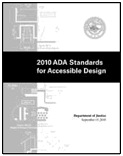

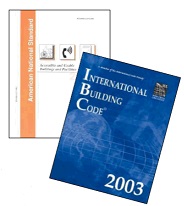


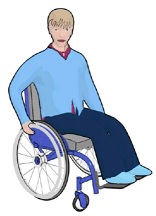
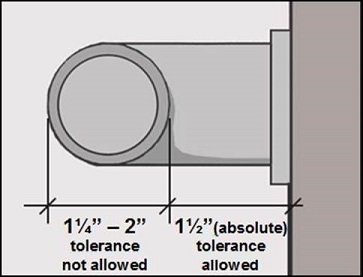




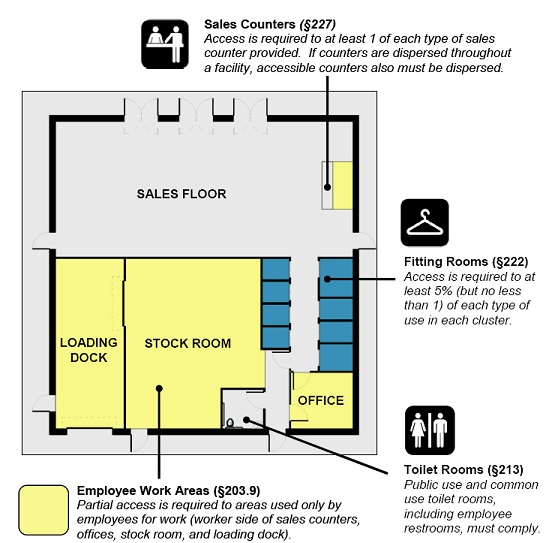

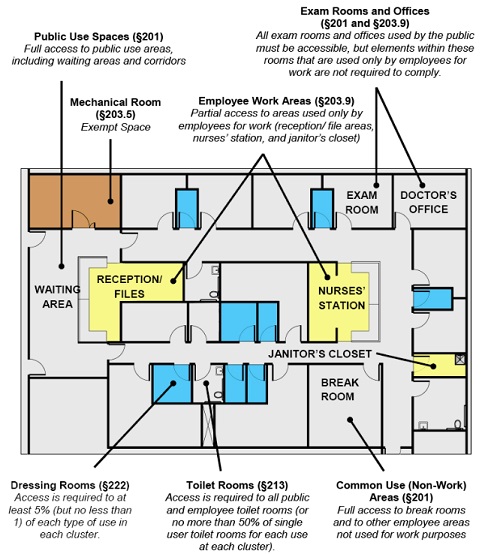










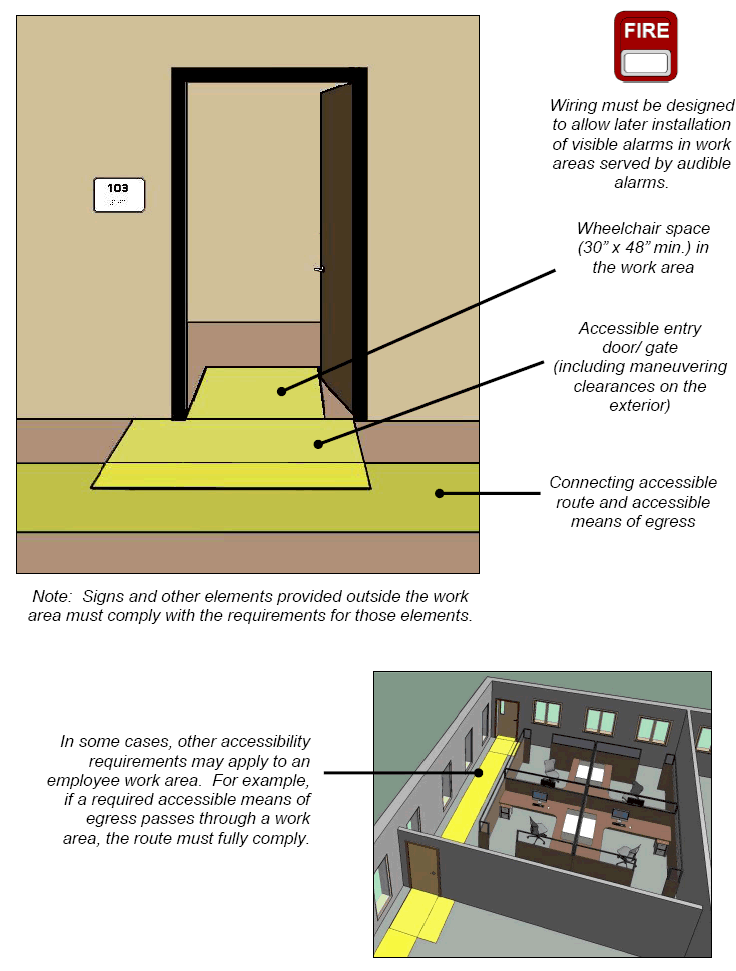
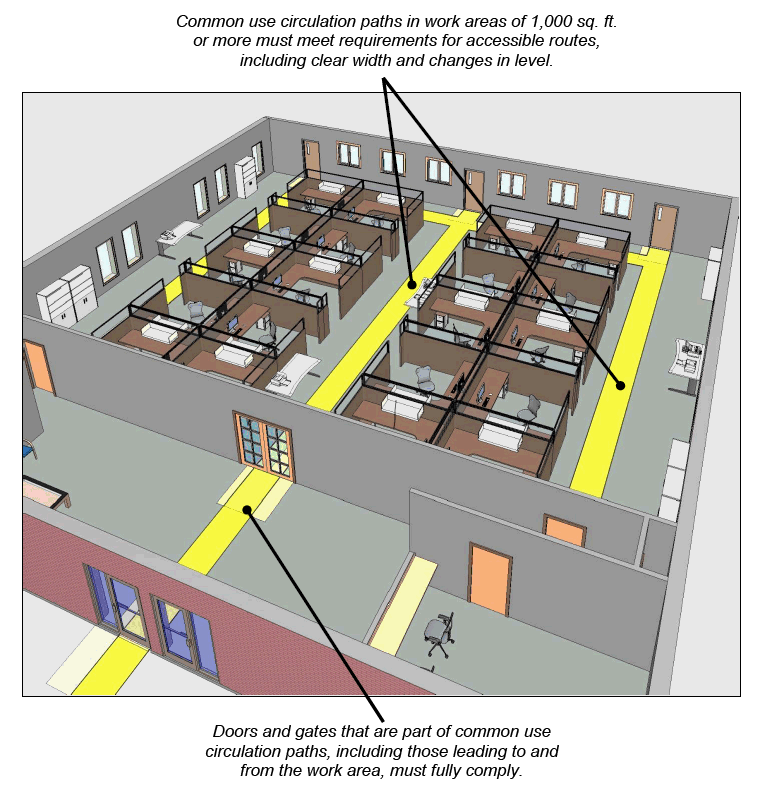
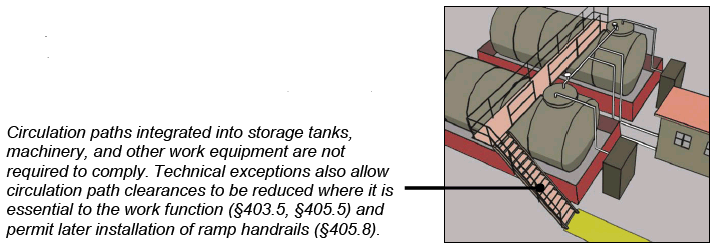



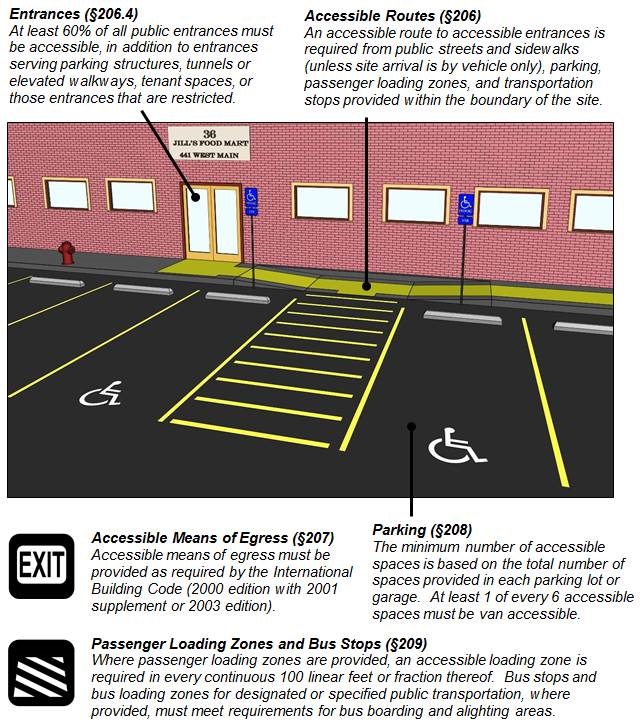
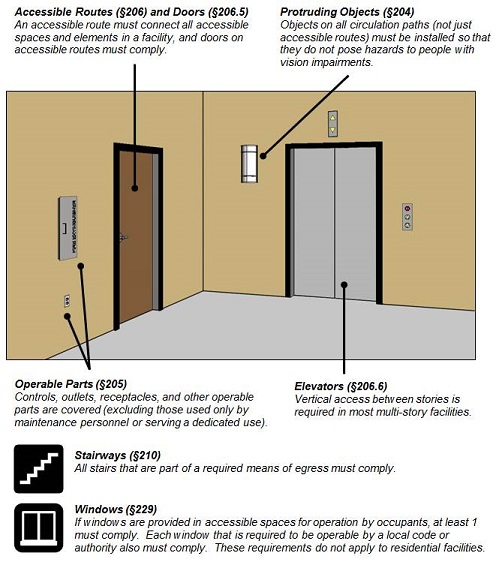
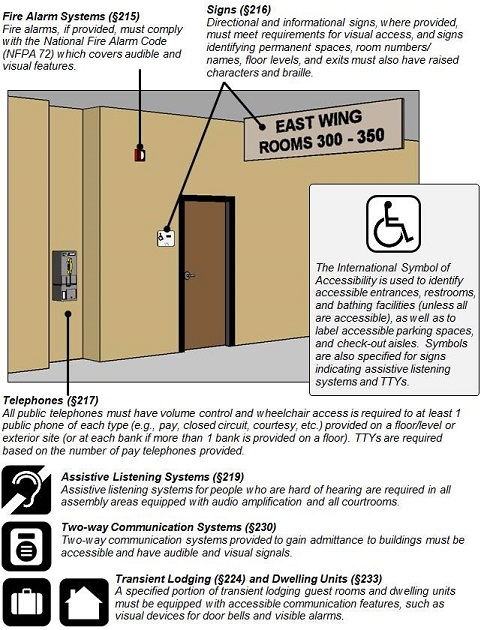
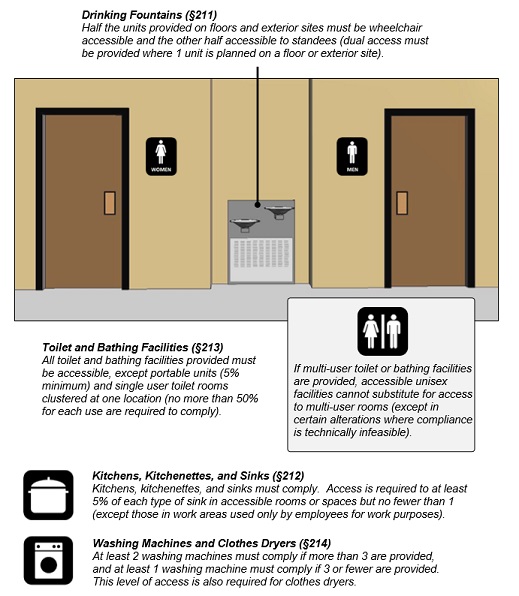
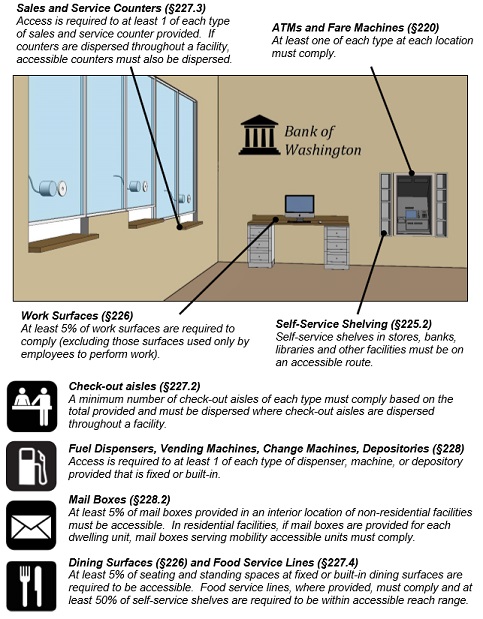












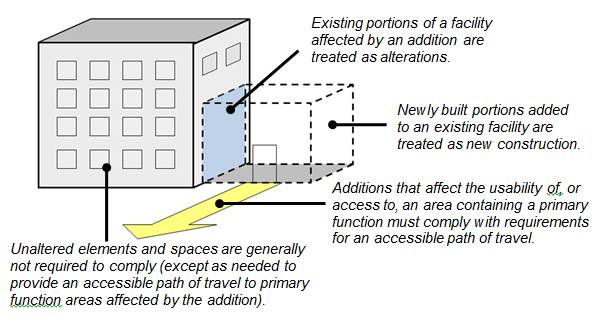
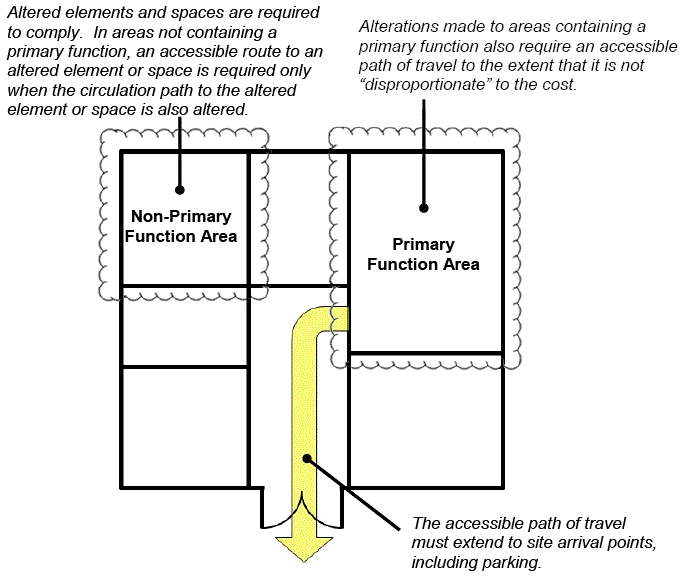
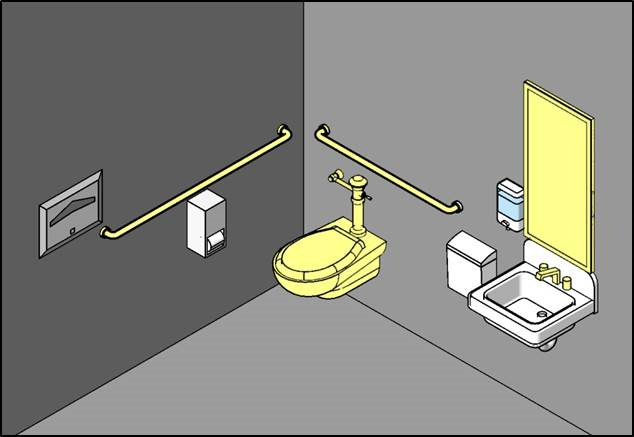
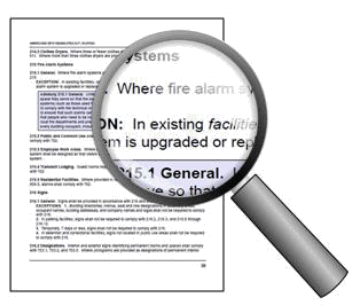





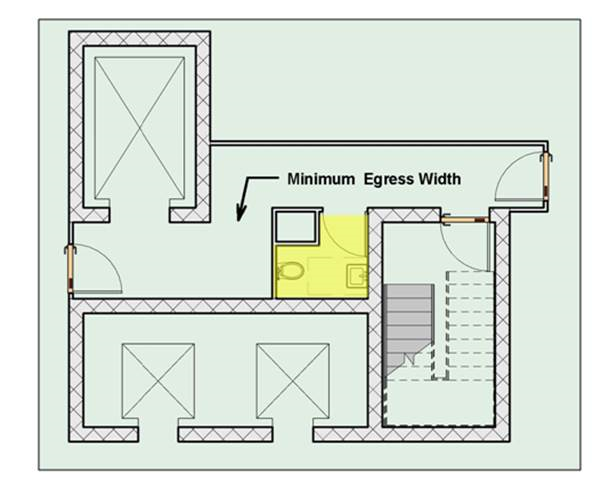
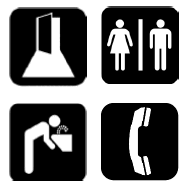
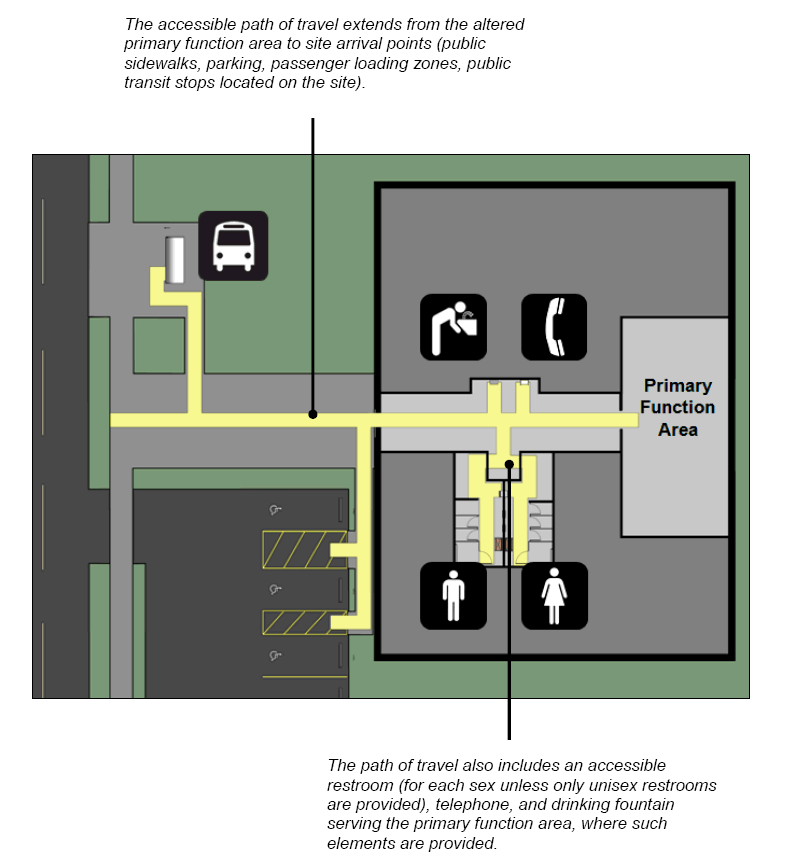
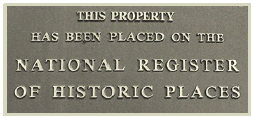
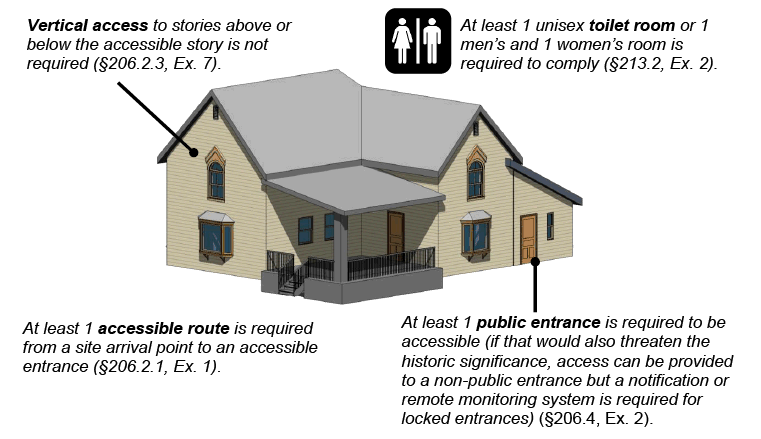


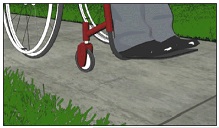


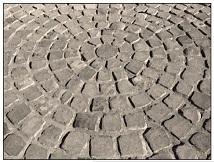

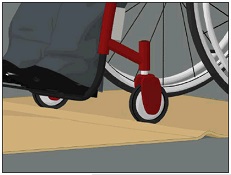


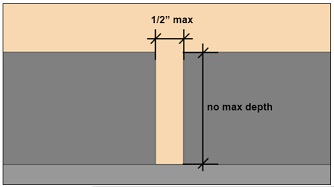
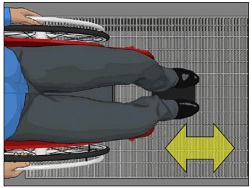
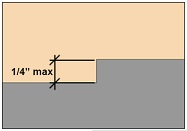
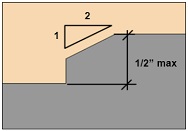


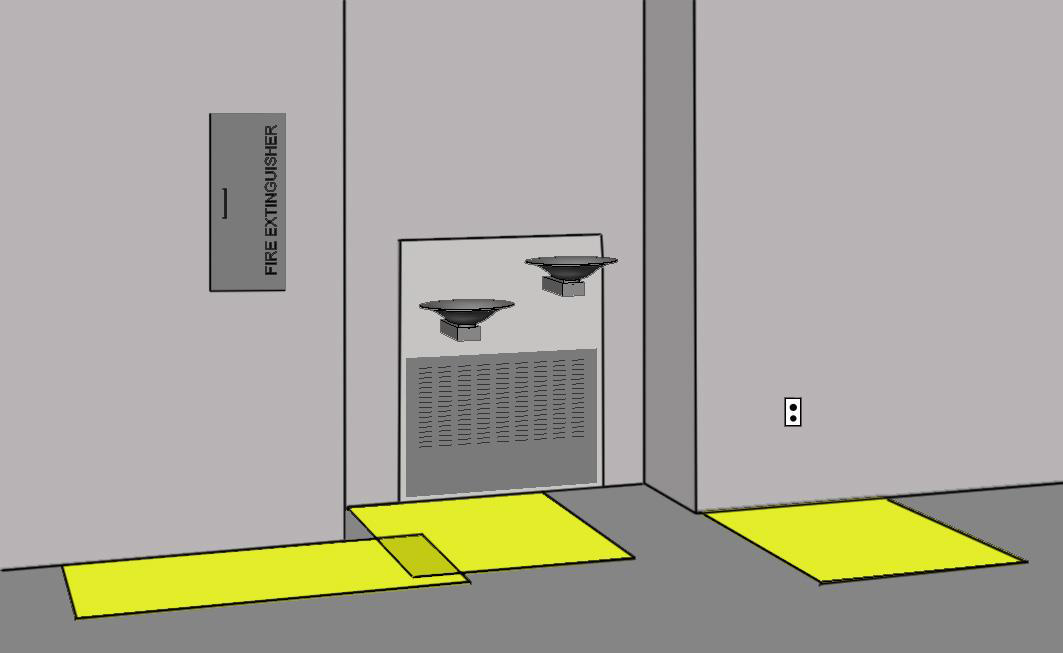
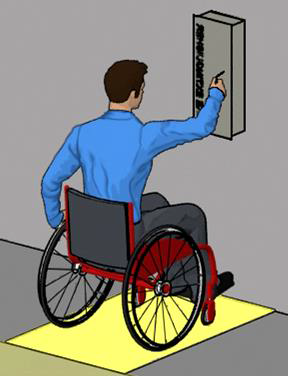
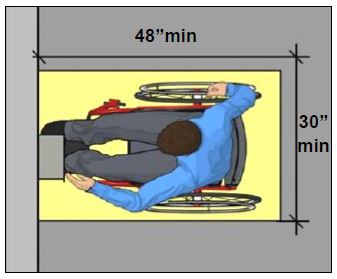
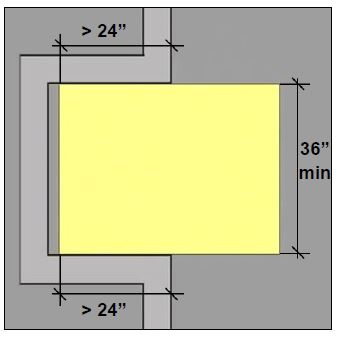
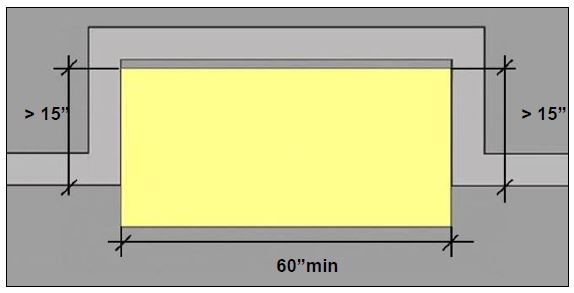
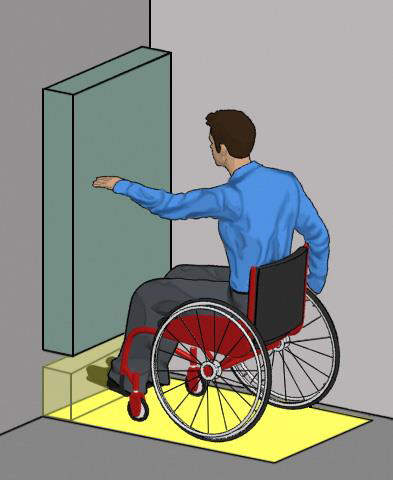
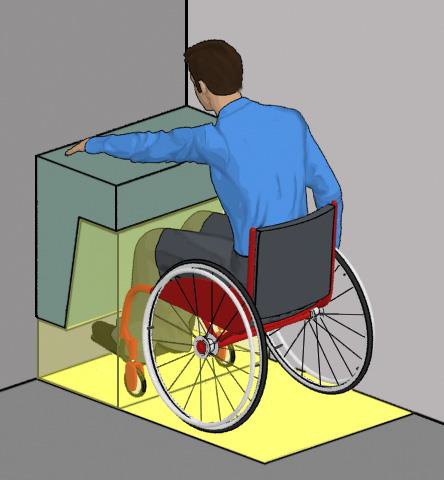
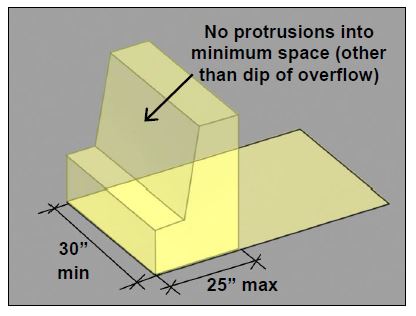
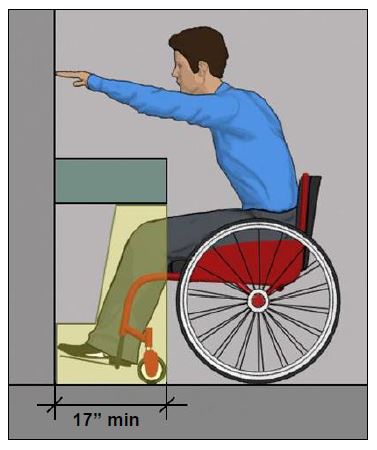

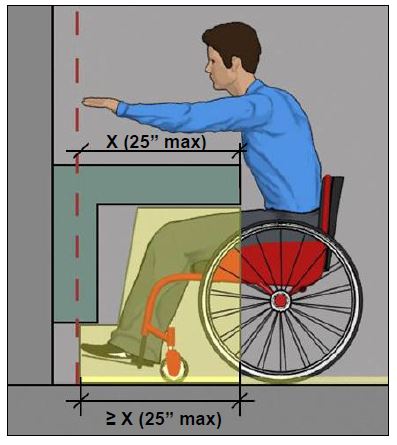
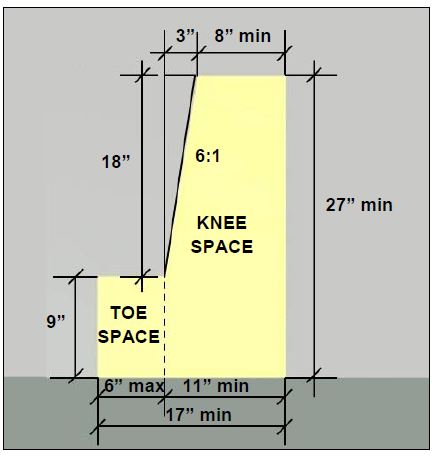
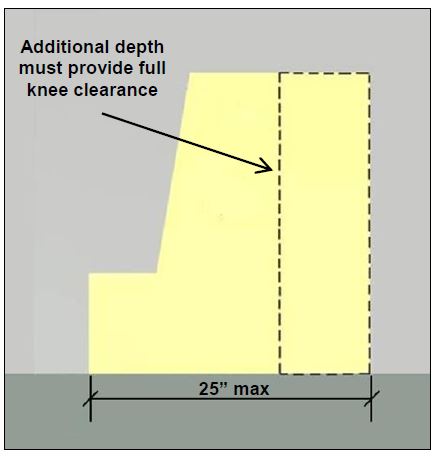
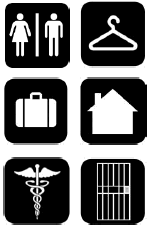
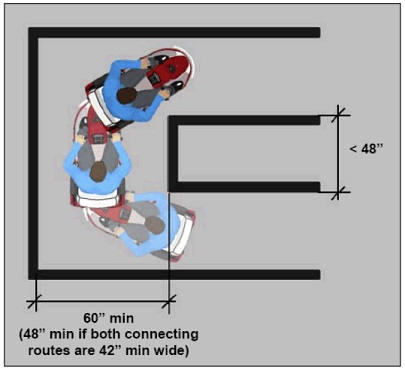

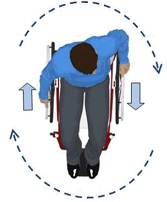
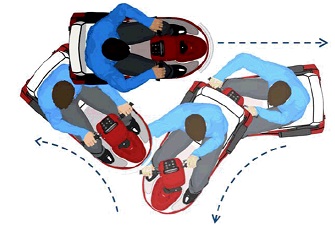
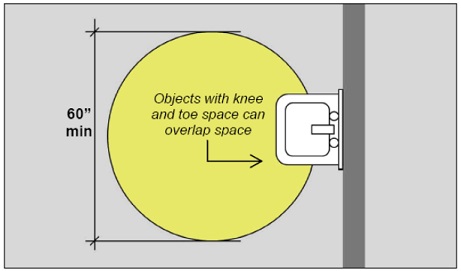

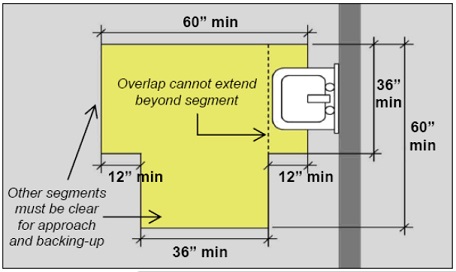
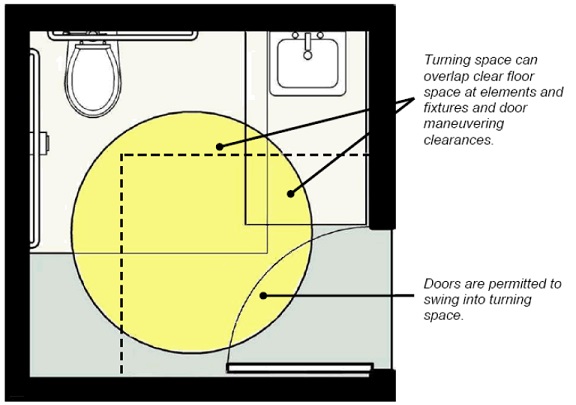


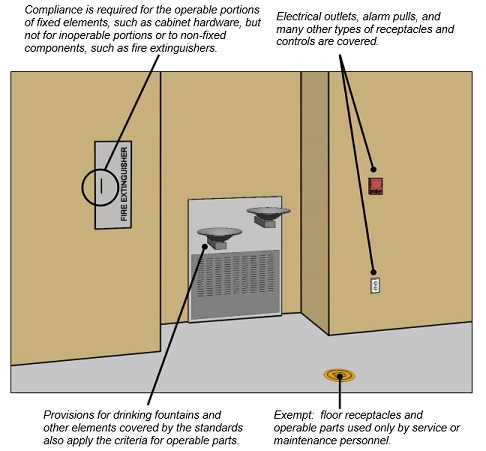
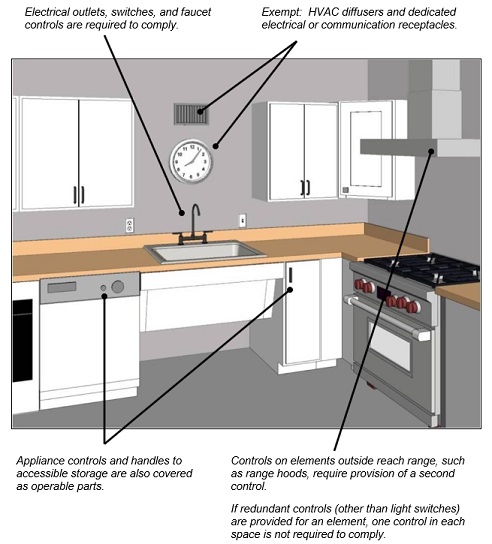
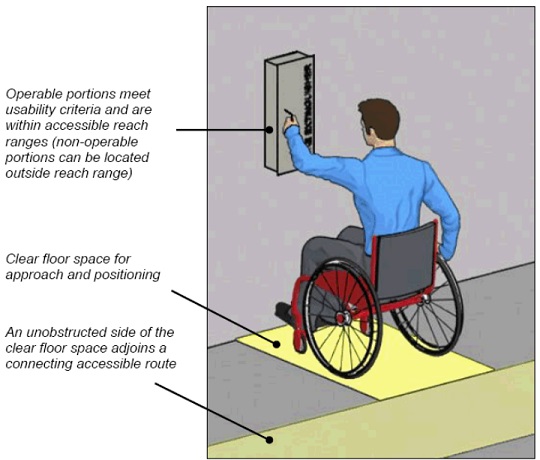
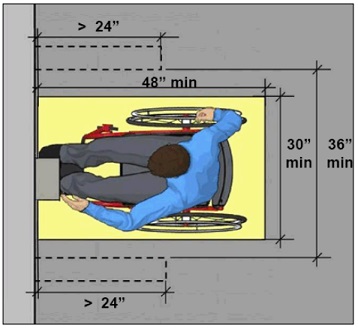
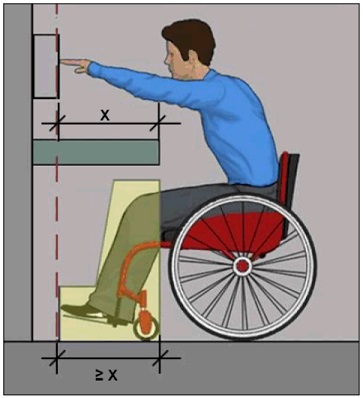
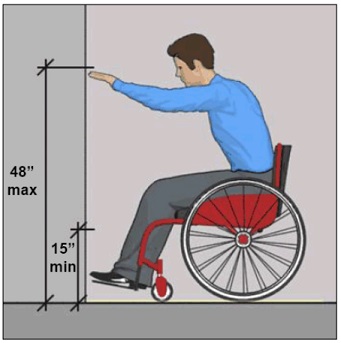
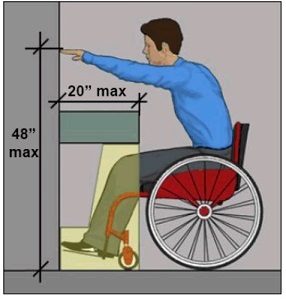
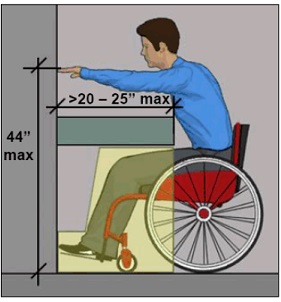
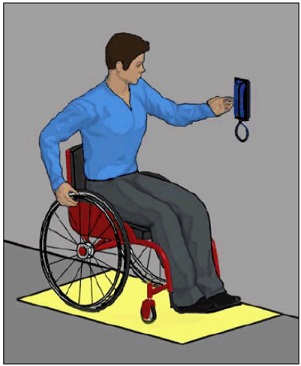
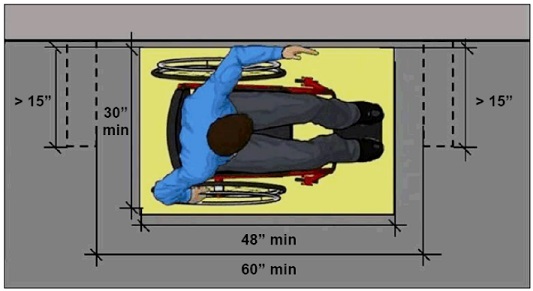
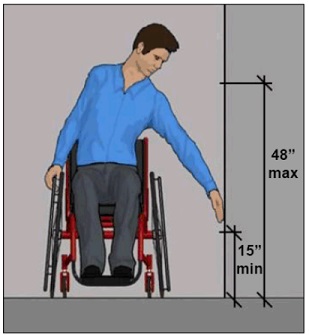

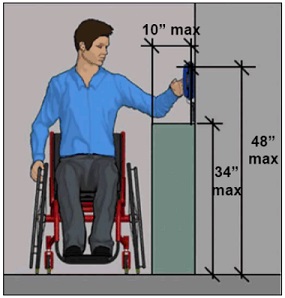
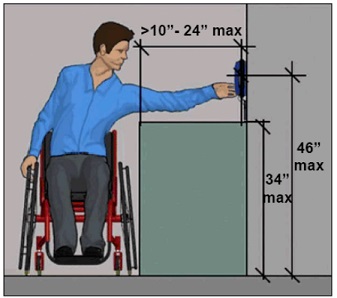

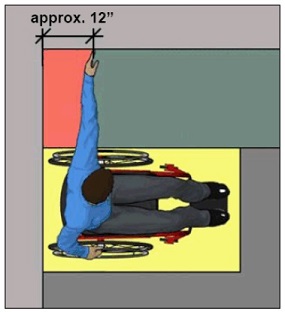
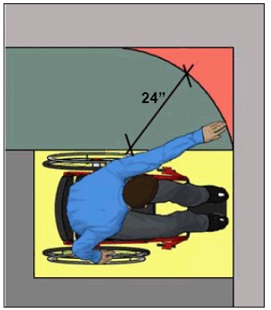
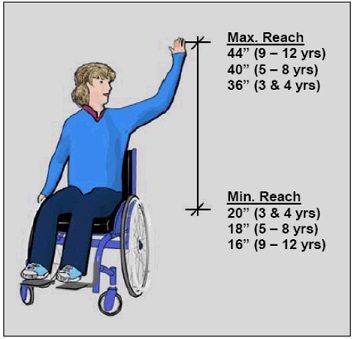
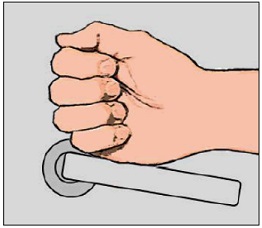





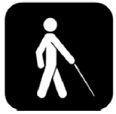
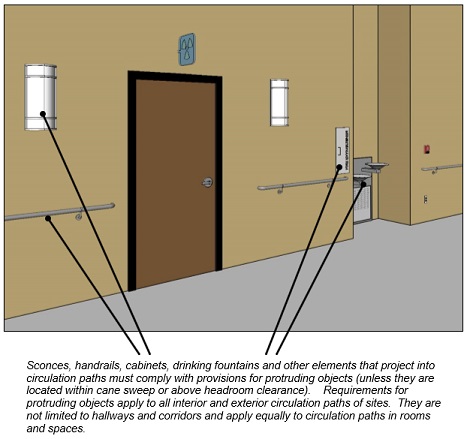
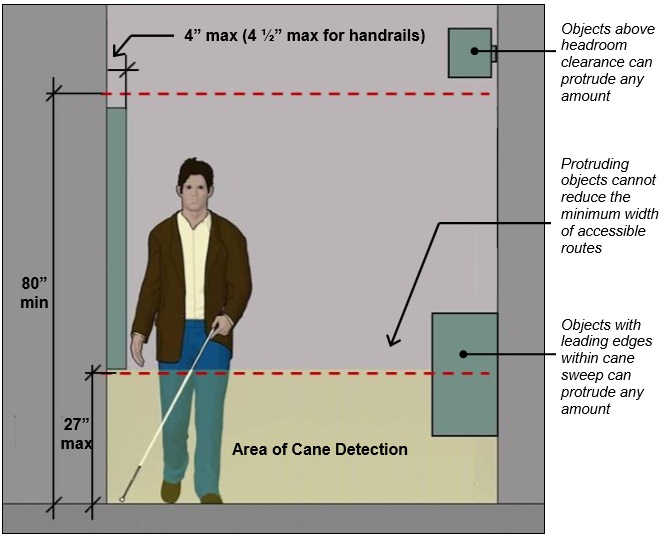
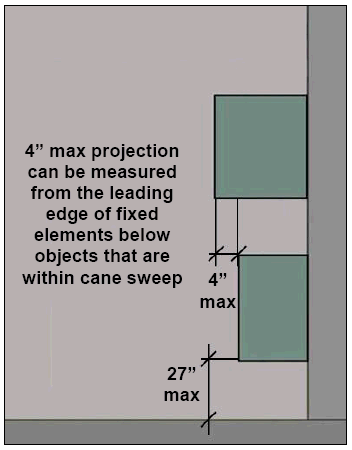
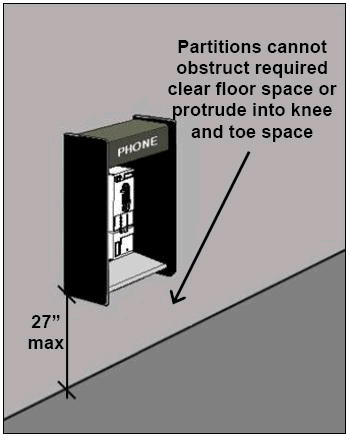
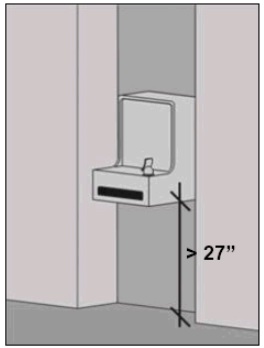
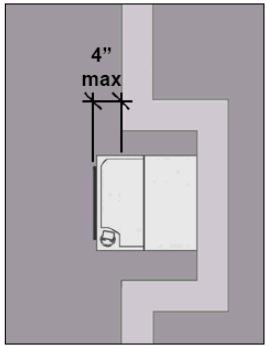
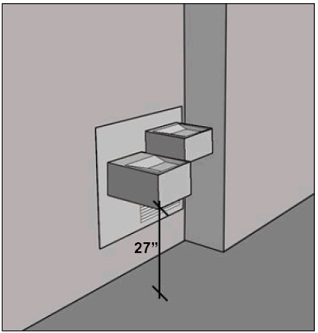
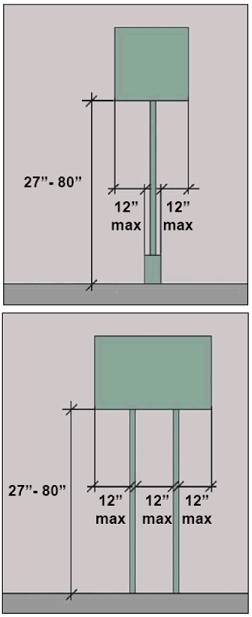
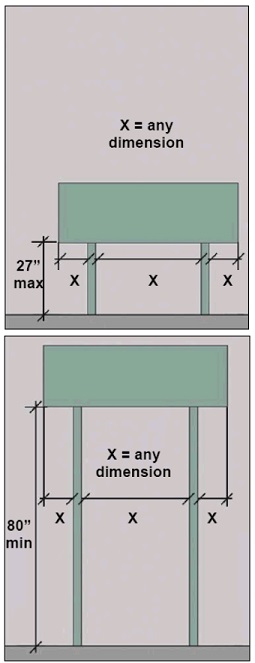
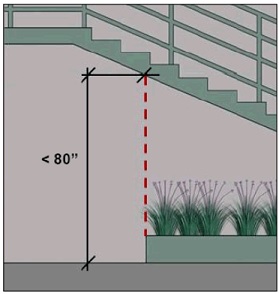
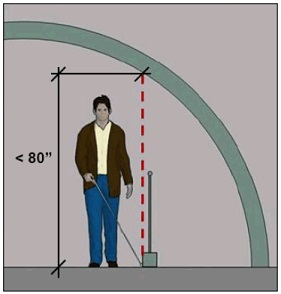


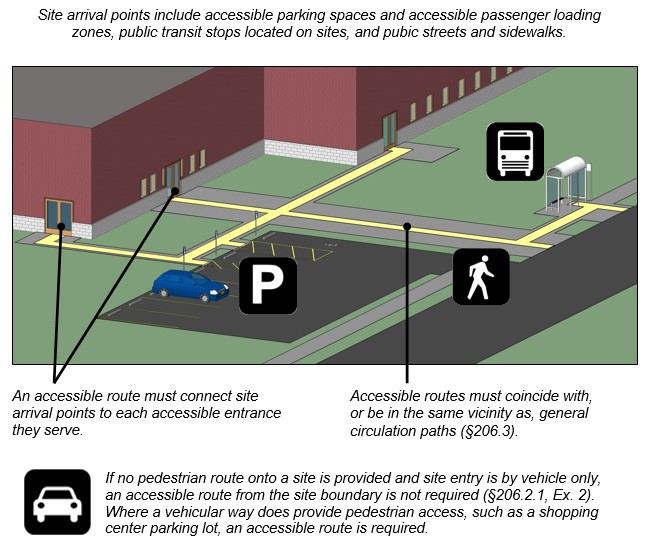
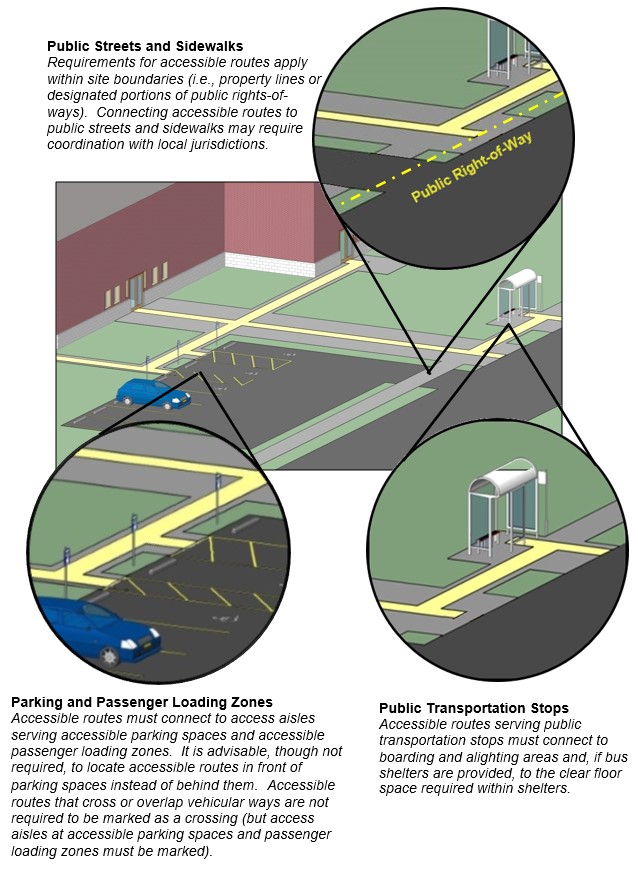
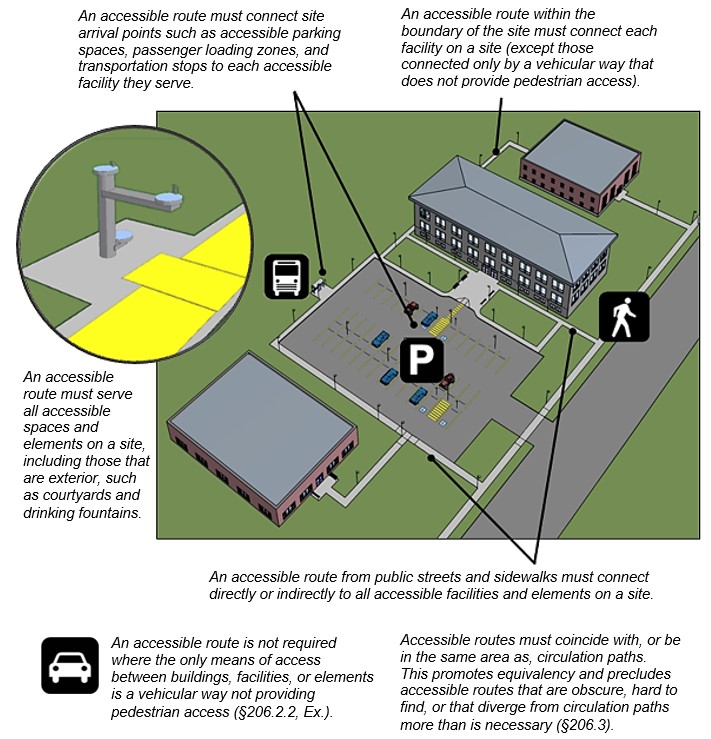
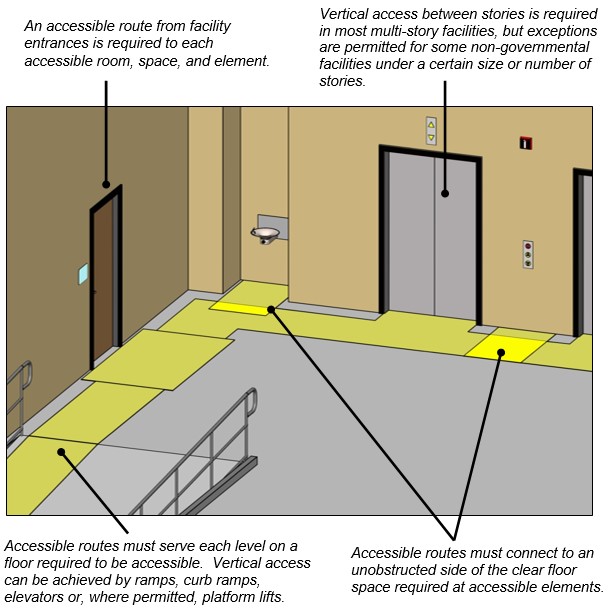

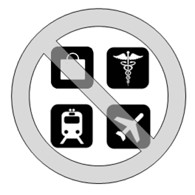




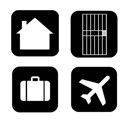
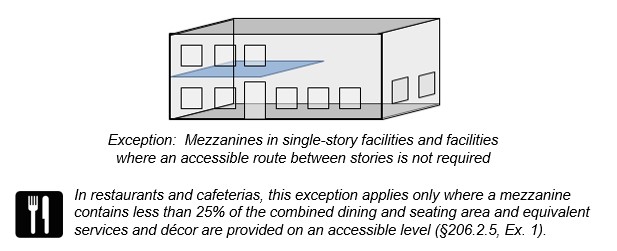
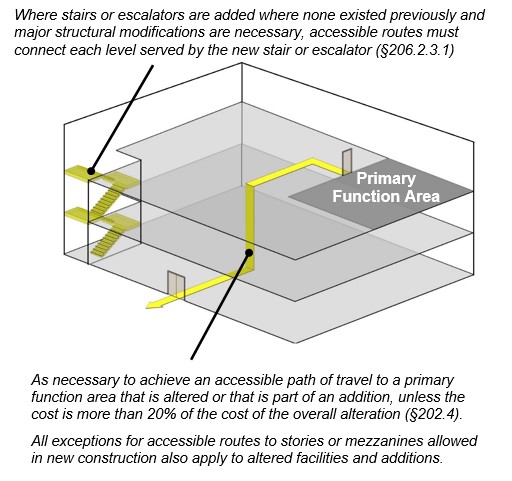
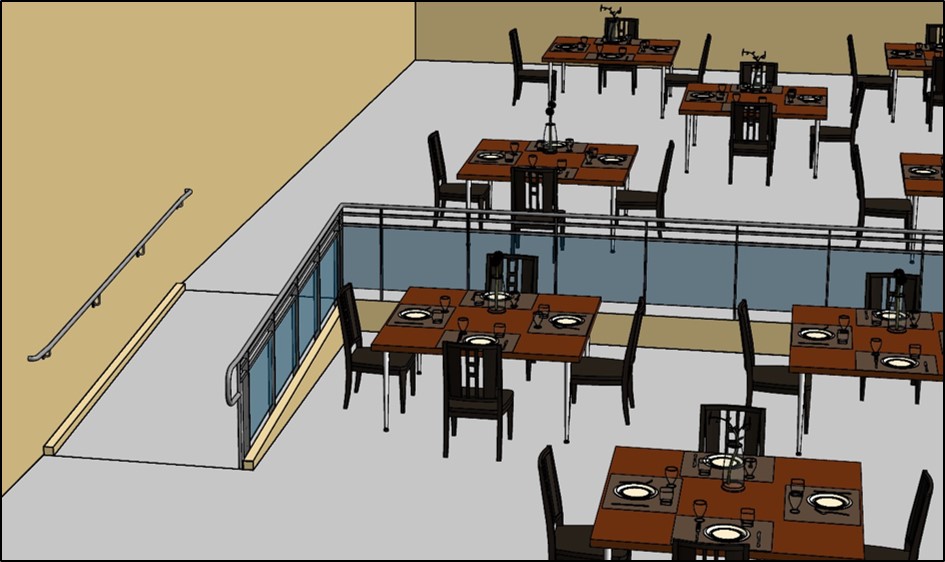


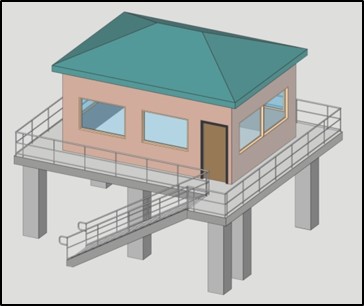
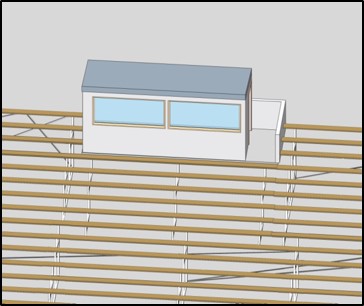
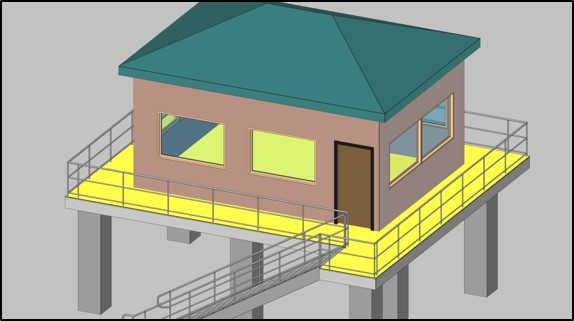
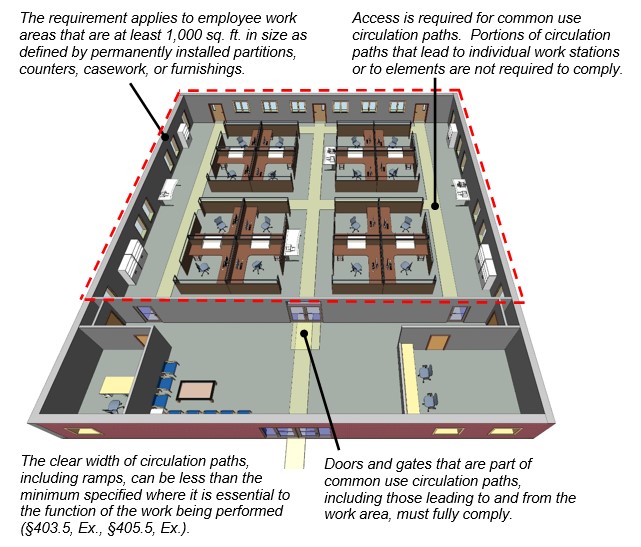


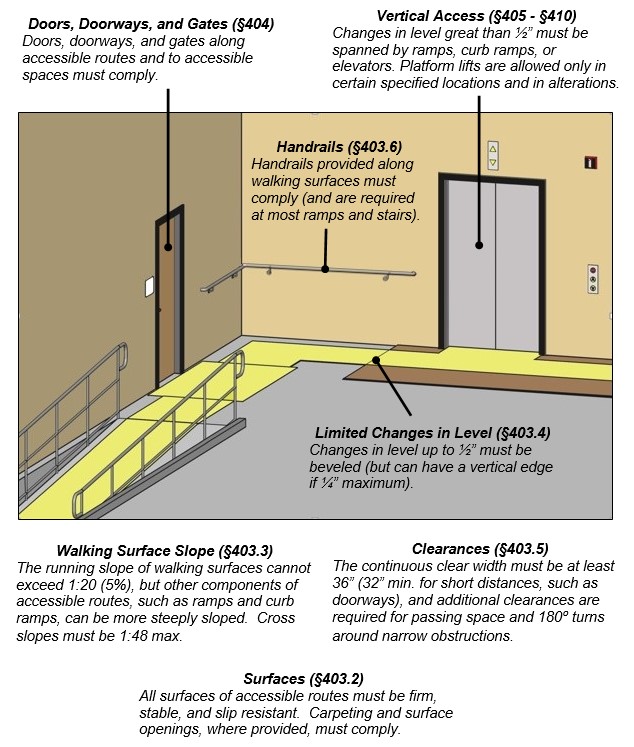
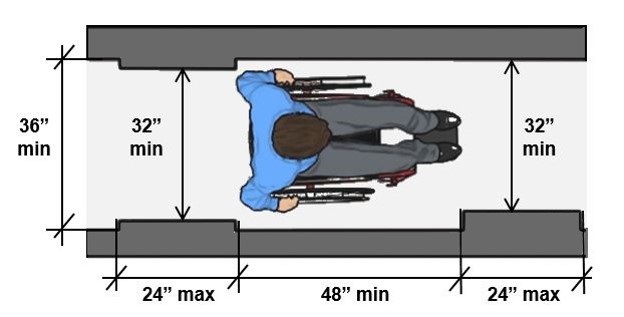
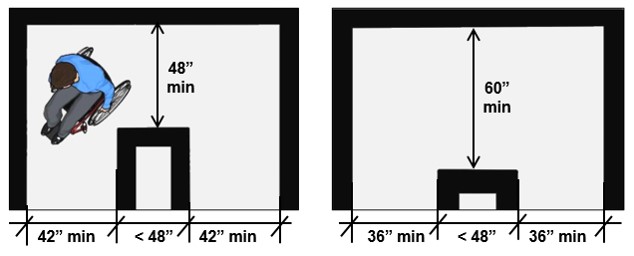
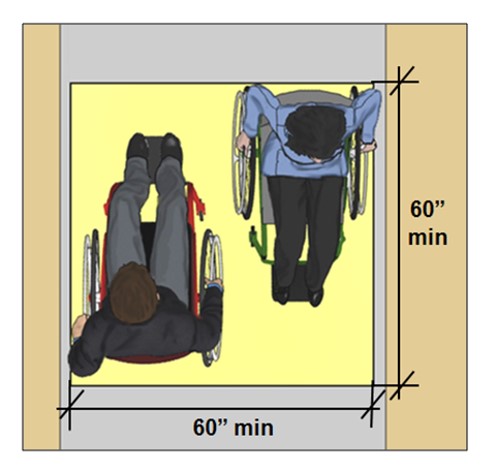
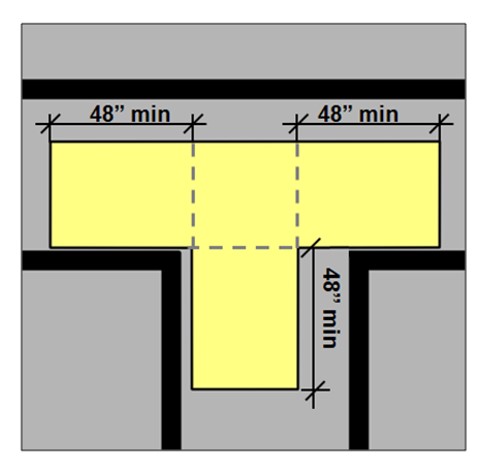
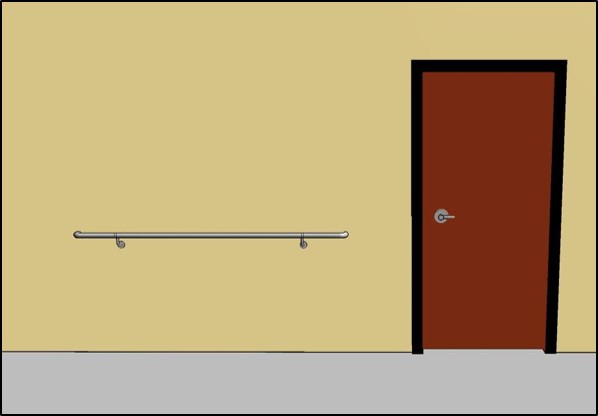
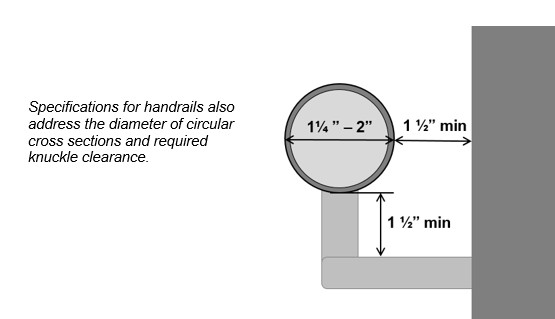
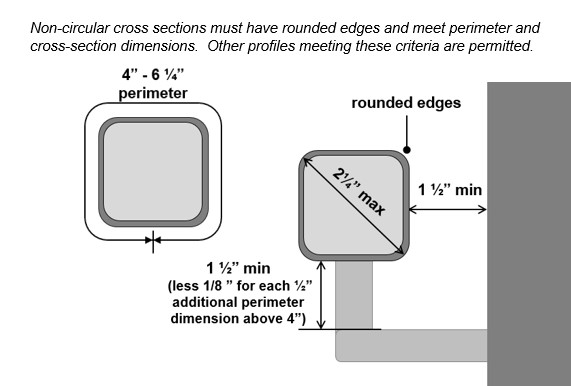

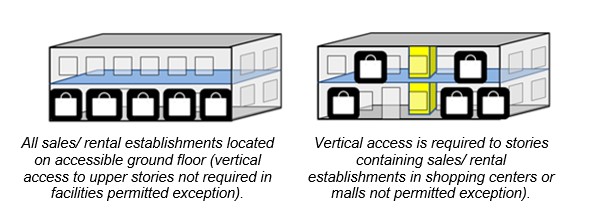

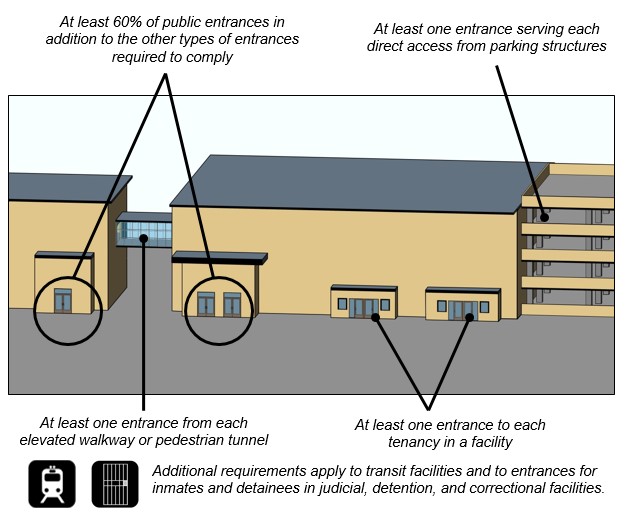

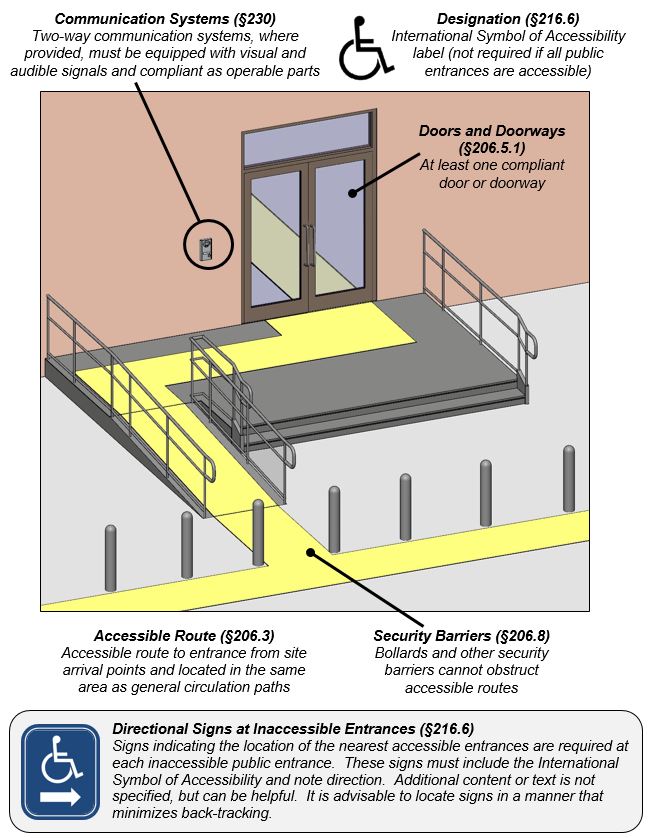
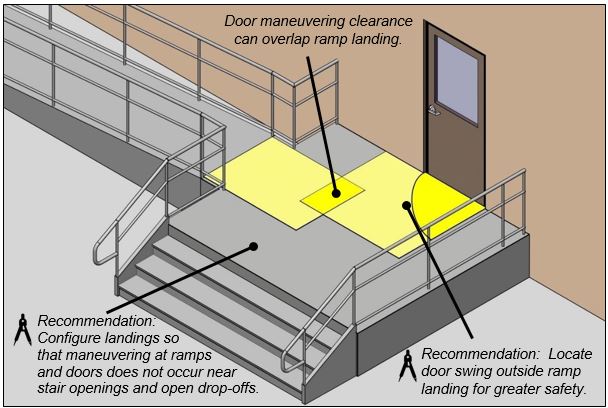
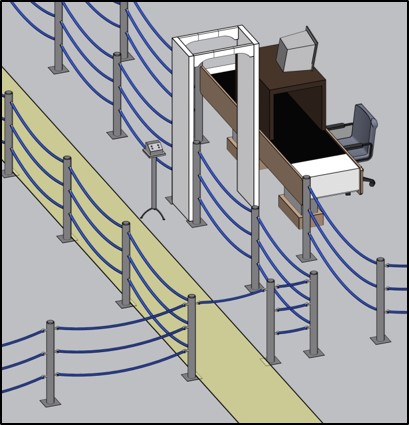
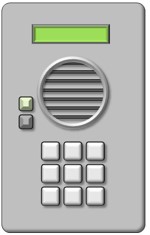
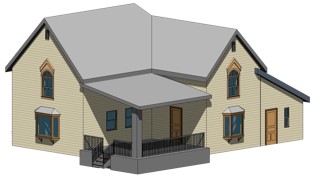
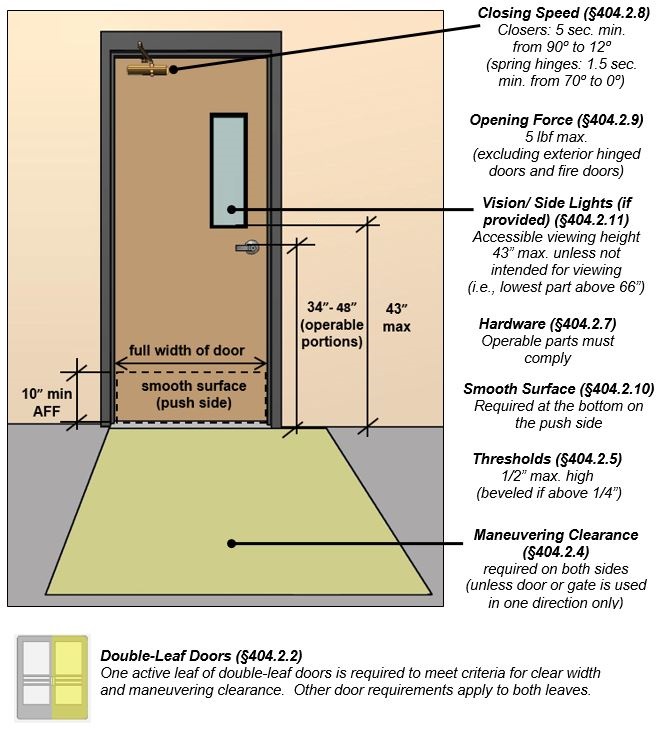
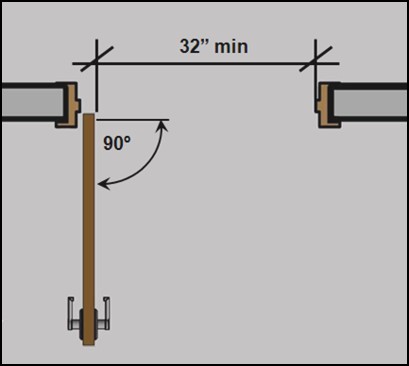
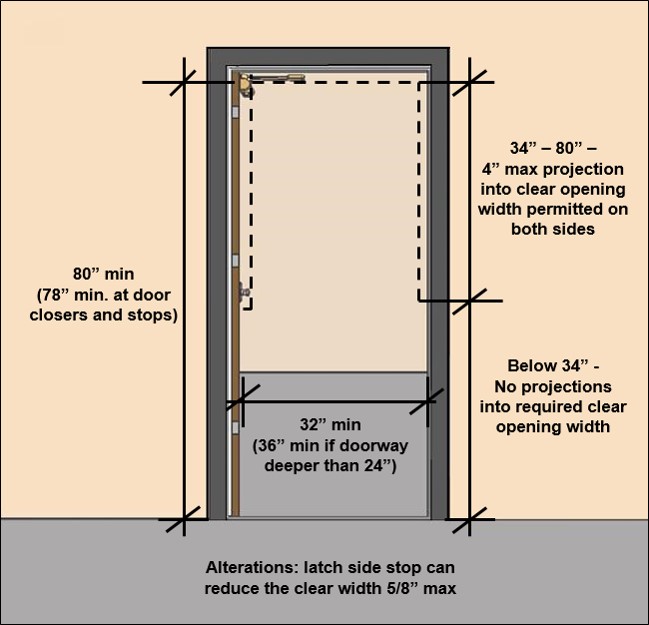
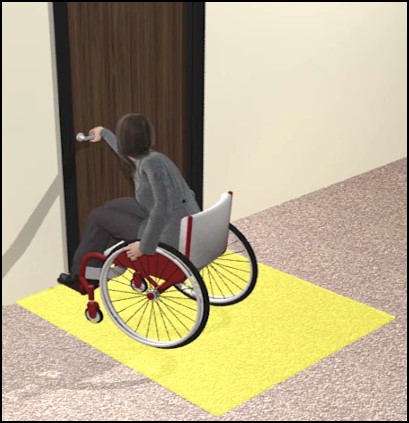
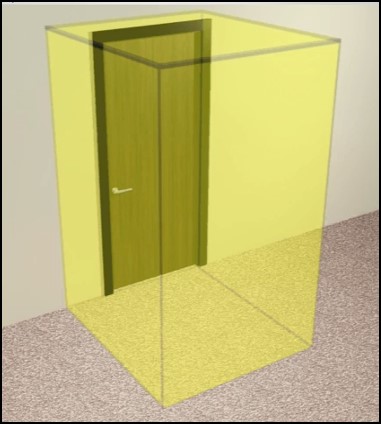
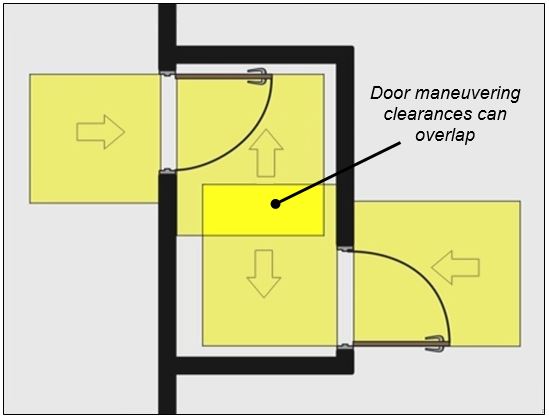

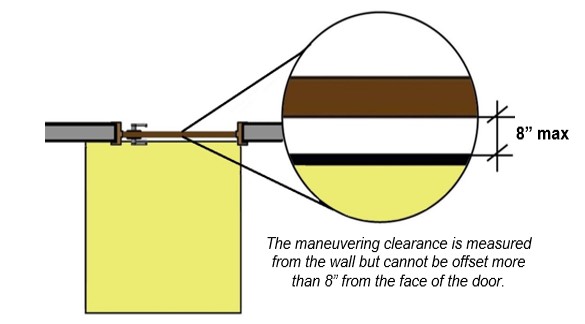
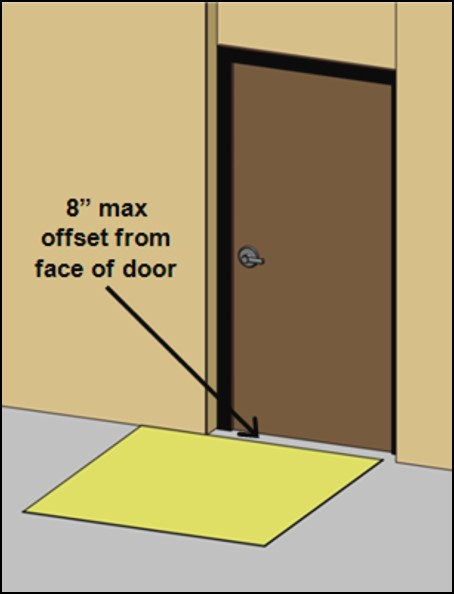
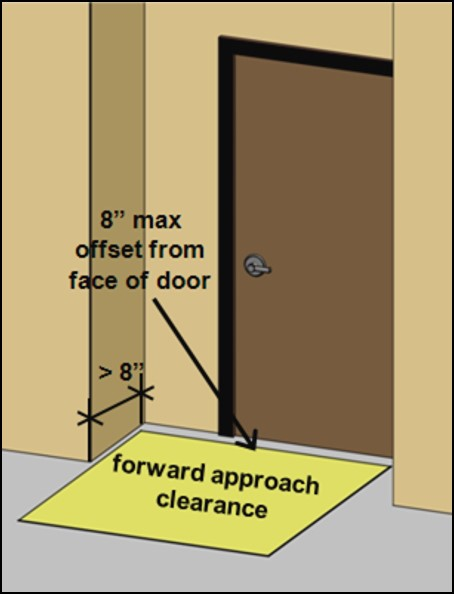
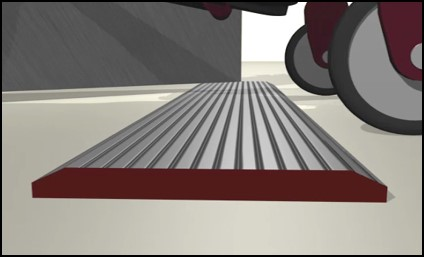
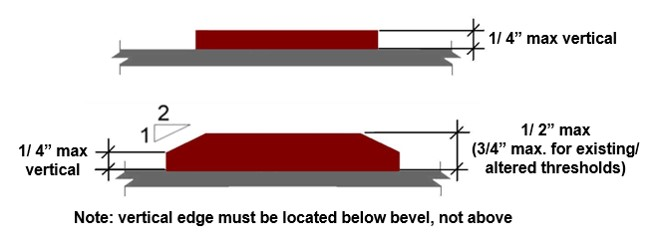
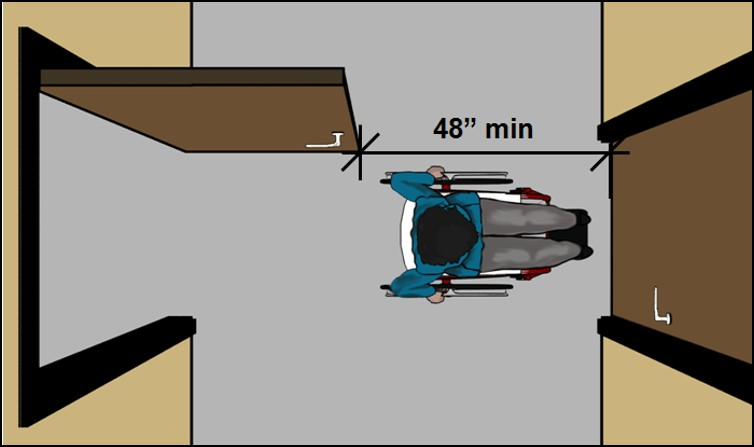

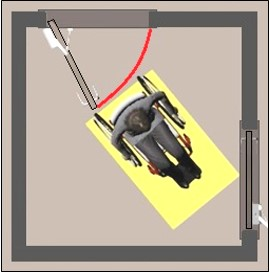
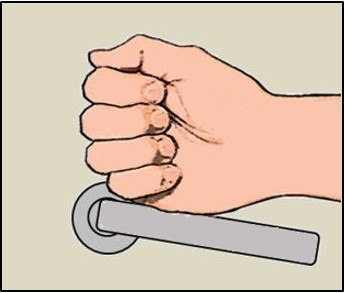

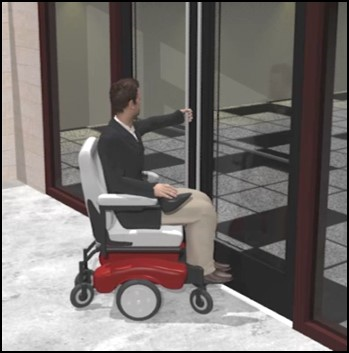

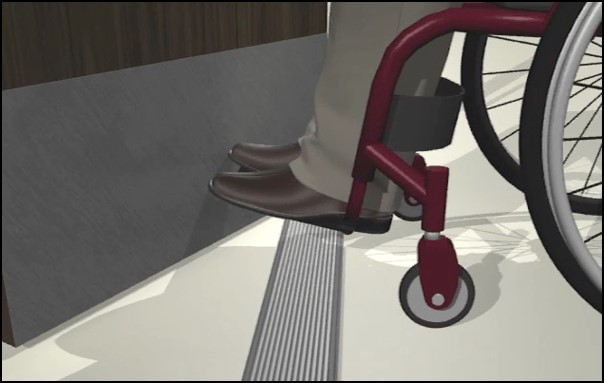
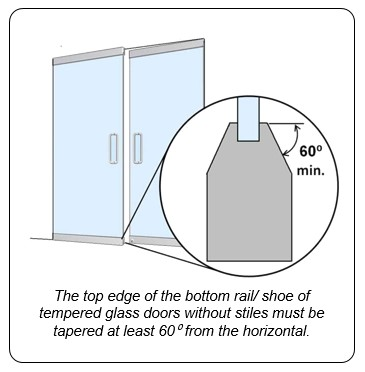



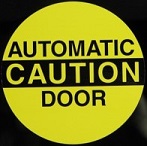
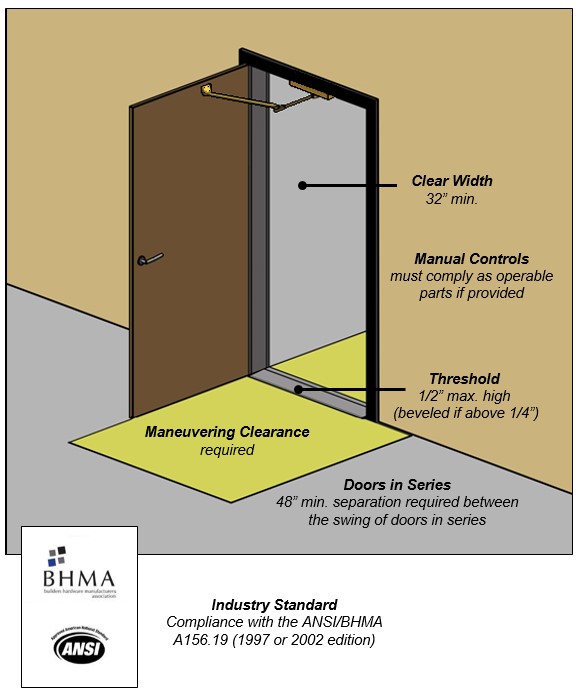
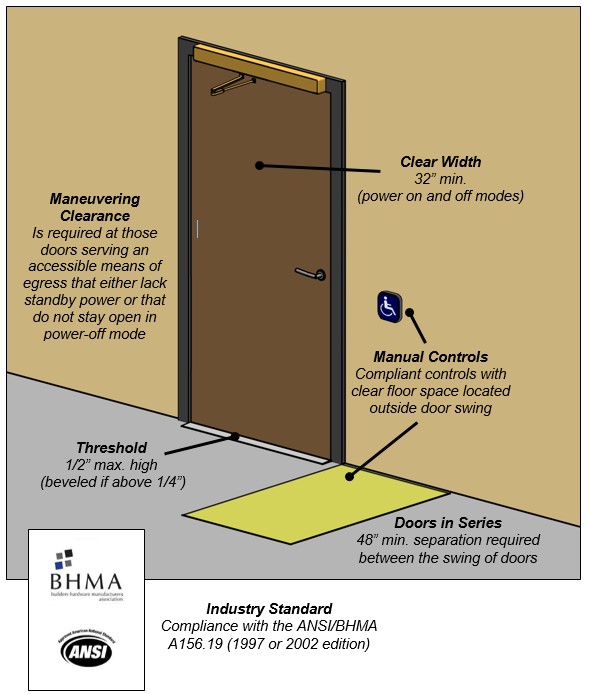
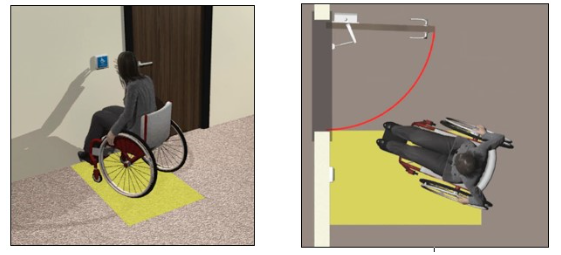
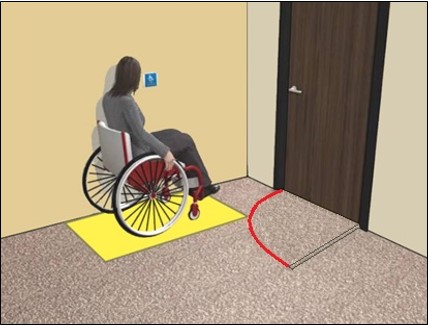

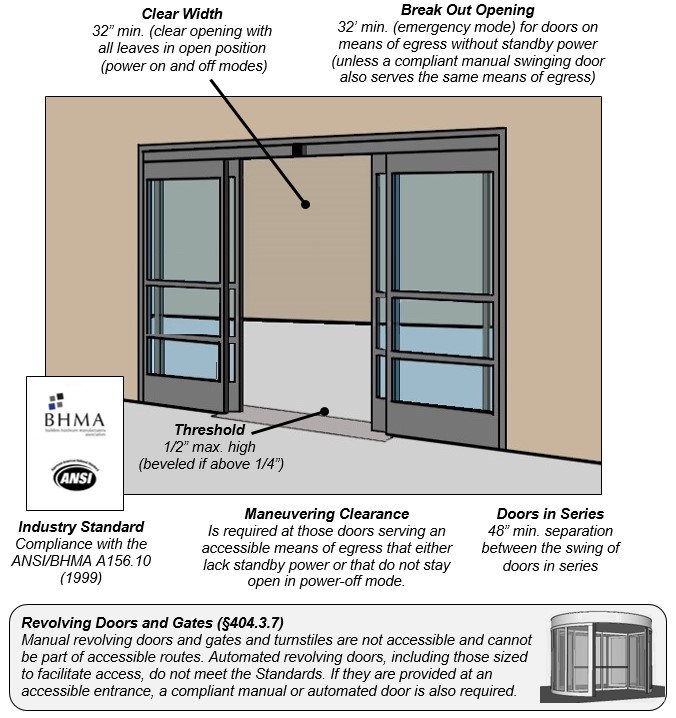

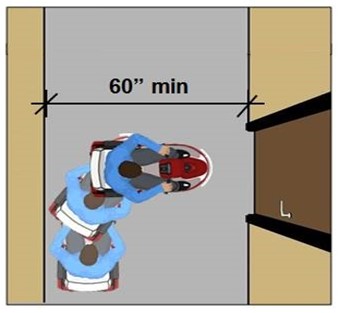
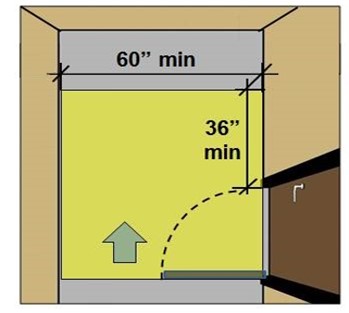

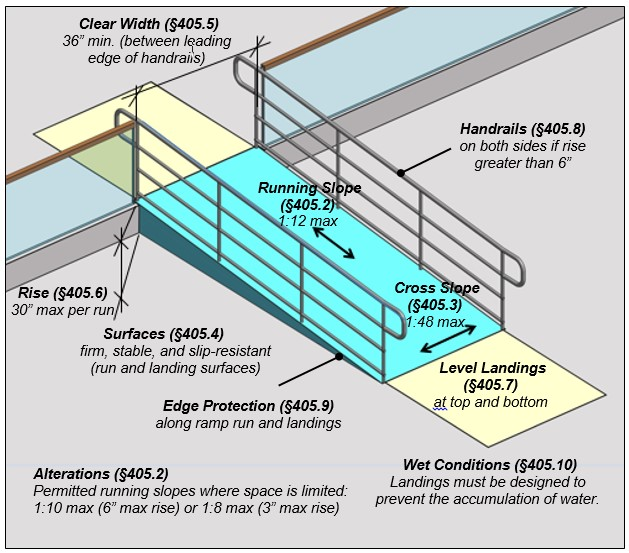


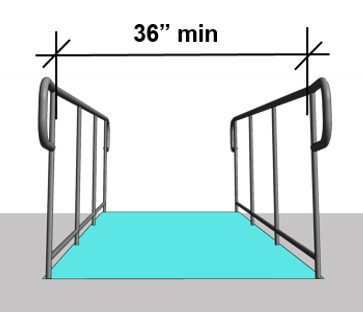
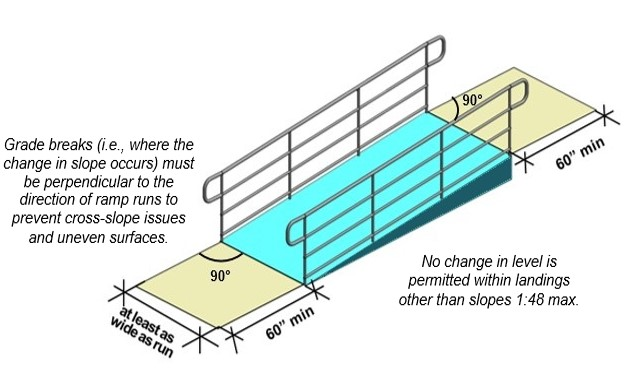
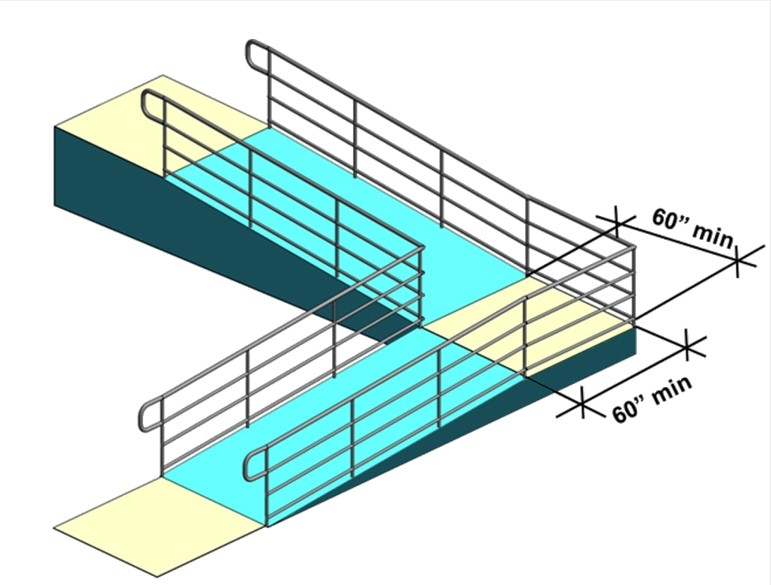
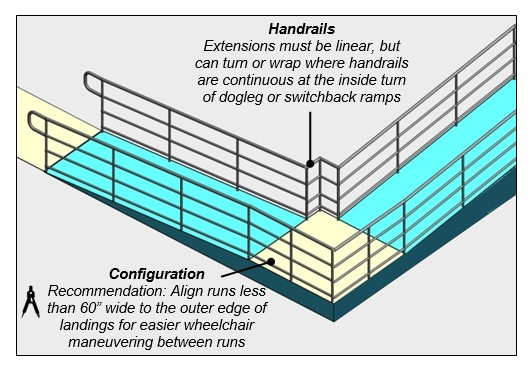
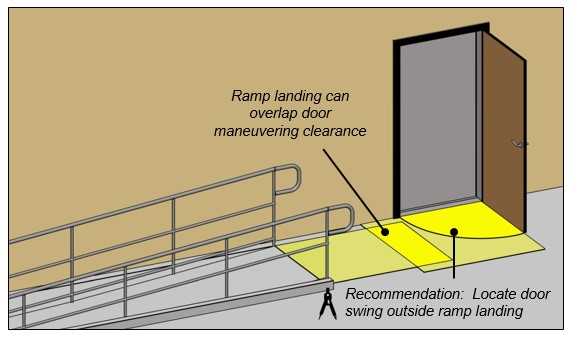
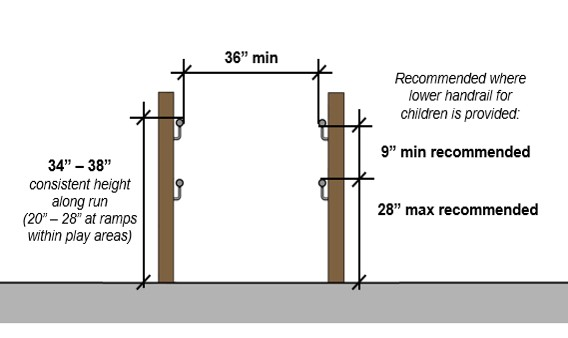
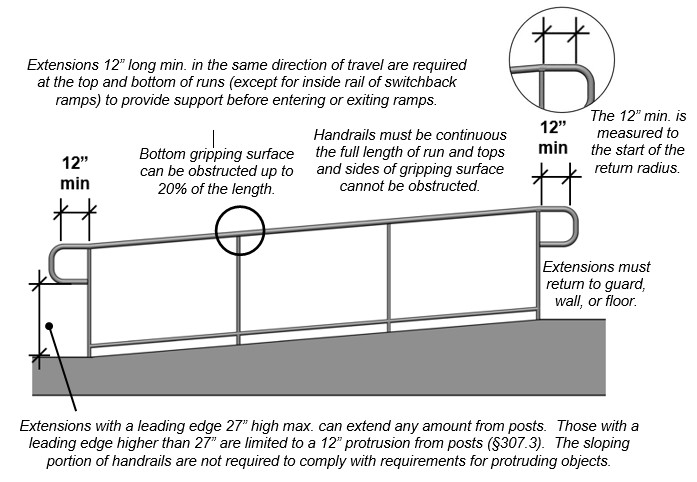
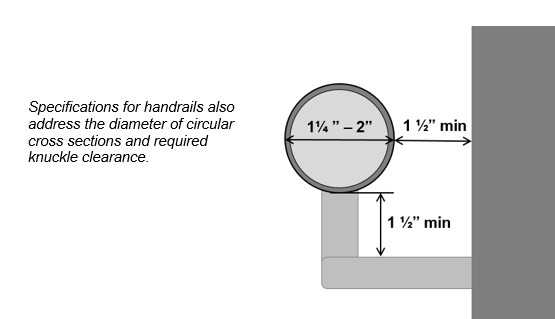
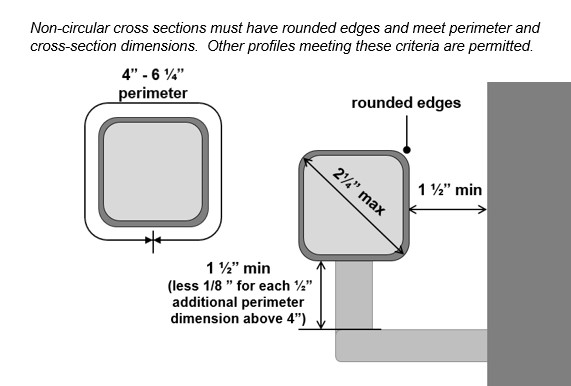

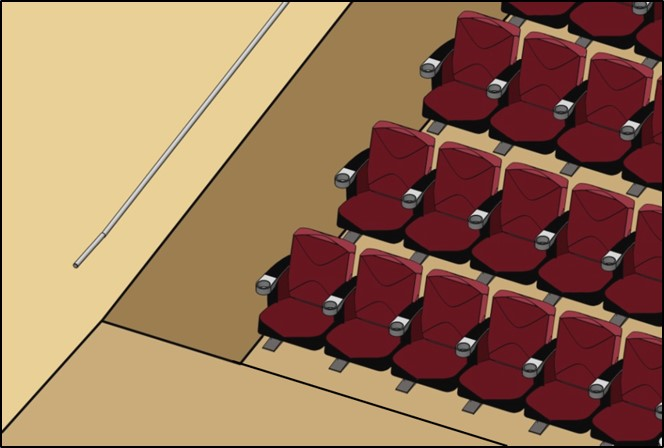
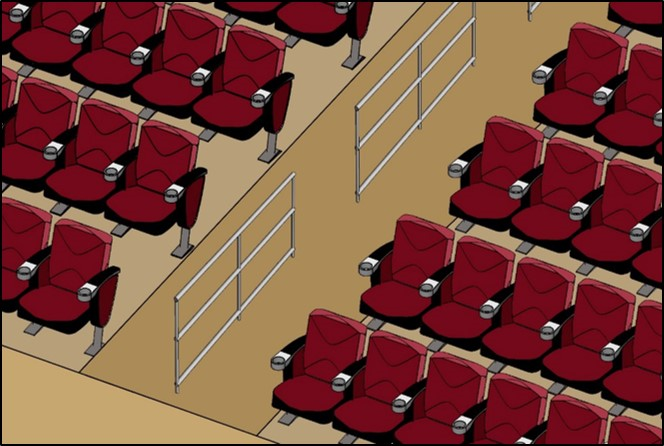
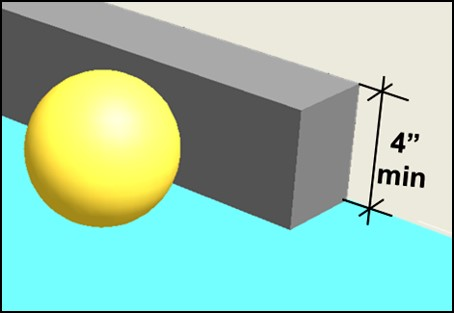
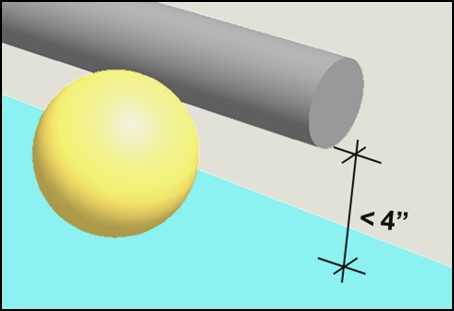
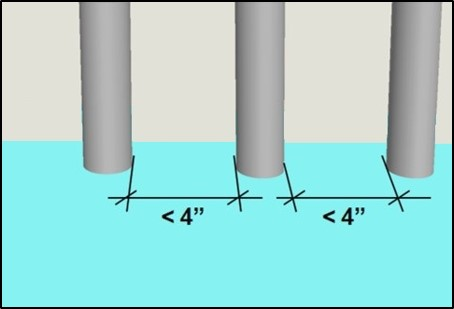
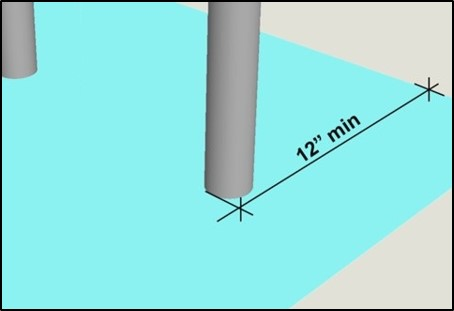
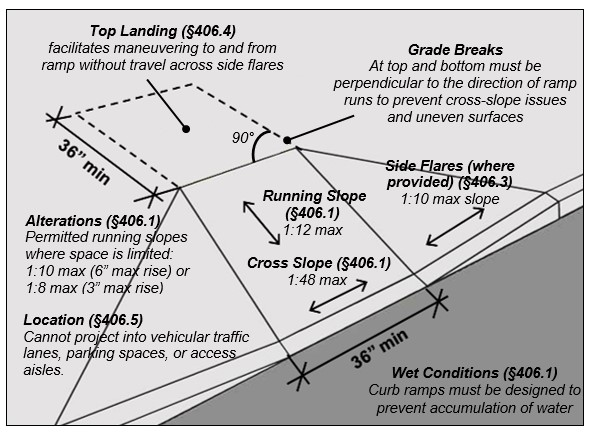

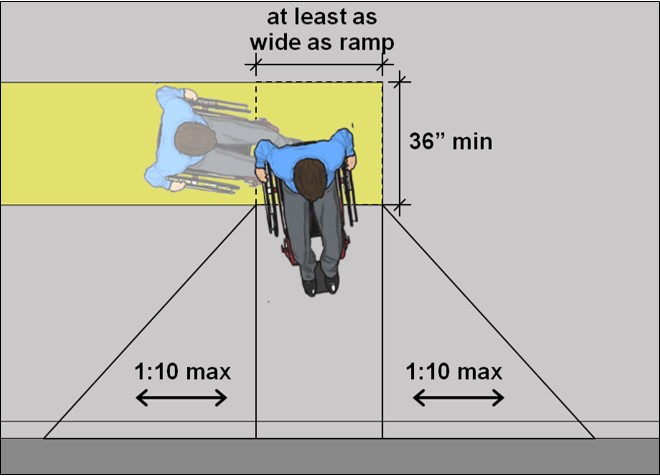
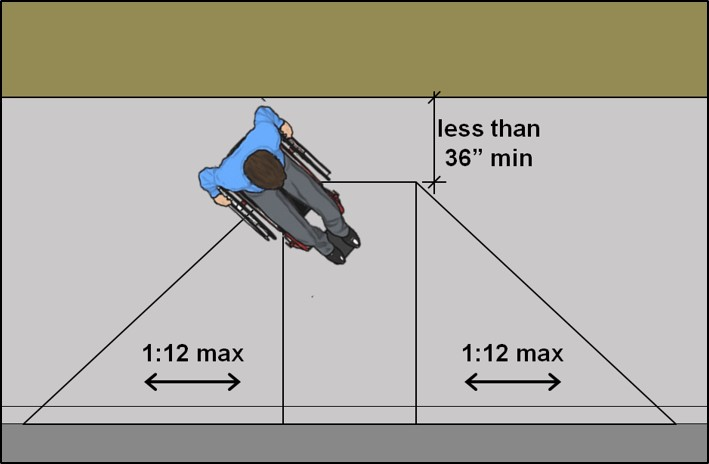
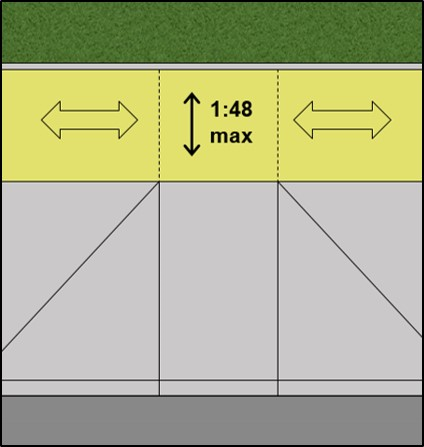
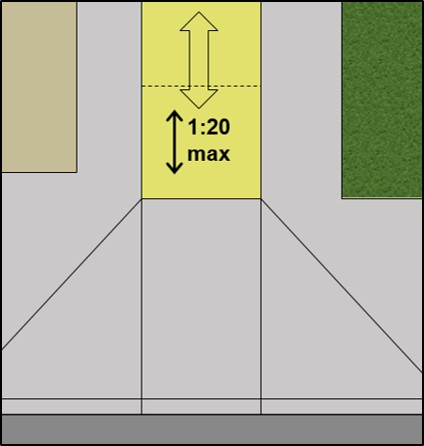
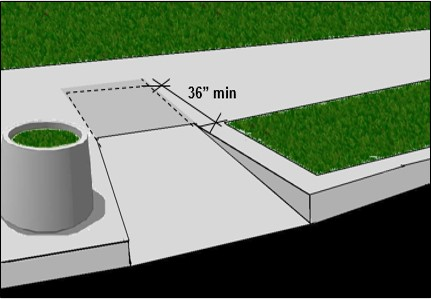

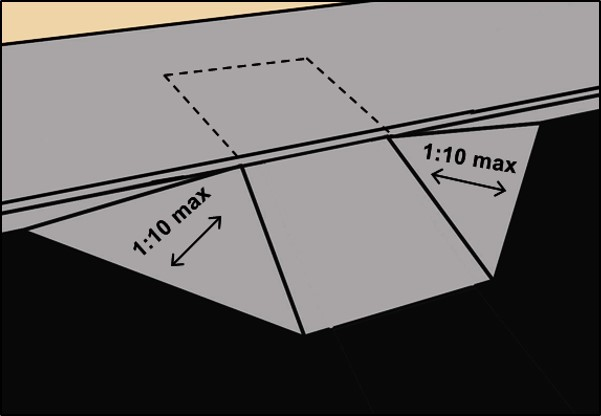

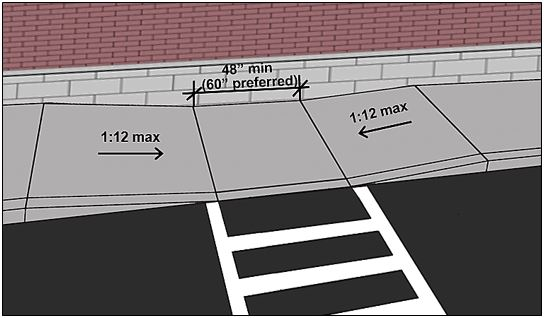
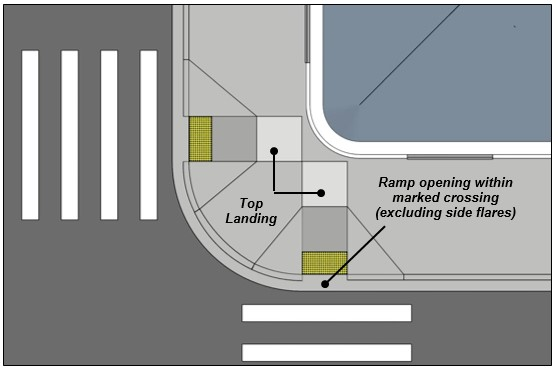
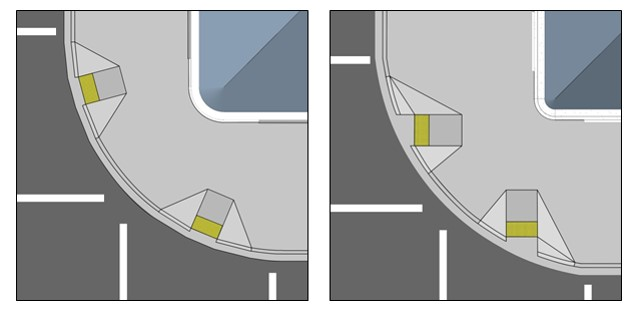
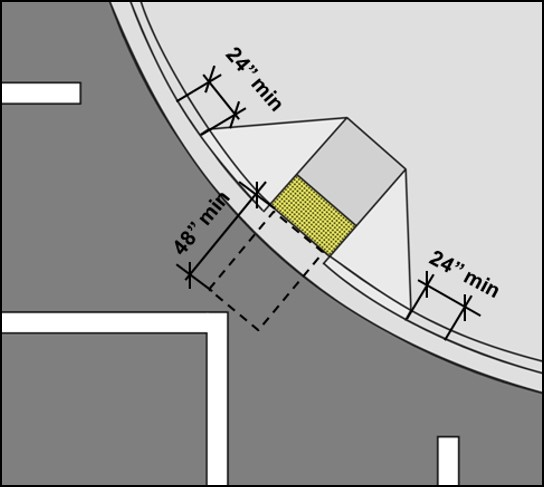

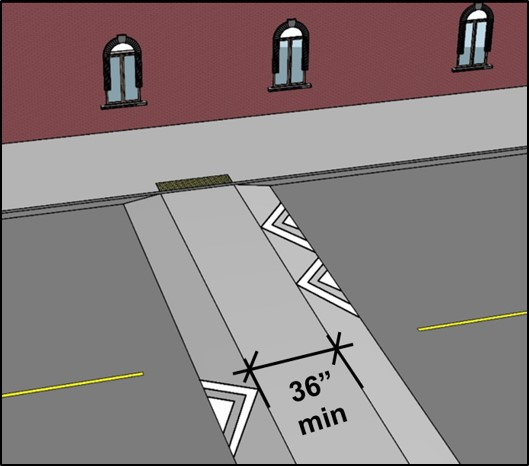
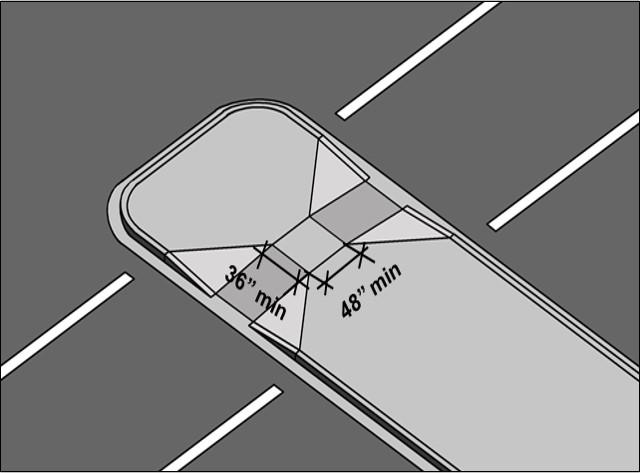
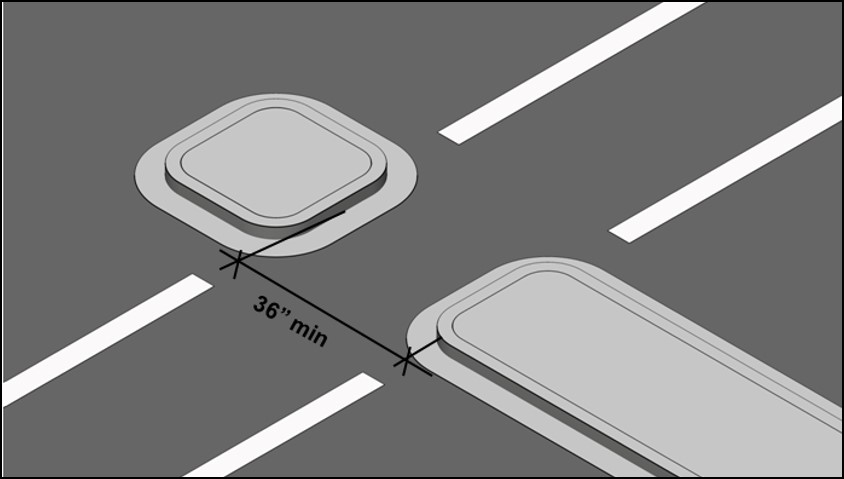

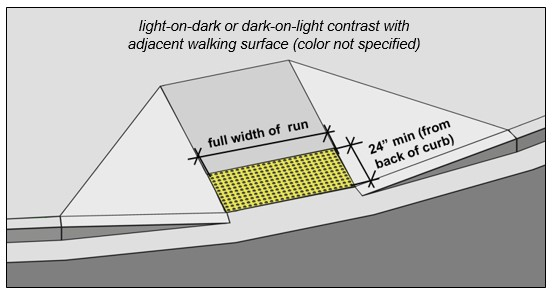
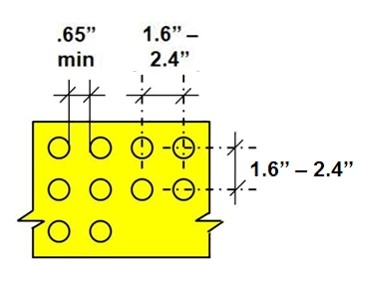
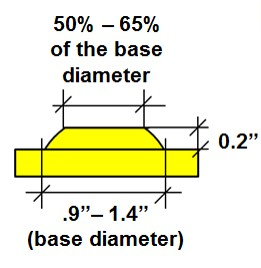


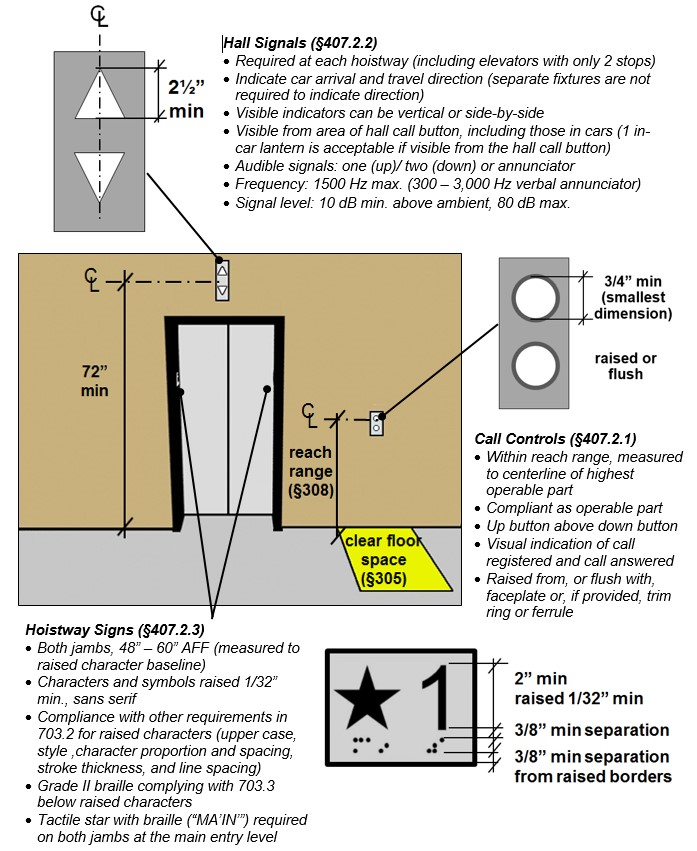
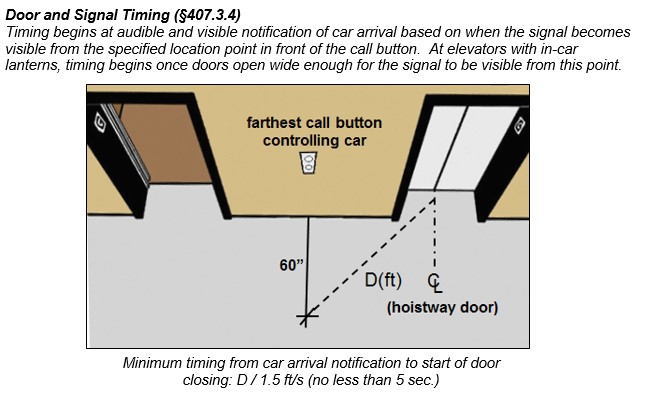
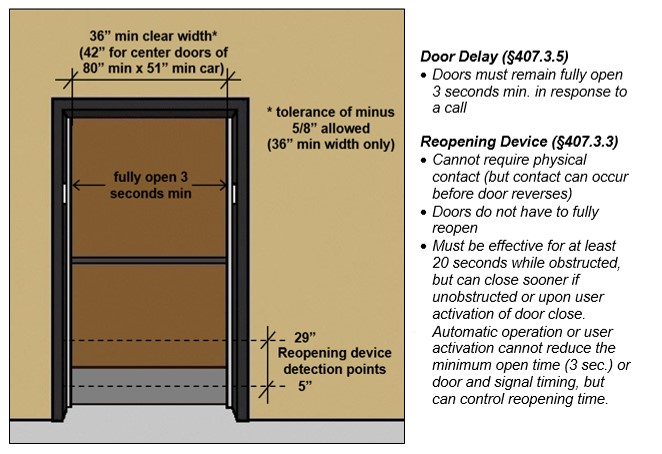
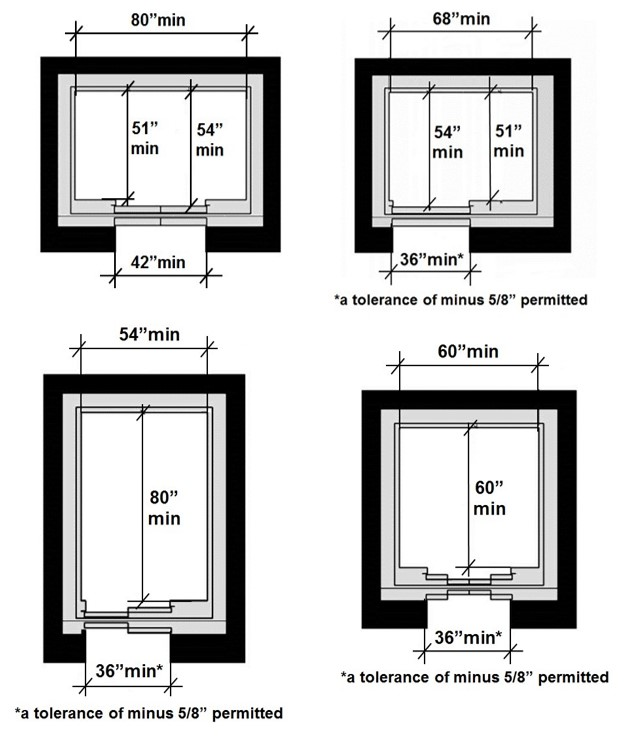
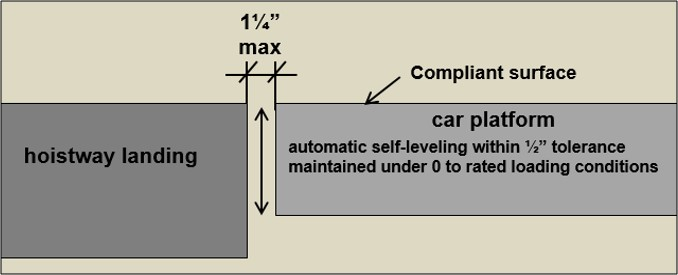
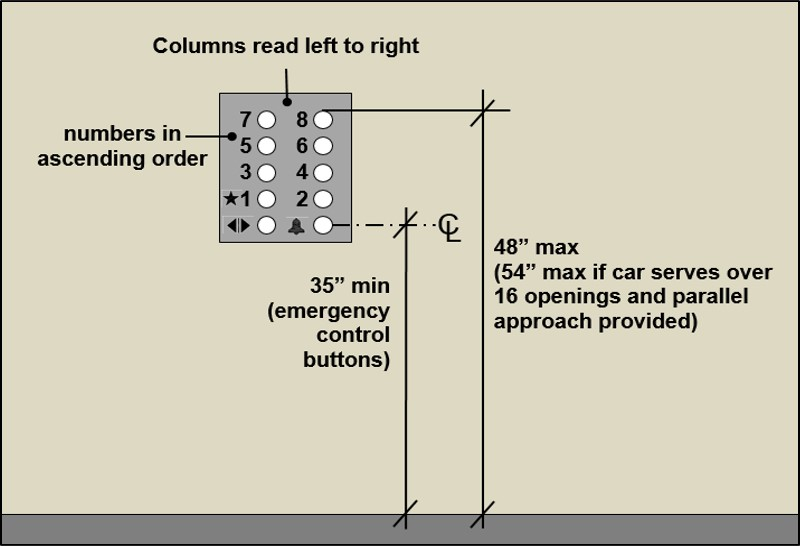
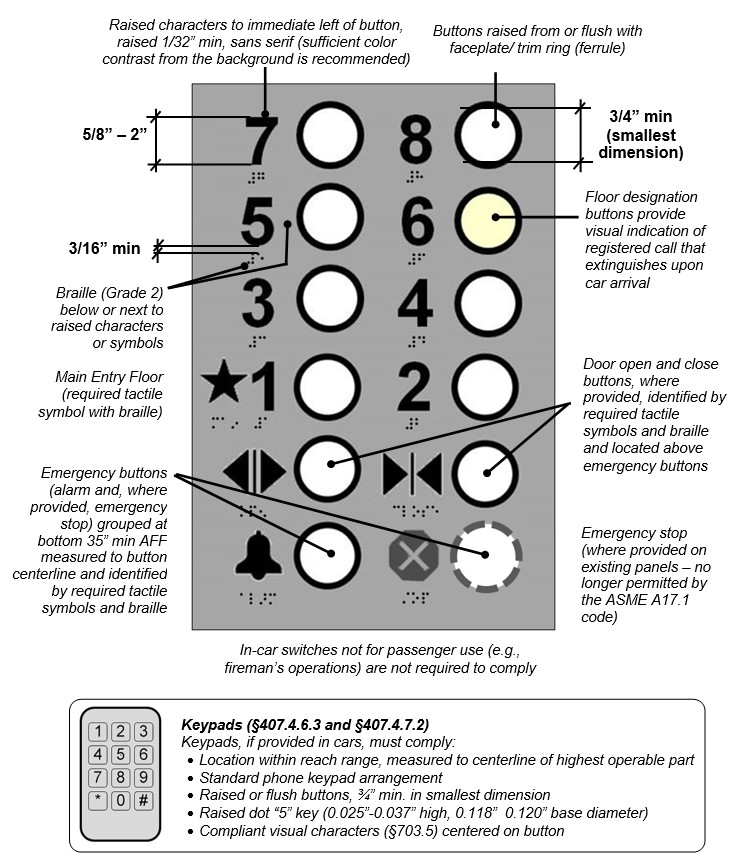
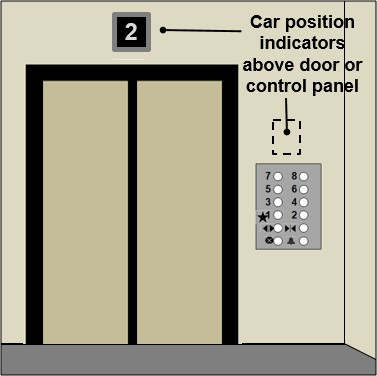
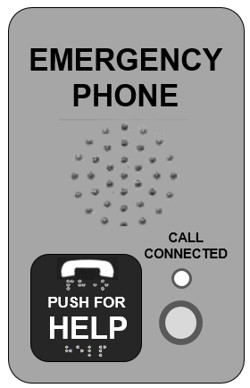
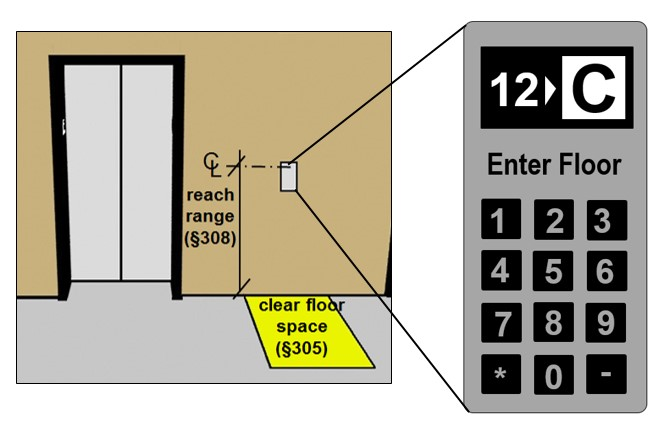
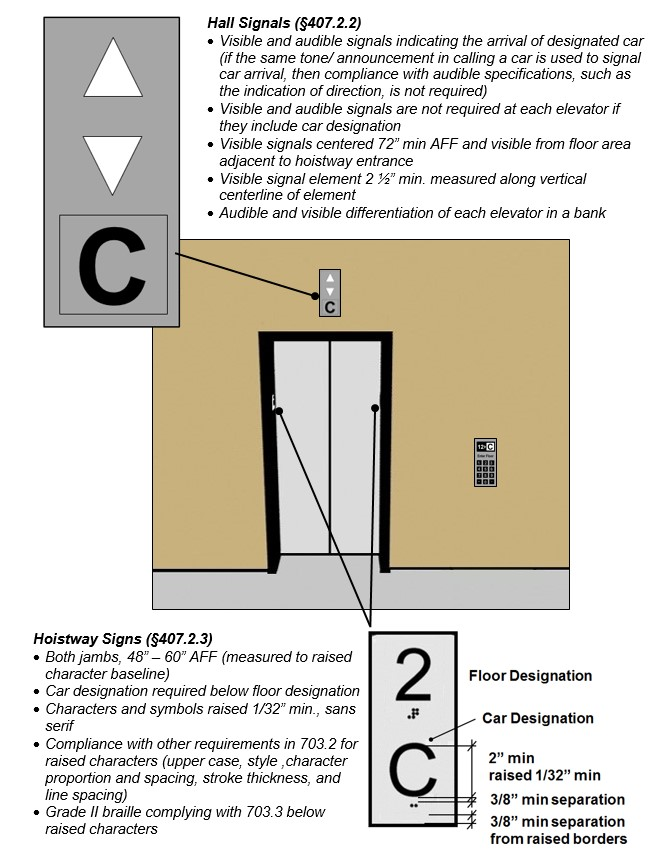

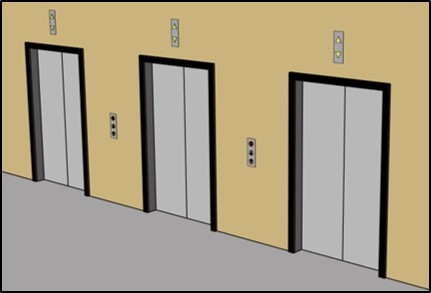
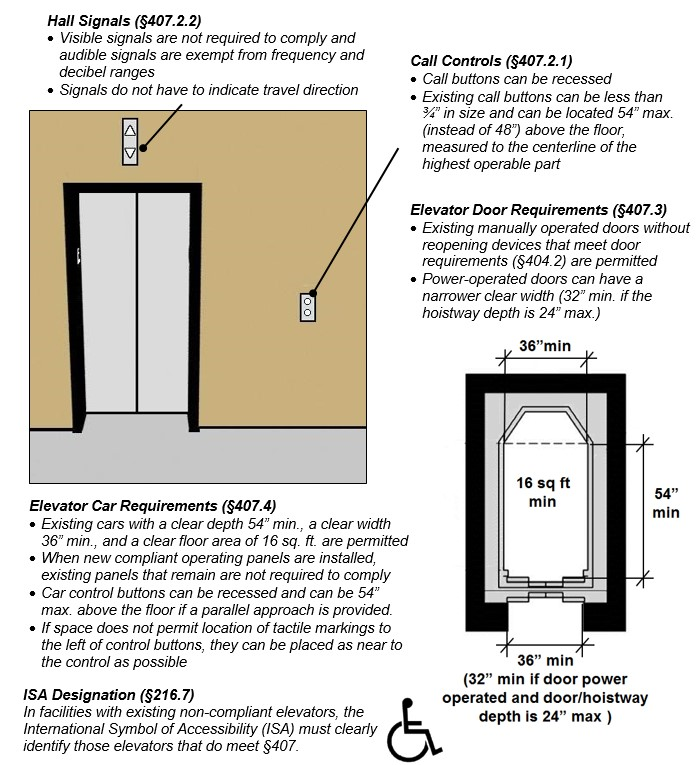

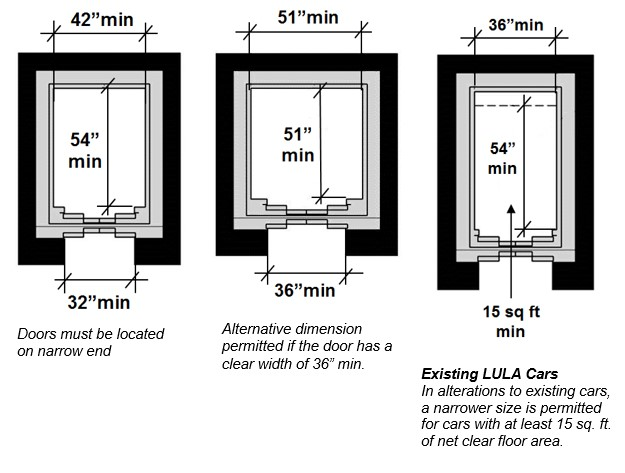
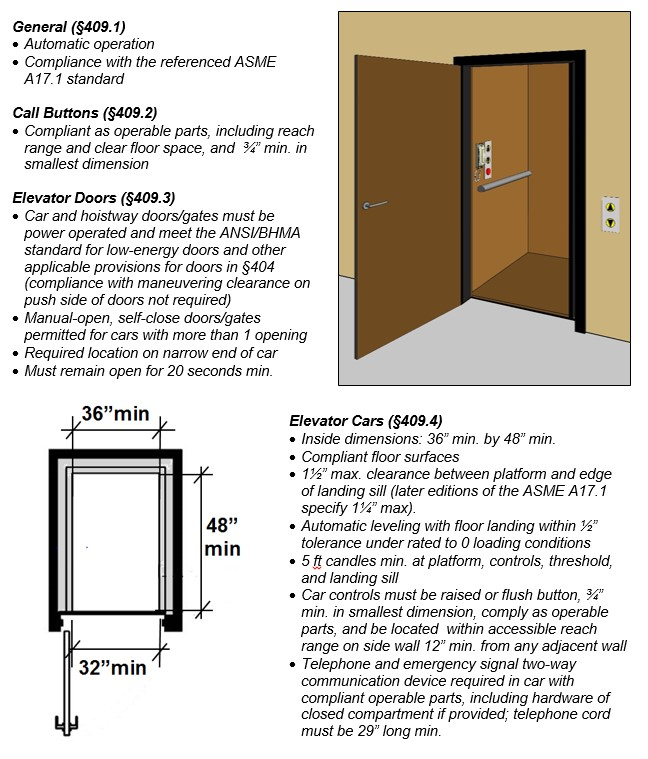

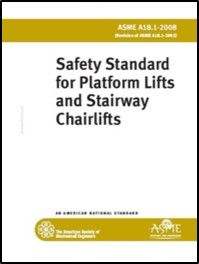
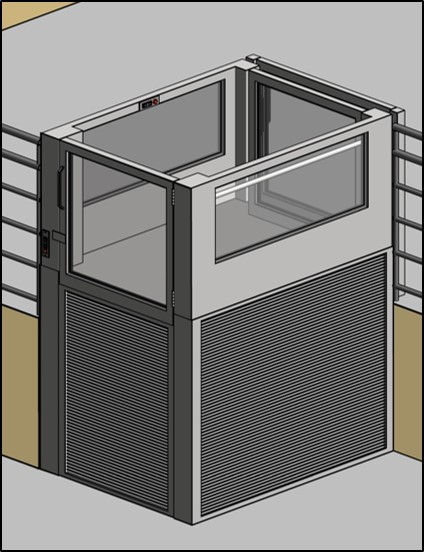
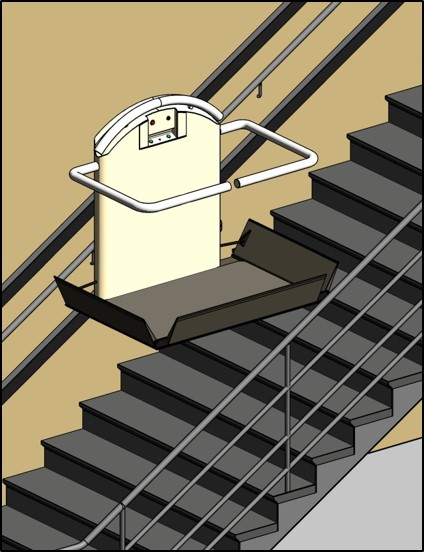
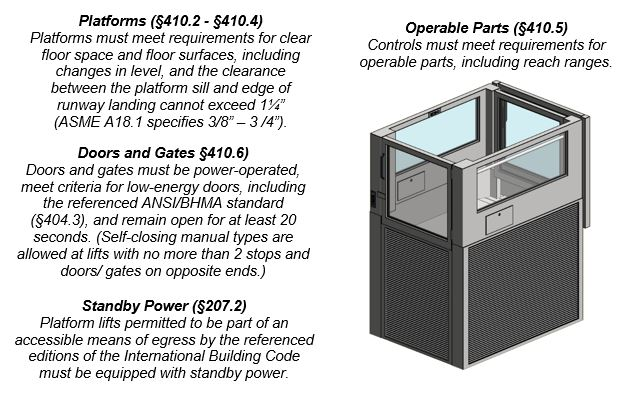
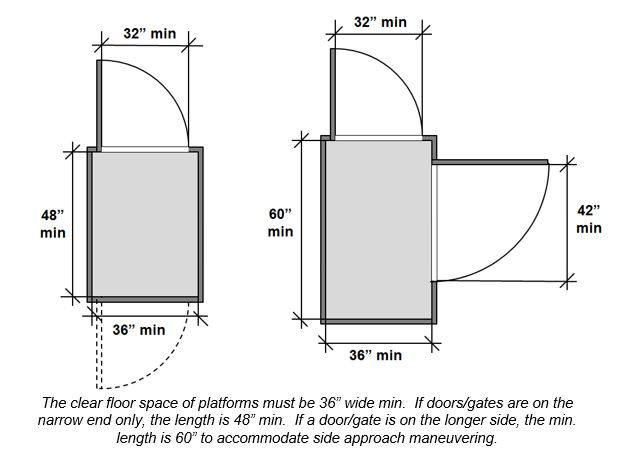




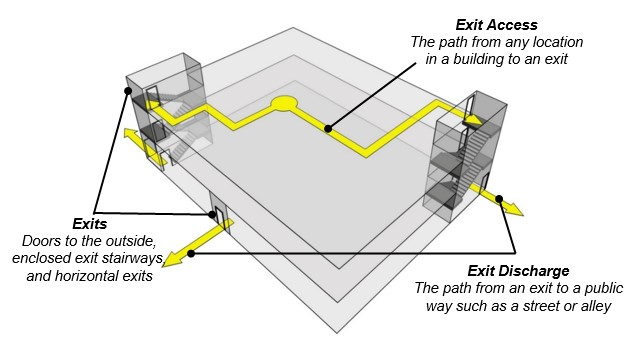
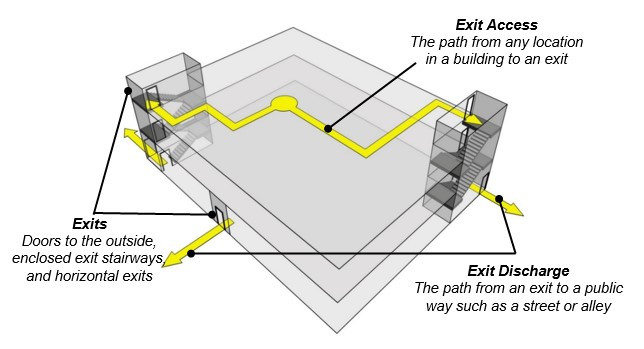
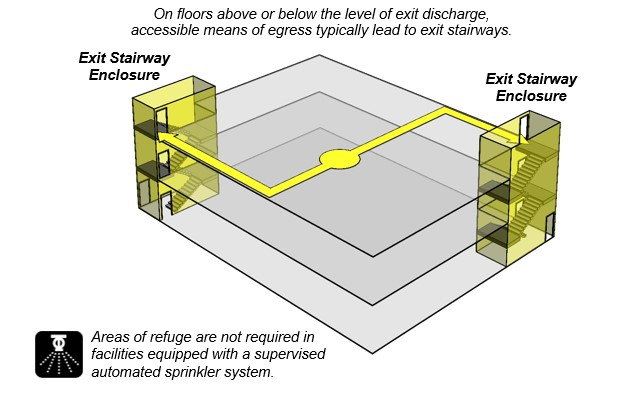
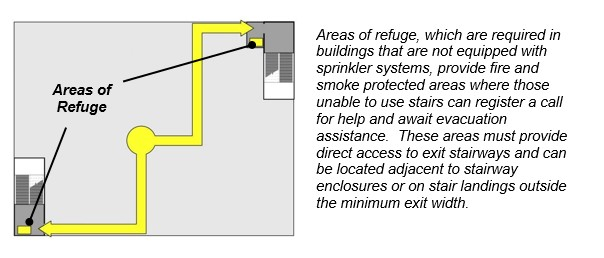

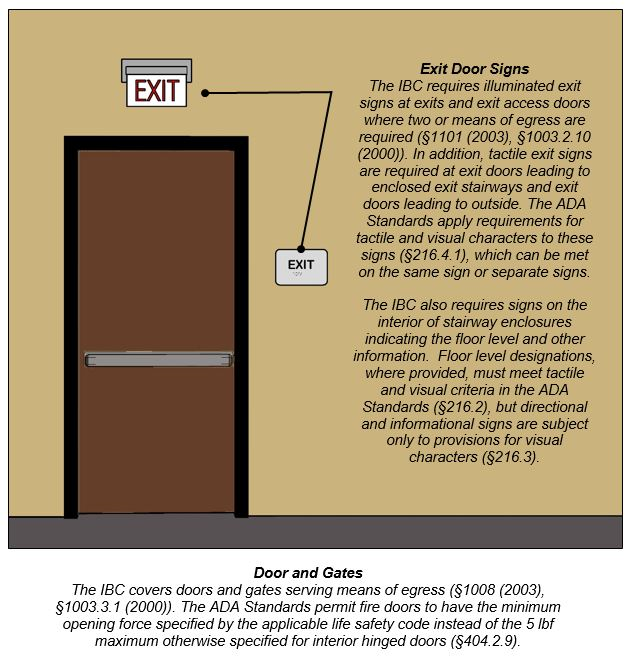

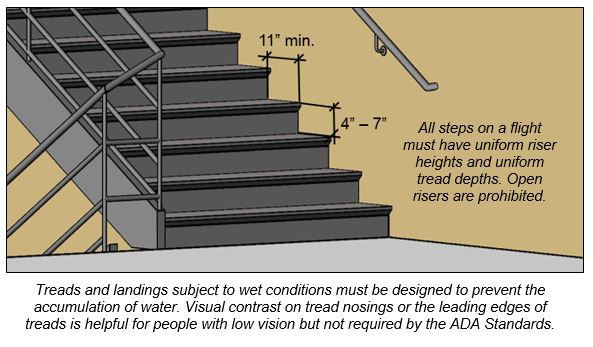
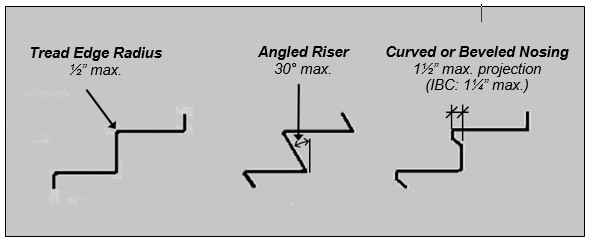
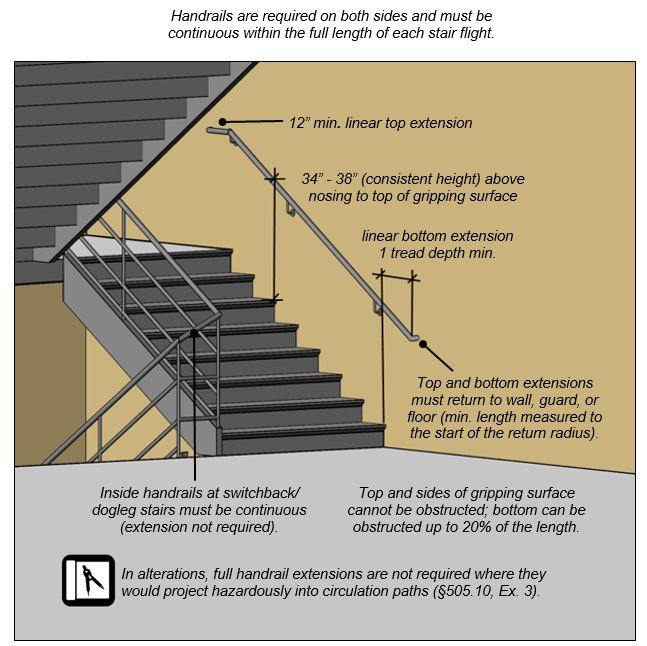
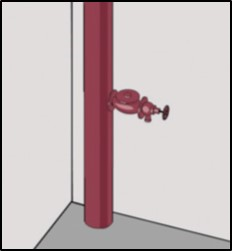
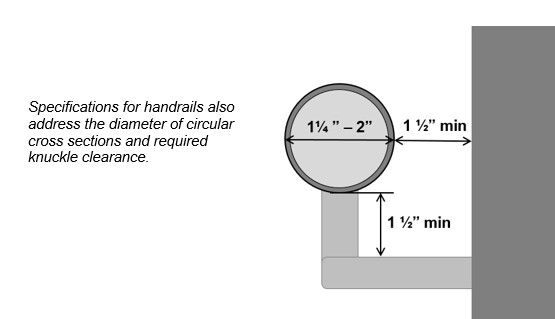
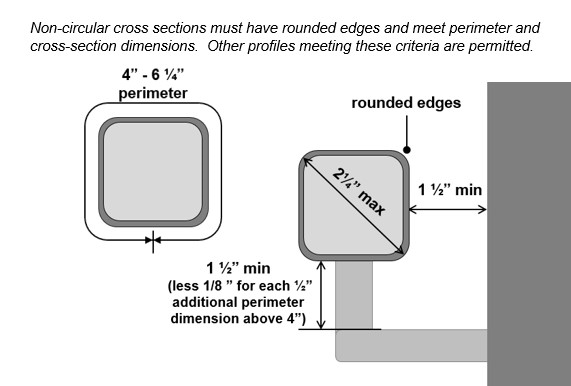
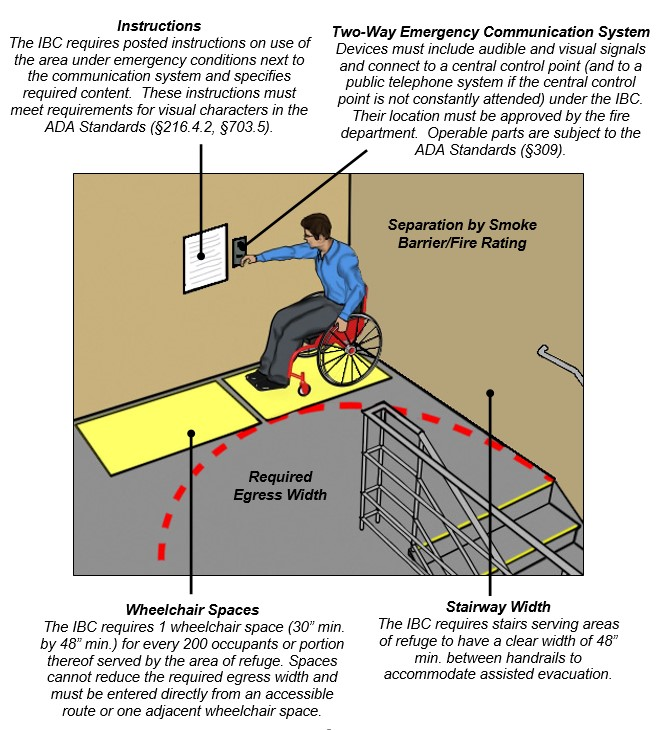
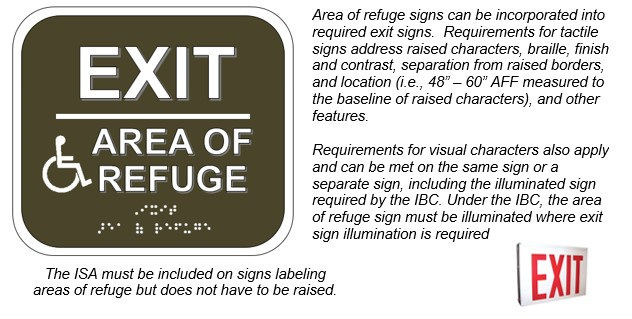
![Posted instructions next to area of refuge emergency communication device. Notes: Instructions [IBC §1007.6.4 (2003), §1003.2.13.5.4 (2000)] - The IBC requires signs in areas of refuge with two-way communication that provide: Instructions on how to use the communication system under emergency conditions; Directions to other means of egress; Indication that persons able to use the exit stairway are to do so as soon as possible, unless they are assisting others; Information on the planned availability of assistance in the use of stairs or supervised operation of elevators and how to summon such assistance; These signs must meet requirements in the ADA Standards for visual characters (§216.4.2).](/images/17048)

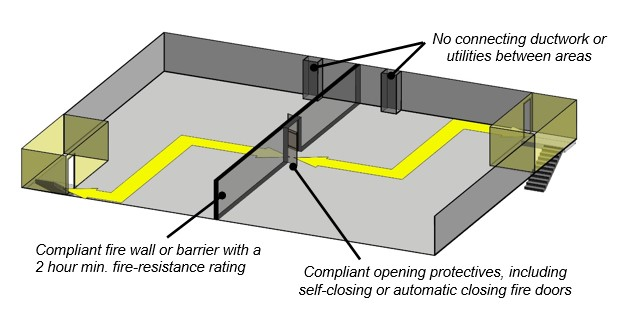
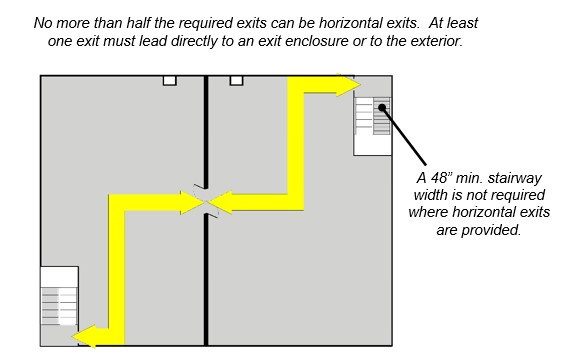
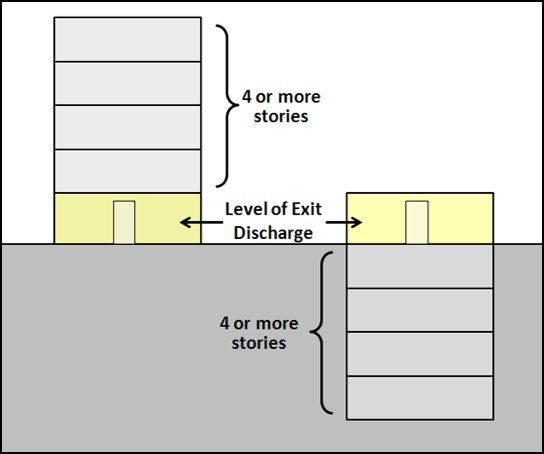
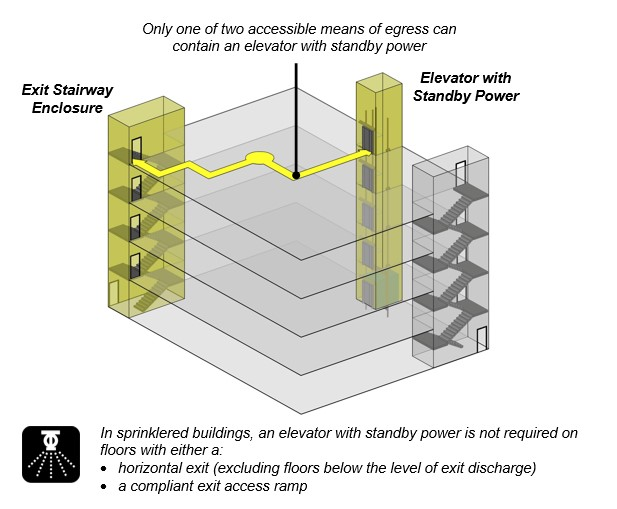
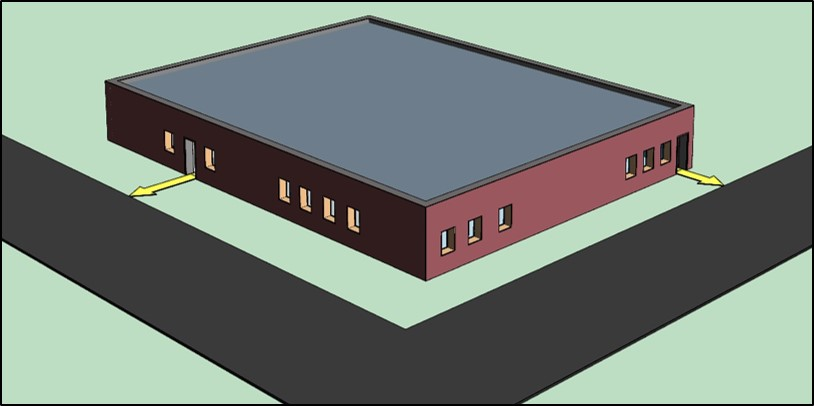
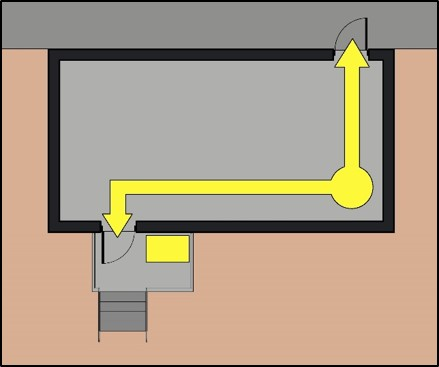
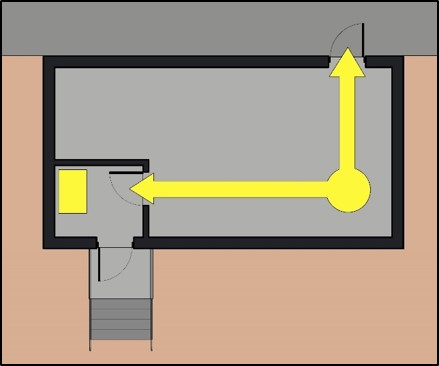
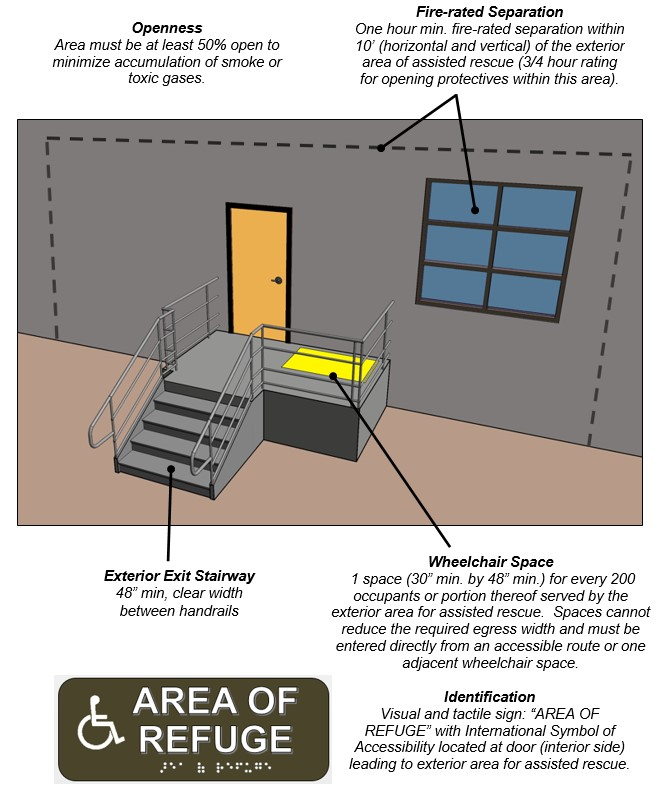

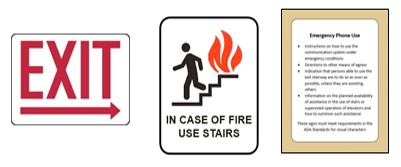
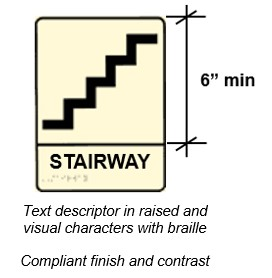

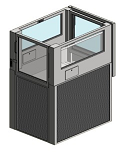
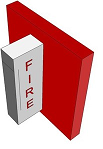
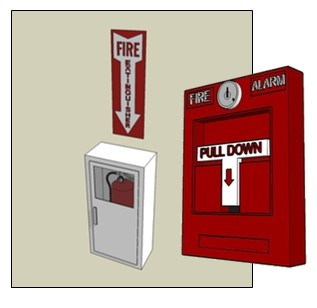
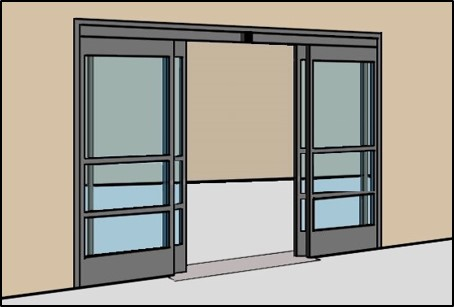


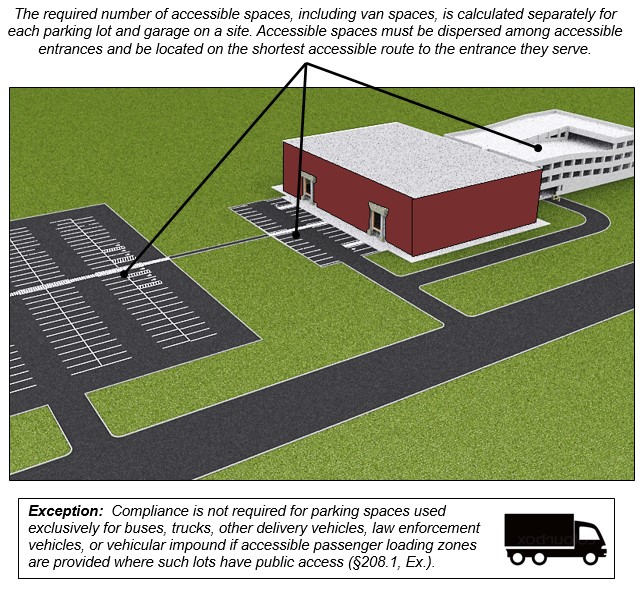

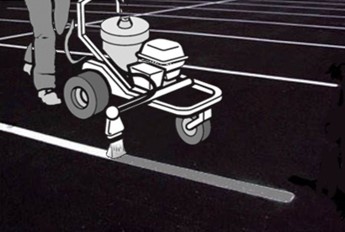
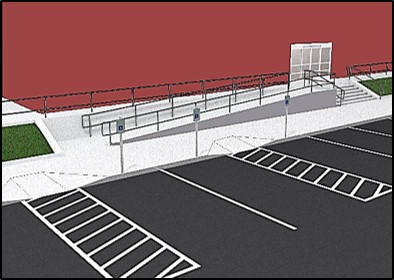
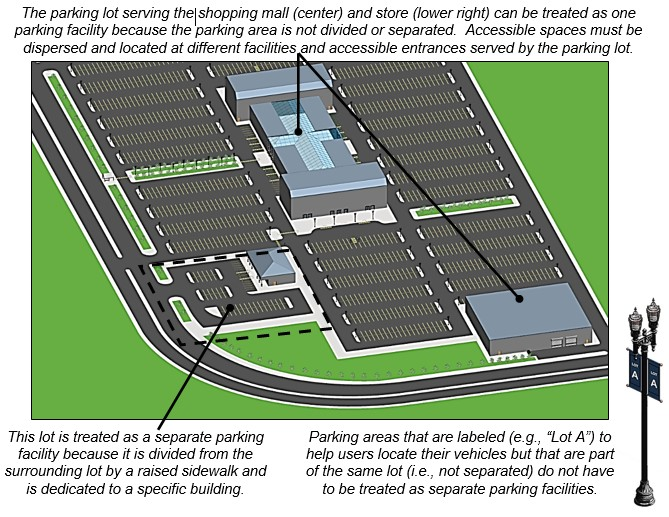

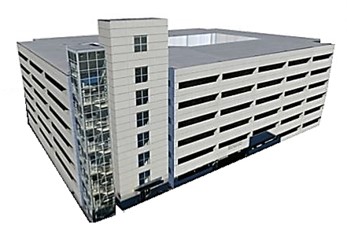
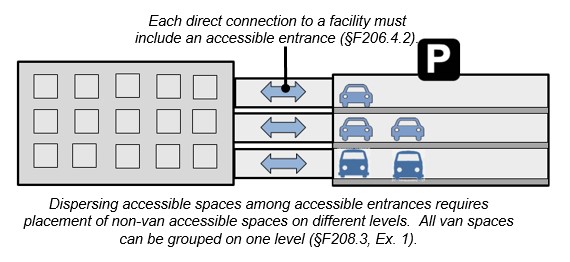

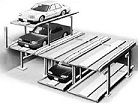
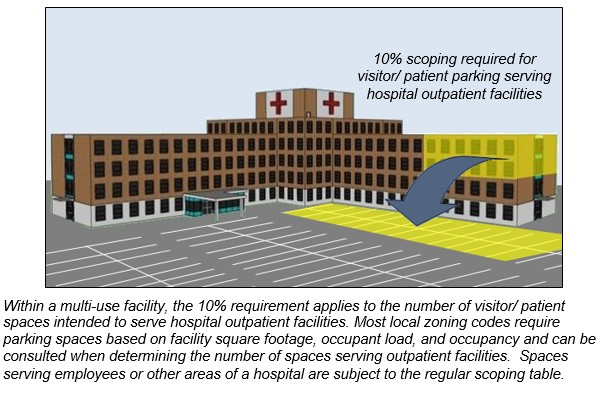

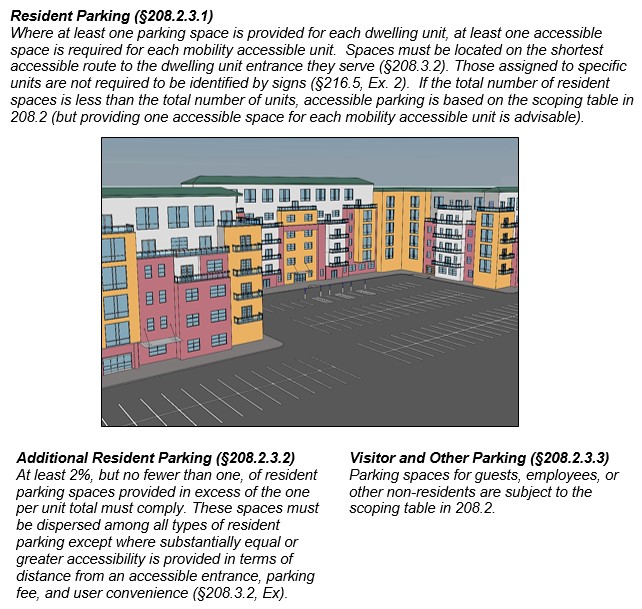
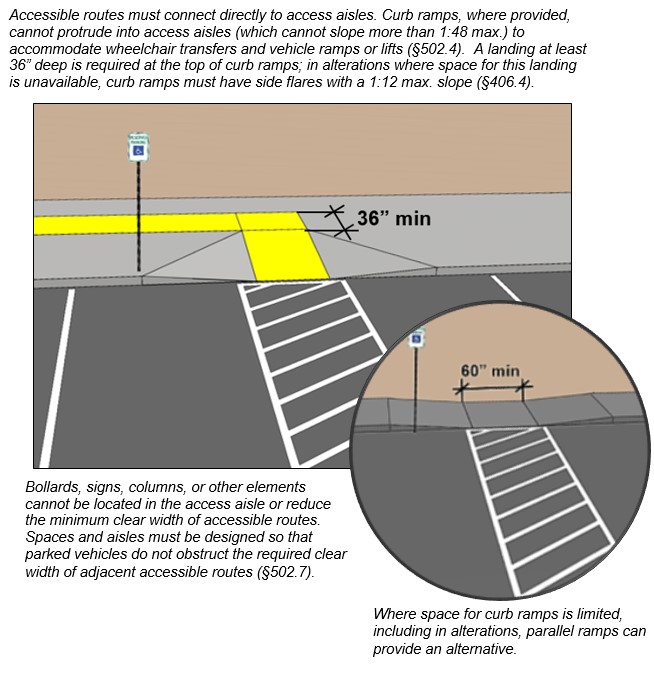

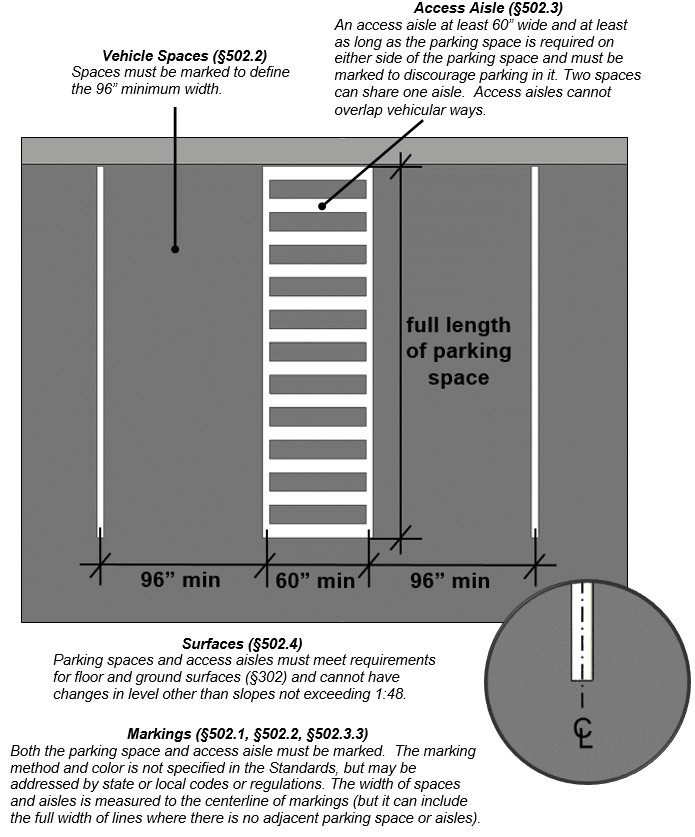
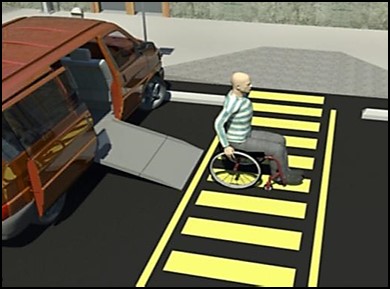
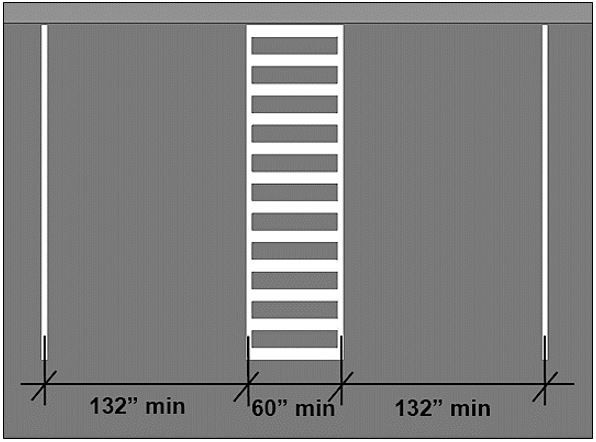

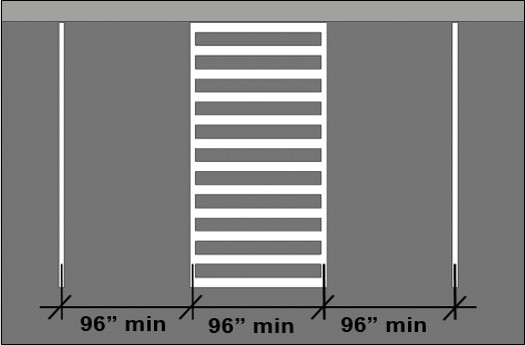
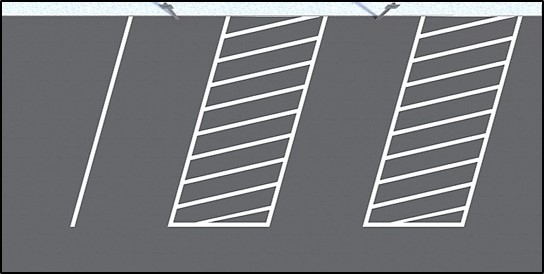

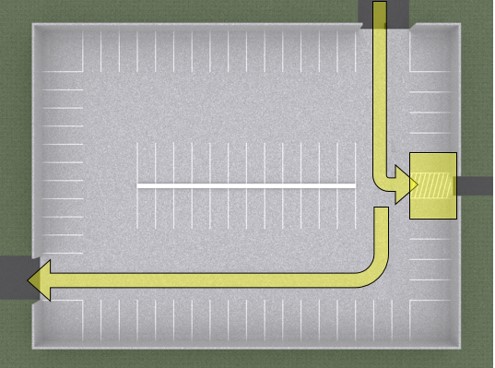

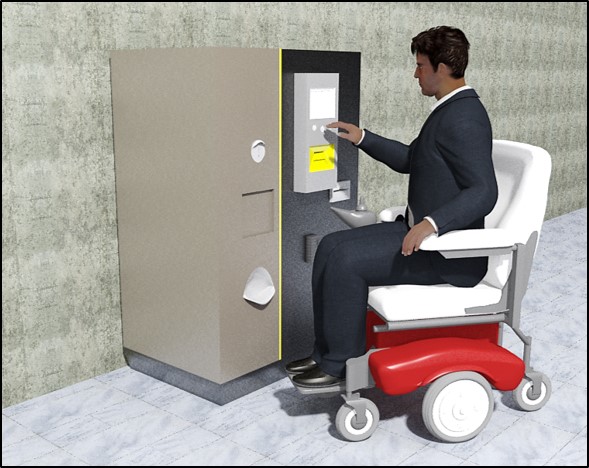
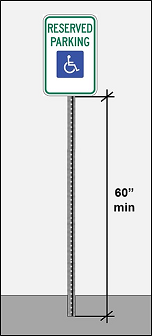

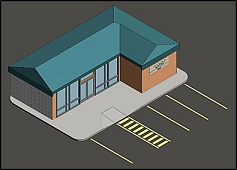


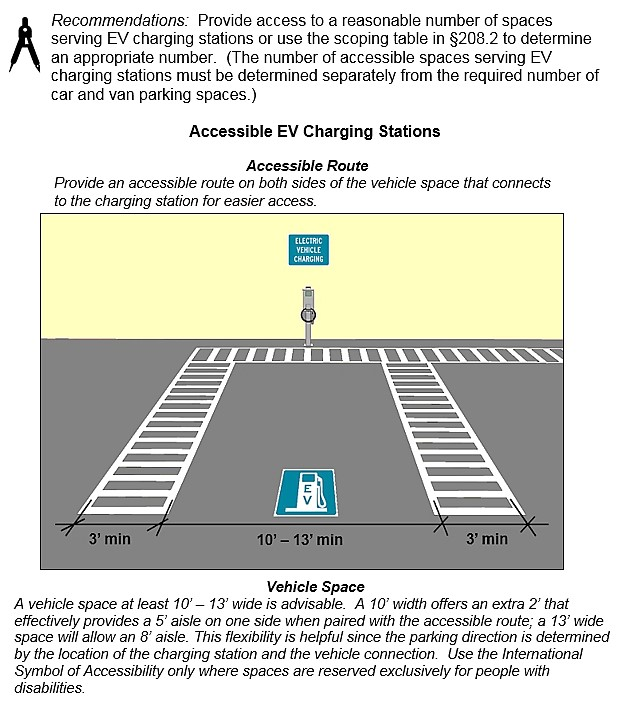


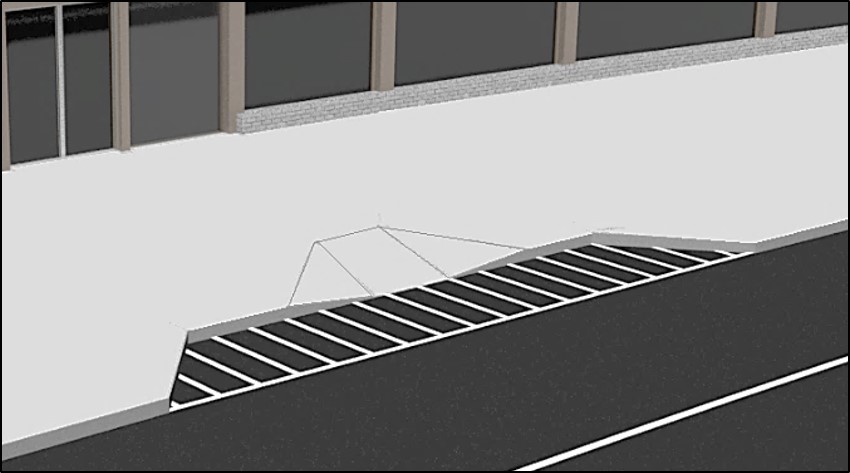

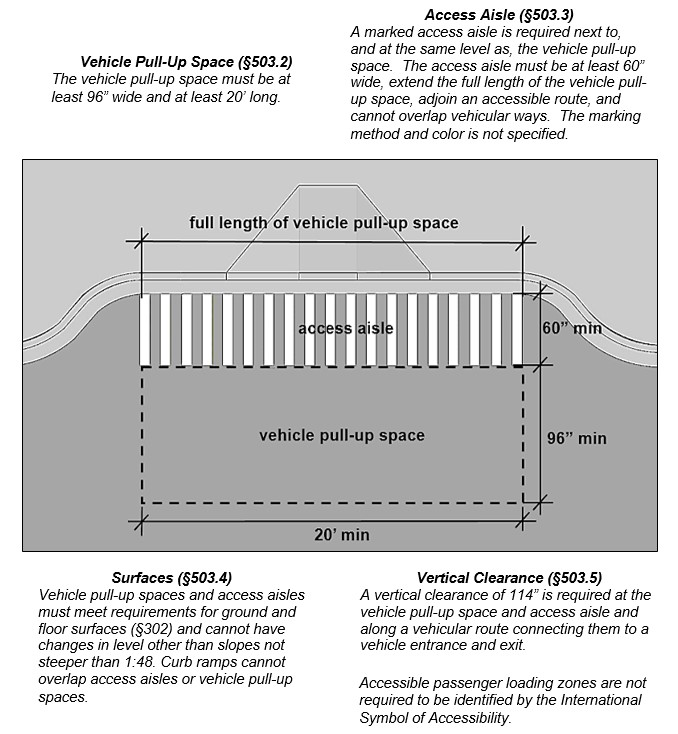


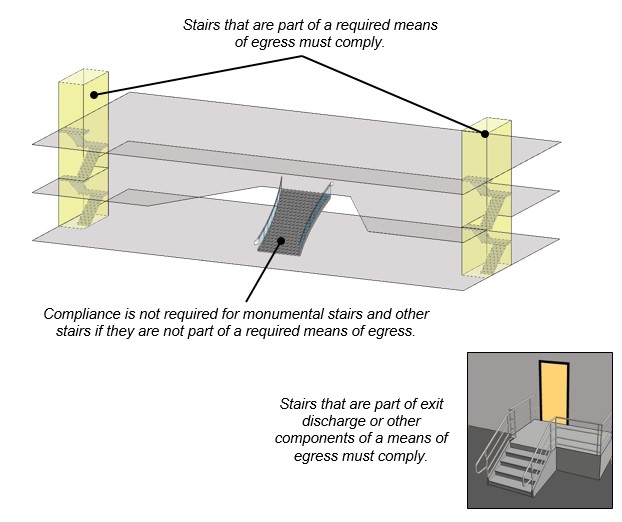
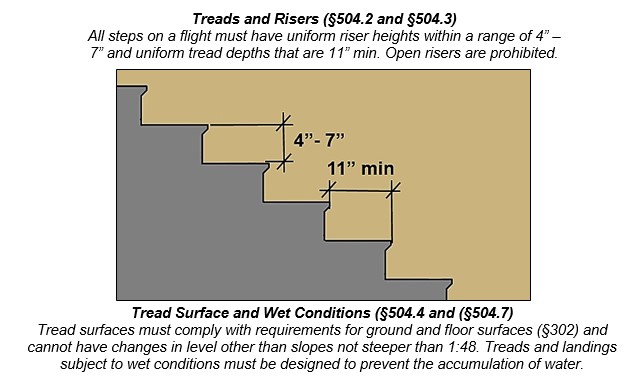
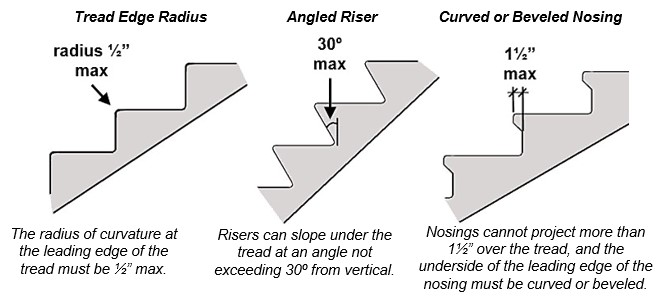

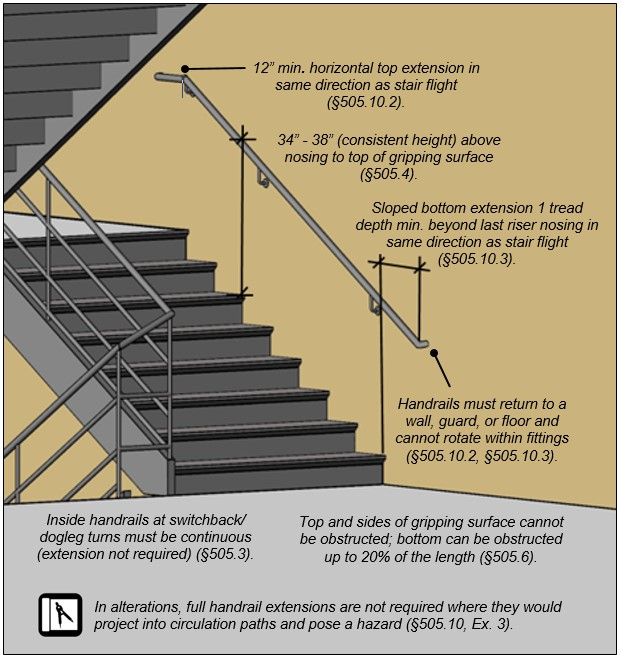

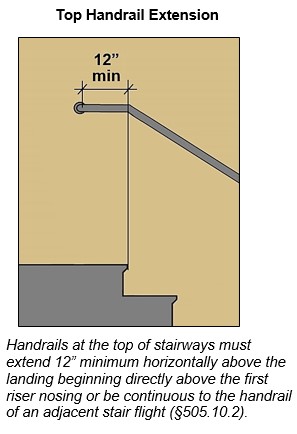
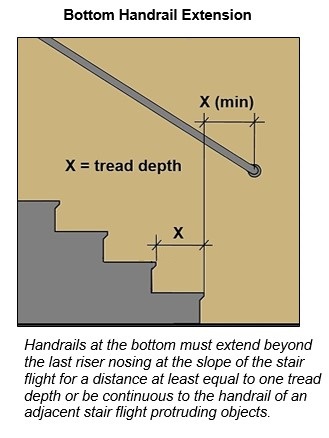
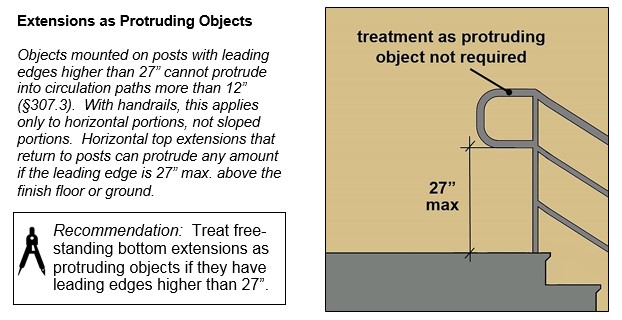
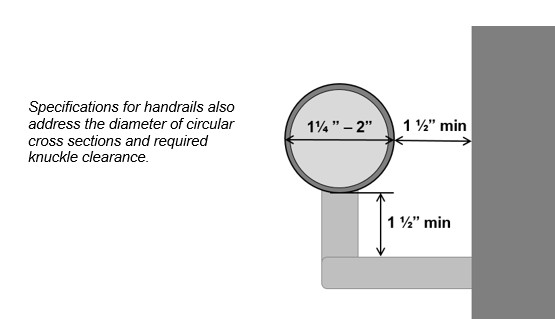
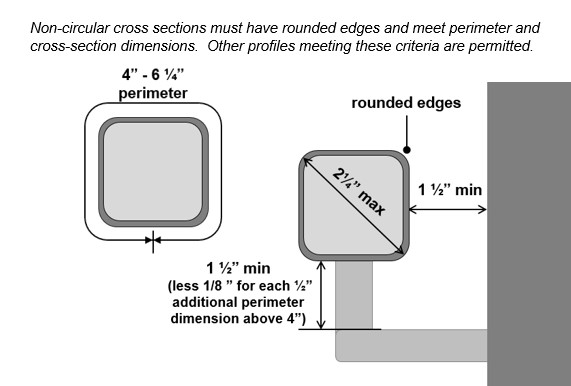




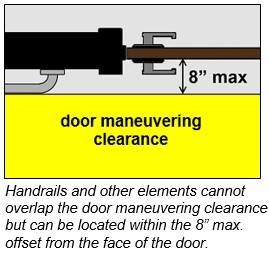
User Comments/Questions
Add Comment/Question